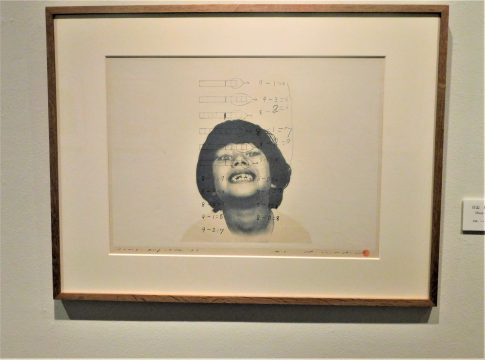https://www.culture.city.taito.lg.jp/en
【Tokyo Metropolitan Art Museum】The UKIYO-E 2020-Japan’s Three Great Ukiyo-e Collection Preview Report
Tokyo Metropolitan Art Museum
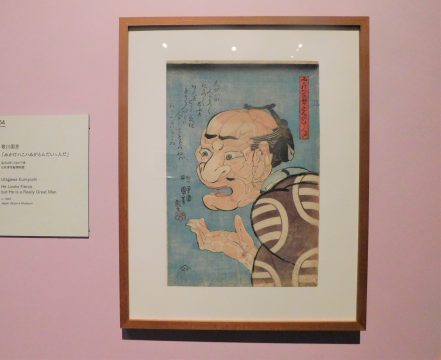
Kuniyoshi Utagawa “Apparent Hakoha ga Todai Ijin” Japanese Ukiyo-e Museum, first half exhibition
From Thursday, July 23, 2020, “The UKIYO-E 2020-Japan’s Three Great Ukiyo-e Collection” is being held at the Tokyo Metropolitan Art Museum (Until September 22 (Tuesday/holiday)) *Works may be replaced in the first and second semesters)
There was a press preview of this exhibition the other day.
In this article, we will introduce the exhibition, highlights, the composition of the exhibition, and the works featured by the editorial department.
See it!
What is “The UKIYO-E 2020-Japan’s Three Great Ukiyo-e Collection”?
The “The UKIYO-E 2020-Japan’s Three Great Ukiyo-e Collections” held at the Tokyo Metropolitan Art Museum is no exaggeration to say that it is Japan’s three major Ukiyo-e collections. The Ota Memorial Museum, the Japanese Ukiyo-e Museum, and the Hiraki Ukiyo-e Foundation The collection of Ukiyo-e masterpieces in the collection will be displayed in the first and second semesters, with approximately 450 selected masterpieces of Ukiyo-e prints.
You can fully enjoy the charm of Ukiyo-e, a genre of art that represents Japan and was loved by the common people of the Edo period.

Five highlights of “The UKIYO-E 2020-Japan’s three major Ukiyo-e collections”
There are five highlights of ” The UKIYO-E 2020- Japan’s Three Great Ukiyo-e Collection.”
(1 ) This is the first exhibition in history that brings together the three major Ukiyo-e collections.
(2) Representative works of about 60 artists who will exhibit the history of Ukiyo-e will be released at once.
③ Of the approximately 450 items exhibited, 100 or more of important cultural properties and art pieces will be exhibited.
④ There are many gems in the collection, such as the only remaining work in the world.
⑤ We will be exhibiting the super famous works Hokusai Katsushika “Thirty-six Views of Tomitake” and Hiroshige Utagawa “Five-three Tokaido Roads” throughout the year.
-
Composition of each chapter and featured works by the editorial department
Chapter 1 Early Ukiyo-e
The early Ukiyo-e prints started with the “Sumizuri-e”, which is a black-and-white plate from the Enpo era (1673-81).
After that, “Tan-e” (tane), which was colored by brushing sumi-suri mainly on red, “red” (red) instead of red, “red-painted” (black), black By mixing glue on the part, a glossy “lacquer picture” was created.
Around the Enkai period (1744-48), plate coloring with red and green color plates was performed, and it was named “Benizuri-e” (Benizurie). Establish
In the first chapter, the works of painters from the early days of Ukiyo-e, Hishikawa Morinobu, Kagetsudo school, Masanobu Okumura, Kiyonobu Torii and Kiyobe are exhibited.
[Editor’s Featured Works]
● Hishikawa Moronobu “Young people and daughters”
This is a work by Morinobu Hishikawa, the founder of Ukiyo-e prints, depicting men and women who nestle by the partition.
The simple line drawn in a frame like arabesque and the yellow and red colors painted on the line draws attention.
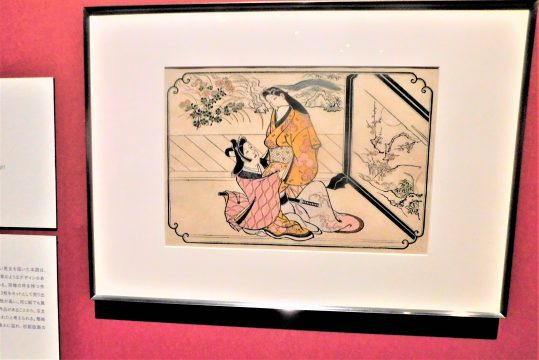
● Kaigetsudo Toshige “Standing Beauty”
This is a work by Kagetsuge Toshige, who is said to have the largest number of prints among the Ketsugetsu school that mainly draws hand-painted drawings.
I draw a full screen of a woman standing in front of a kimono.
The dignified appearance of a woman is truly a standing beauty.
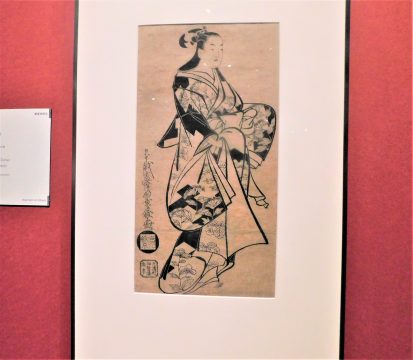
●Toshinobu Okumura “Oshichi and Yoshizo”
It is a work depicting the story of Ochichi and Kichisaburo, who was adapted to Joruri and Kabuki.
It captures the appearance of a greengrocer Oshichi handing a love letter t o Yoshisaburo
It is famous that the second character Sanjo Kantaro played the role of Seven in order to improve Kiyosaburo Arashi, and in subsequent performances, the seventh character came to use Kisaburo Arashi’s standard pattern.
Yoshisaburo of this work can see the crest of the second generation Nanasaburo Nakamura in the costume, but he could not find the Kyogen that Nansaburo played Kisaburo at that time.
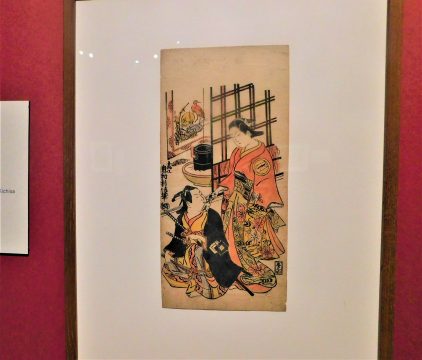
Chapter 2 The birth of Nishiki-e
Around 1765, a multicolored print was born and was called “Azuma Nishikie” in the sense of a beautiful Edo-like painting.
In the second chapter, works by Harunobu Suzuki, Ryusai Isoda, Ippushisai Buncho, and Haruaki Katsukawa, which were most active in the era of Nishiki-e, were exhibited.
[Editor’s Featured Works]
●Harunobu Suzuki “Eight Scenes of the Furyu”
This work is associated with the traditional Chinese landscape painting title, Shosho Hakkei.
It depicts a scene from the story of the “potted tree,” which is associated with eight songs.
It’s just a broom that wipes off the snow on the roof, but its appearance is elegant and has an atmosphere.
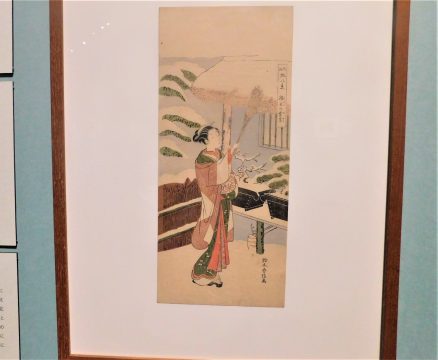
● Haruaki Katsukawa “The first generation Nakamura Nakazo Ota Kotota 3rd generation Koji Otani Chuta Banba”
A scene from Nakamuraza’s “Omezome Soga Hinagata”
It is depicted that two of the first generation Nakamura Nakazo, Kota Omi, and the third generation Koji Otani, Tadashi Banba, make a dark match.
The heat of the actors who perform with a screaming expression is transmitted to the skin.
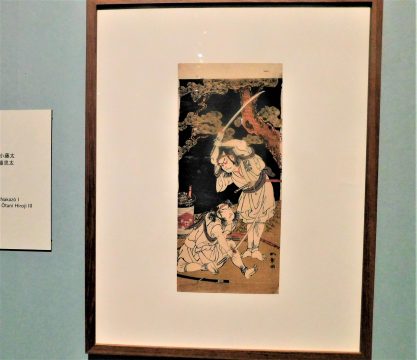
Chapter 3 Development of Bijin-ga and actor paintings
During the Tenmei period (1781 to 89), Kiyocho Torii created a graceful and tall beauty painting style and produced many group images.
During the Kansei period (1780-1801), Kitagawa Utamaro drew women of various levels.
Tohsusai Sharaku is a painter who has suddenly disappeared within just one year from May 1794 (Kansei 6), but is internationally acclaimed.
In the third chapter, works by Kiyocho Torii, Utamaro Kitagawa, Sharaku Tosusai and Toyokuni Utagawa are exhibited.
[Editor’s Featured Works]
● Kiyonaga Torii “Yusuzumi Okawabata”
This work depicts women who enjoy the cool breeze at the riverside.
This is the first exhibition in 40 years.
Summer in Edo begins at the river opening on May 28th.
What do you see in front of the sight of enjoying the summer with a teahouse girl with a tea cup on the left, a woman with a fan in the center, and women with one foot on the right?
*The downstream of the Sumida River was known as Okawa at that time.
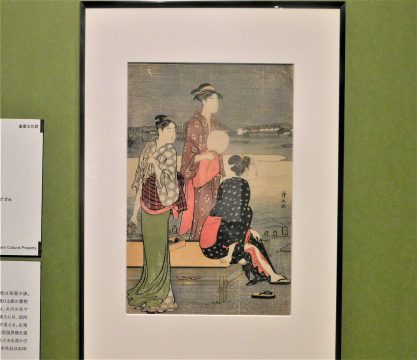
●Utamaro Kitagawa “Five beautiful women love and respect competition Matsubaya Kisegawa”
The Five-Person Beauty Love Race is a collection of all five figures depicting a beautiful woman who is famous in Edo.
You will be fascinated by the beautiful Edo beauty who is well-established.
The suppleness of the fingers of a woman with her hand on her chin is also impressive.

● Tosusai Sharaku “Hangoro Sakata’s third generation Mizuemon Fujikawa”
This is one of the series in which the third generation Sakata Hangoro played the role of the thirteenth anniversary of sacrifice and the third generation Sakata Hangoro played Fujikawa Mizuemon.
The mouth of Fujikawa Mizuemon, the eyes that open up, and the arms with raised blood vessels are exactly the appearance of the enemy.
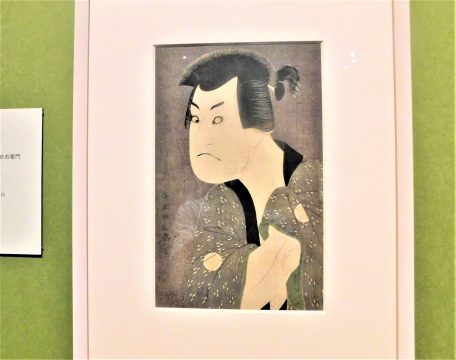
● Toyokuni Utagawa “Konoshita Tokichi of the third generation Ichikawa Yaozo”
This is a work that is said to have been portrayed by Tokichi Konoshita in the “Kaien Festival Religion” written by Yazo Ichikawa, the third generation, in 1796.
The Kien Festival Religion is a story of Tokichi Konoshita’s success in confronting the villain Daizen Matsunaga.
The eye power of Yaozo Ichikawa, the third generation of this painting, is overwhelming.
From that eye, you can feel an unusual will
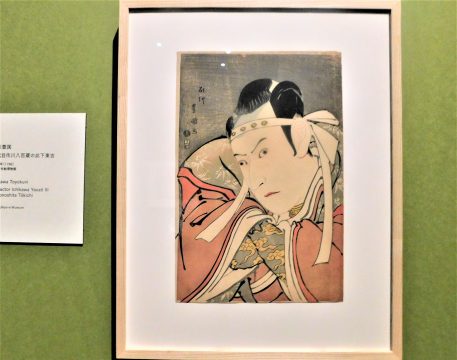
Chapter 4 Diversifying expressions
When entering the culture and Bunsei period (1804-30), Nishiki-e, which had a rough atmosphere, became more detailed and the amount of information drawn on the screen increased.
In the fourth chapter, the works of Kunikawa Utagawa Kunisada (later named Utagawa Toyokuni) and other works by Hideki Kikukawa are exhibited.
[Editor’s Featured Works]
● Eizan Kikukawa “Higashi Sugata Genji Koyoga”
In one of the assortment comprising a combination of the bust of Genji Karuta and women, it is a work depicting a daughter to read the booklet in the light of the row lights.
I was impressed by the serious expression of a woman who leaned her head and read the booklet diligently to illuminate the page.
It feels like the red of the book, the barrette and the red of the kimono are in harmony.

●Kunisada Utagawa “Komo Oil Painting, Eitai Bridge”
It is a collection of landscape paintings drawn in Western style, and among the known ones, there are five figures, “Komo oil painting style” and “Komo oil painting famous spot”, respectively, totaling 10 figures.
This work features Nagadaibashi, the fourth bridge built in the Sumida River.
A houseboat is gracefully crossing the Eidai Bridge.
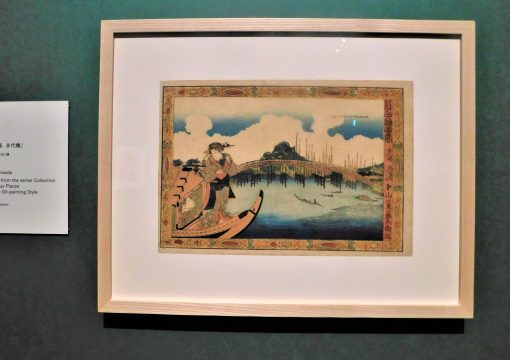
Chapter 5 World of Nature and Storytelling
Around the early Tenpo period (183-33), the “Thirty-six Views of Tomitake” series, which includes “Ukiyoe prints” by Katsushika Hokusai and “Kamikawa Oki Nanura”, will be published.
In the 4th to 5th years of the Tempo (1833-34), Hiroshige Utagawa’s masterpiece, Tokaido Gotoku Miyoshinouchi, was also produced.
In Chapter 5, works by Hokusai Katsushika, Hiroshige Utagawa, and Kuniyoshi Utagawa are exhibited.
[Editor’s Featured Works]
●Hokusai Katsushika “Thirty-six Views of Mt. Fuji Gaifukaisei”
Tomi bamboo thirty Rokukei is, by changing the location overlooking the Japan of the name Peak Fuji, is painted works.
Fuji in this work is said to have captured the northern side of Fuji from near Lake Kawaguchi.
A total of 46 figures have been produced, and the image of Hokusai Fuji will be spread throughout the world.
My heart quivers as red Mt. Fuji penetrates the sardines and rises.
You will want to see all 46 figures and compare.
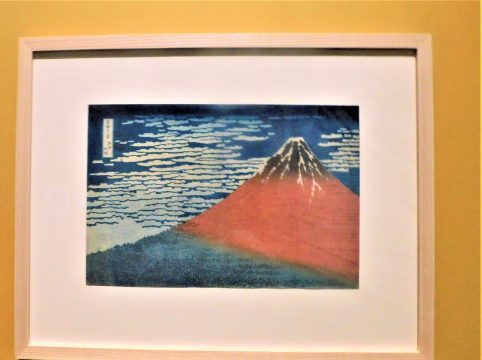
● Hiroshige Utagawa “Tokaido Gojyusantugi Mitsunouchi Hakone Lake Map”
Tokaido Gotoku Sanninouchi is a collection of masterpieces by Utagawa Hiroshige.
Consisting of 55 figures, the scenery of the journey is depicted lyrically, and the scene that changes with the season, time, and weather is expressed with a sense of reality.
This work depicts Hakone-juku, which was located between Odawara-juku and Mishima-juku, and the steep mountain path was one of the difficult points on the Tokaido.
The colors of the yellow, brown and blue mountains are colorful.
If you look at the Daimyo procession covered with a shade as you walk in the foreground, you can see the steep mountain path.
Would you like to see Mt. Fuji in the distance and rest a little?
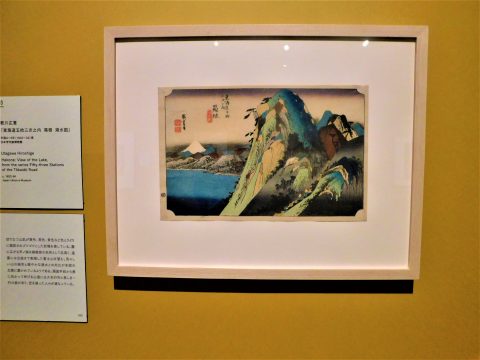
●Kuniyoshi Utagawa “It looks scary but nice”
It’s a puzzle-like caricature that gathers many humans and forms the half-length figure of one human.
I laugh at the faces and postures of each person.
The gap between the scary face and the facial expressions of the body parts is interesting.
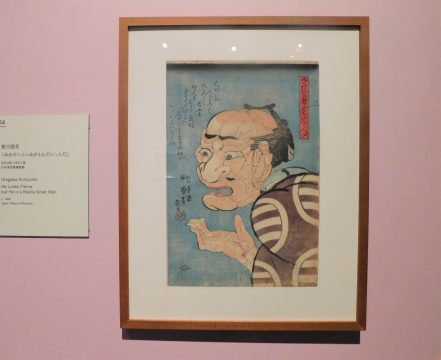
Summary
We have introduced “The UKIYO-E 2020-The Three Ukiyo-e Collection in Japan”.
This is the first exhibition in history where the three major Ukiyo-e collections in Japan are trampled.
From the first chapter to the fifth chapter, the exhibition has a volume of 455 works drawn by about 60 artists in the first and second semesters.
If you are interested, please visit the Tokyo Metropolitan Art Museum, as you will rarely have the chance to appreciate the wonderful Ukiyo-e.
There are a lot of points, so you may want to look at the work of the artist you are looking for first, and then carefully look at the other works.
* At the venue, as a measure against the new coronavirus, we ask for temperature measurement and disinfection of fingers.
Thoroughly disinfect your hands, wear a mask, and keep your social distance to avoid crowds.
-
Event outline
Exhibition name: The UKIYO-E 2020-Japan’s three largest ukiyo-e collections
■Period: July 23, 2020 (Thurs./holiday) to September 22, 2020 (Tue./holiday)
First semester: Thursday, July 23rd to Sunday, August 23rd Second semester: Tuesday, August 25th to Tuesday, September 22nd
(*All works will be switched in the first and second semesters *Admission system with specified date and time)
■ Venue: Tokyo Metropolitan Art Museum Exhibition Room
■Opening hours:9:30-17 :30
■Closed days: Monday 17th August, Monday 24th August, Monday 7th September, Monday 14th September
■ Viewing fee:
*This exhibition has a designated date and time. For details, visit the official website of the exhibition ( https://ukiyoe2020.exhn.jp)
*Free for junior high school students and younger, and those with a physical disability certificate, love certificate, nursing certificate, mental illness health welfare certificate, and A-bomb survivor’s health certificate and their accompanying person (up to 1 person) Free application is required)
*Please bring proof of all
■ Exhibition official website: ( https://ukiyoe2020.exhn.jp)
The souls of the free artists approach the heart. 【The University Art Museum, Tokyo University of the Arts】”Art as it is-people who continue to express without knowing-” preview report
The University Art Museum, Tokyo University of the Arts
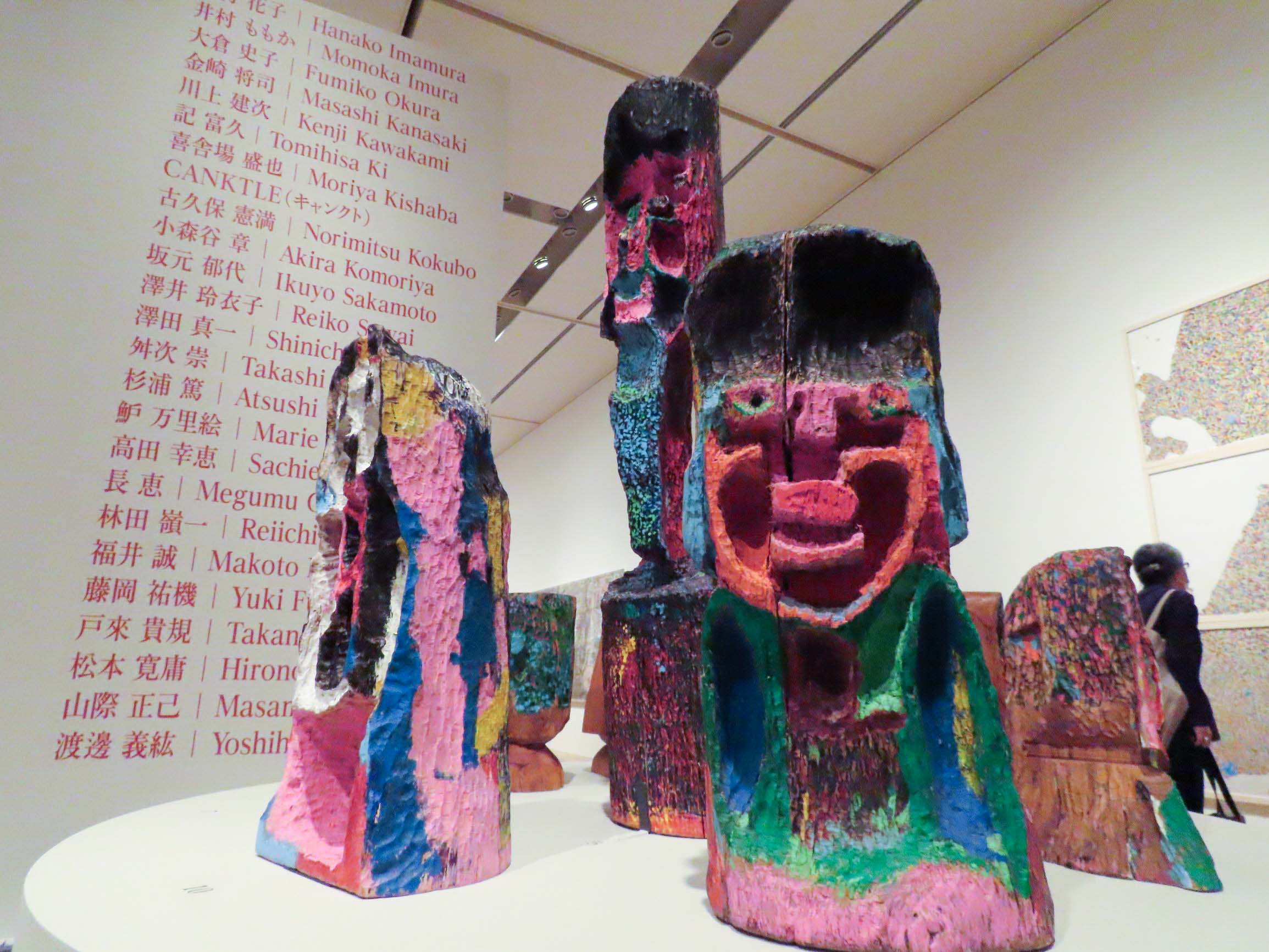
From Thursday, July 23, 2020 to Sunday, September 6, 2020, a special exhibition “Art as it is- people who continue to express without knowledge” is being held at the Museum of Art, Tokyo University of the Arts. The other day, a media preview was held, so I will tell you about it.
“Arugama” works full of humanity
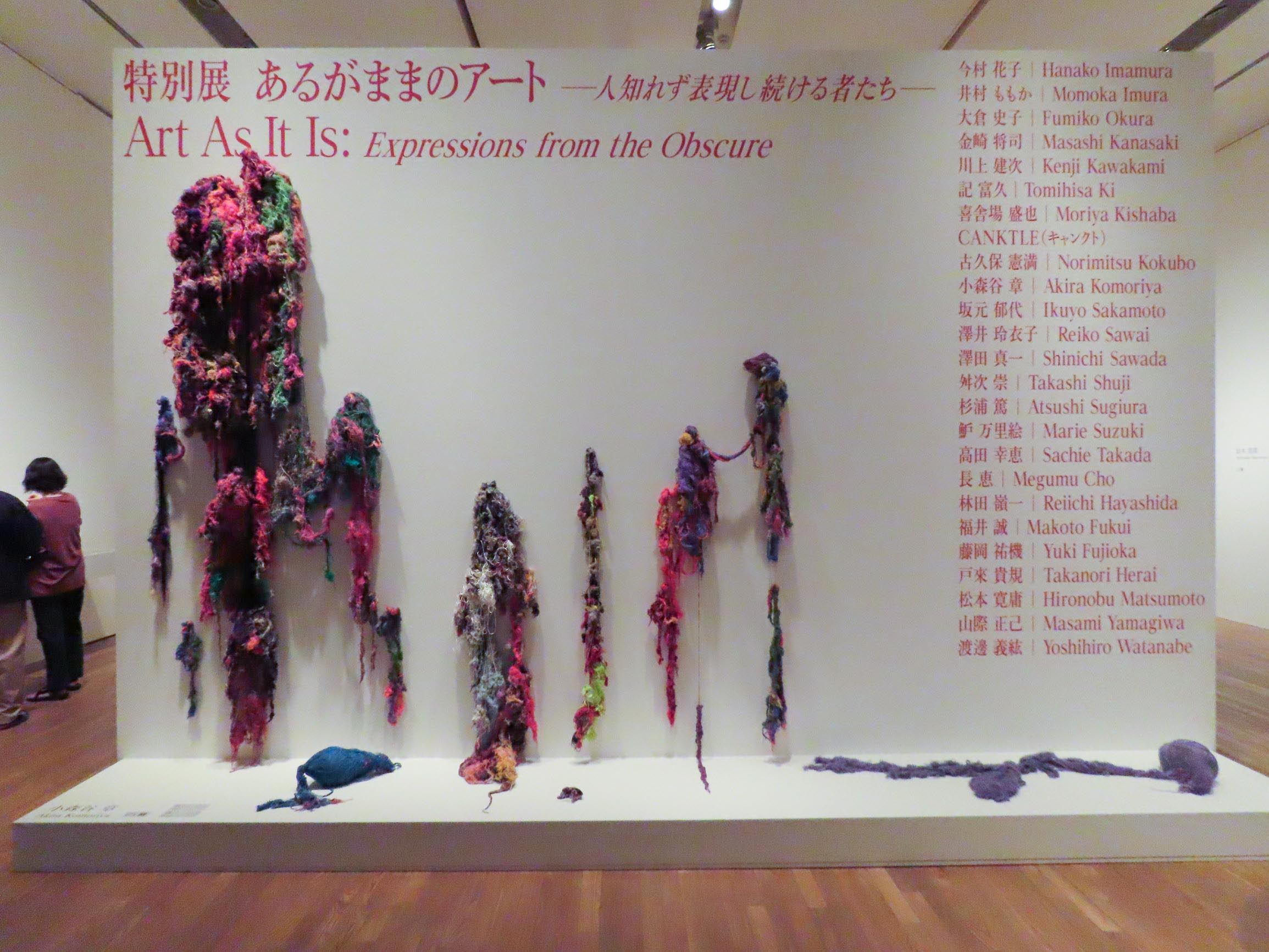
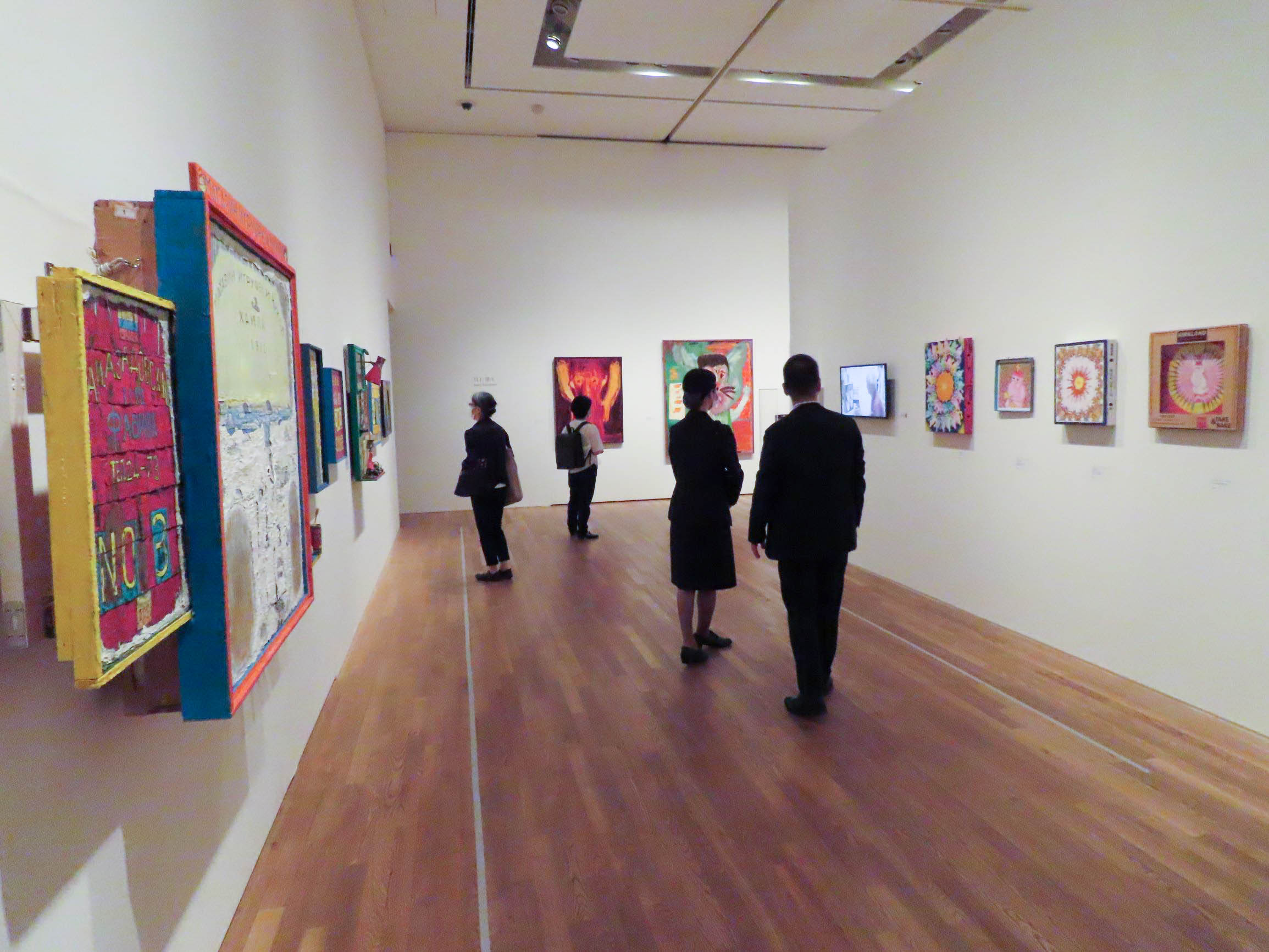
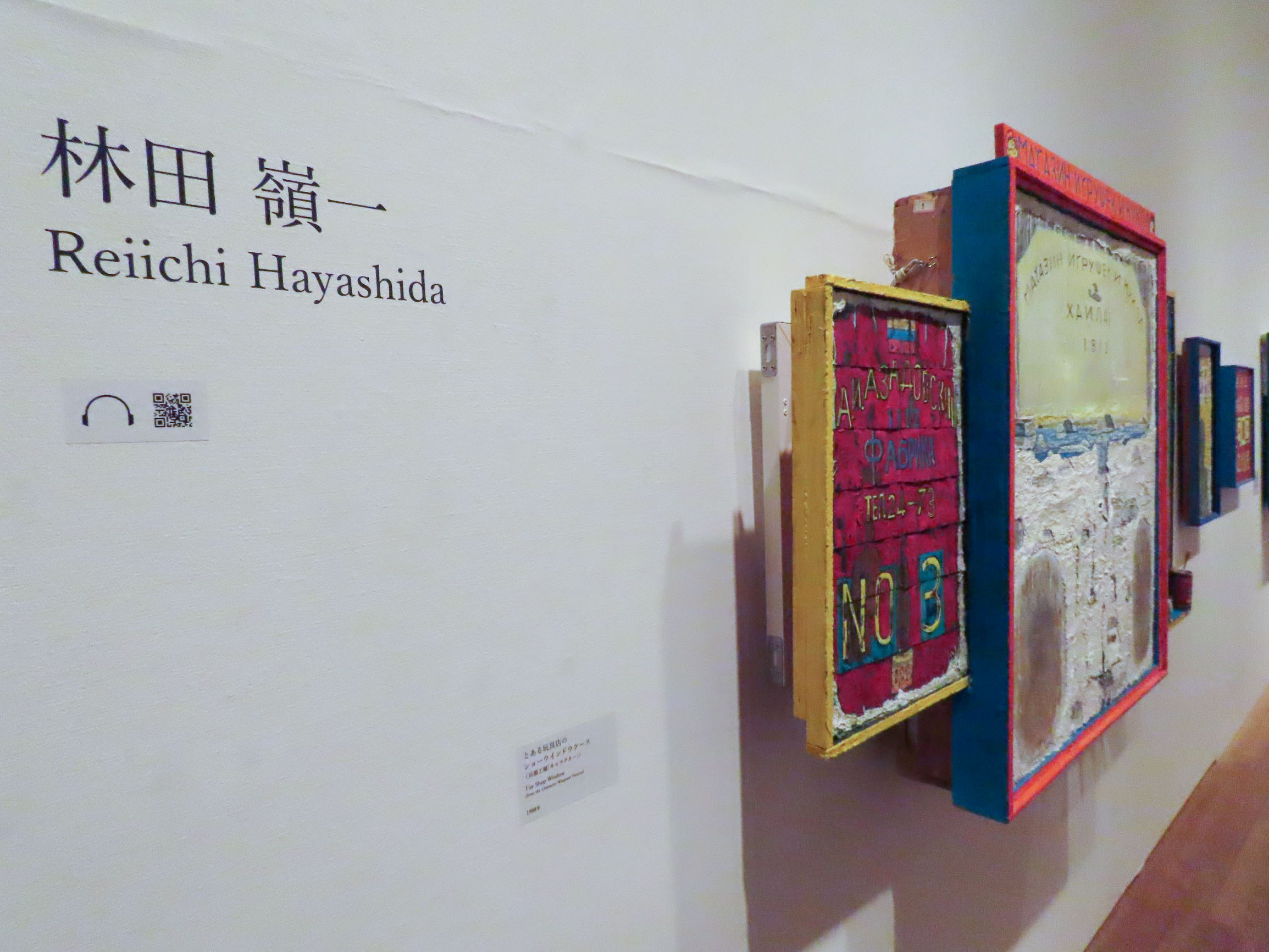
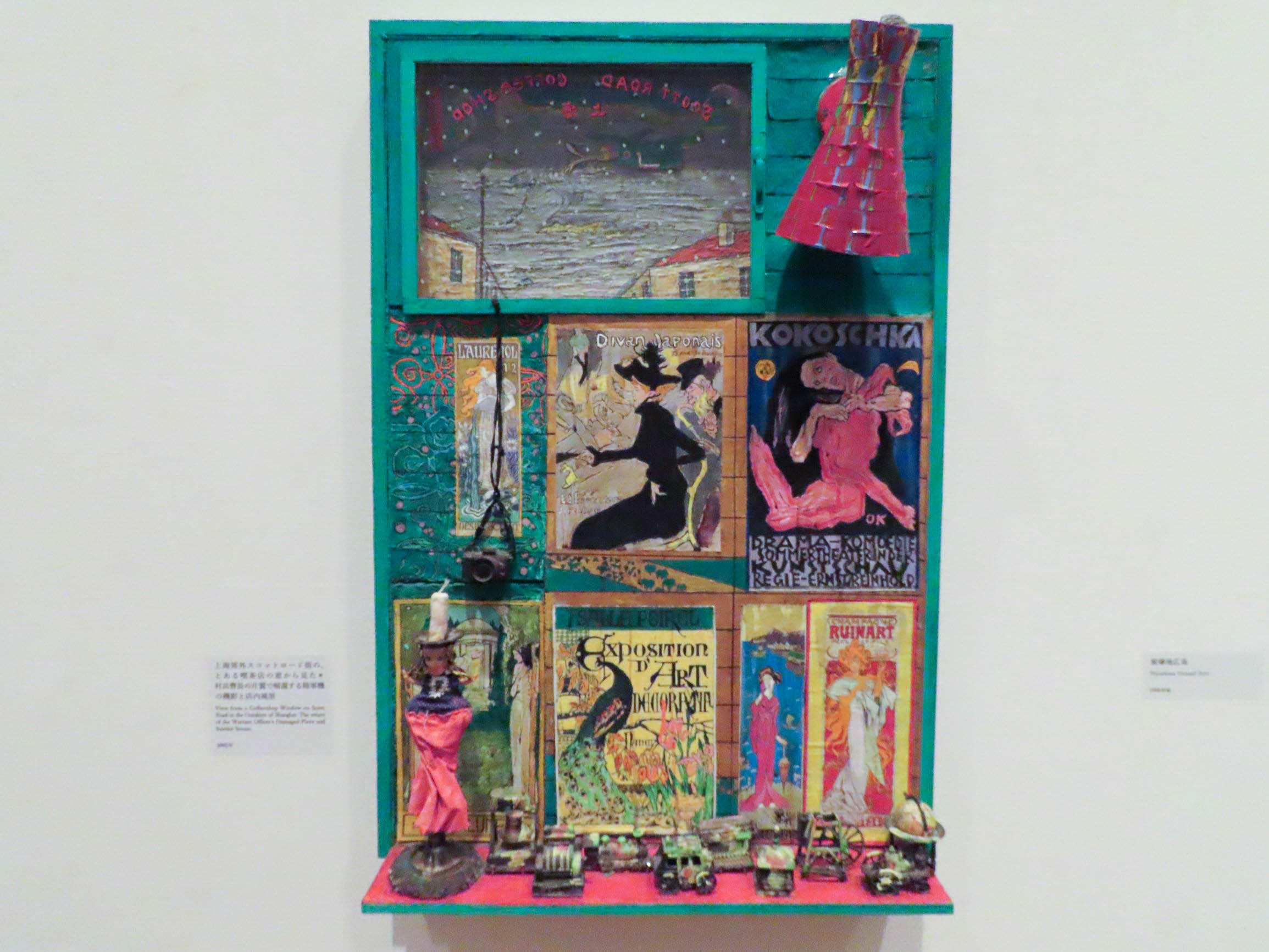
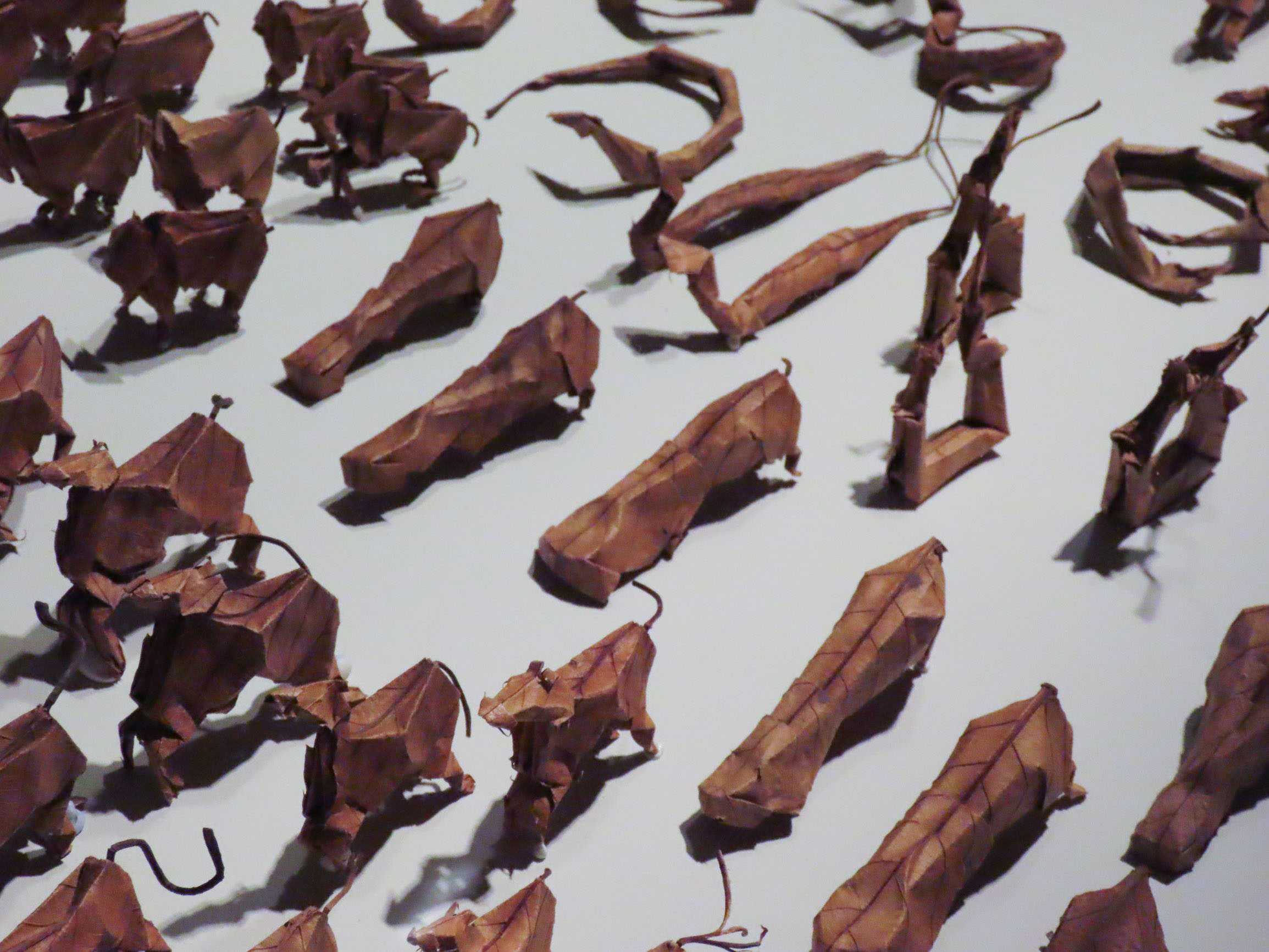

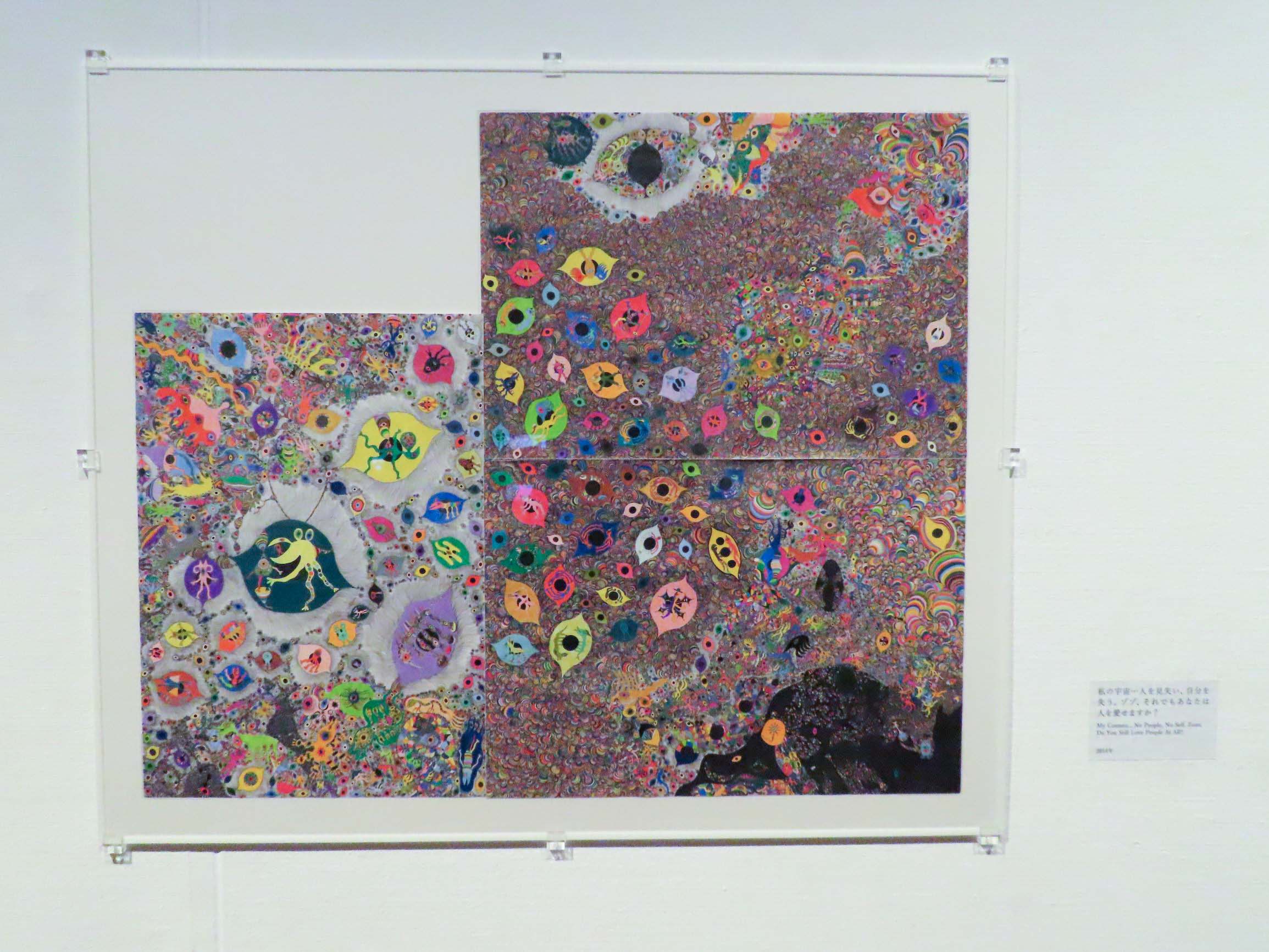
It is not the so-called “professional” works that are exhibited in the special exhibition “Art as it is- people who continue to express without knowing it”.
Collected here are works of artists, who are known as “outsider art” from the world, regardless of existing arts, education, and disabilities, and who continue to pursue their own unique world. The activities of these so-called “self-study” artists have had a great impact on the art world in the early 20th century, and even today, their value and importance are emphasized and widely accepted by society.
In this exhibition, in collaboration with the documentary program “no art, no life” being broadcast on NHK/E-Television, the world of “Aru ga Mama” art, which continues to attract worldwide attention, has recently attracted attention both in Japan and overseas Introducing about 200 works by 25 artists.
First attempt at the exhibition! “Watch robot” online
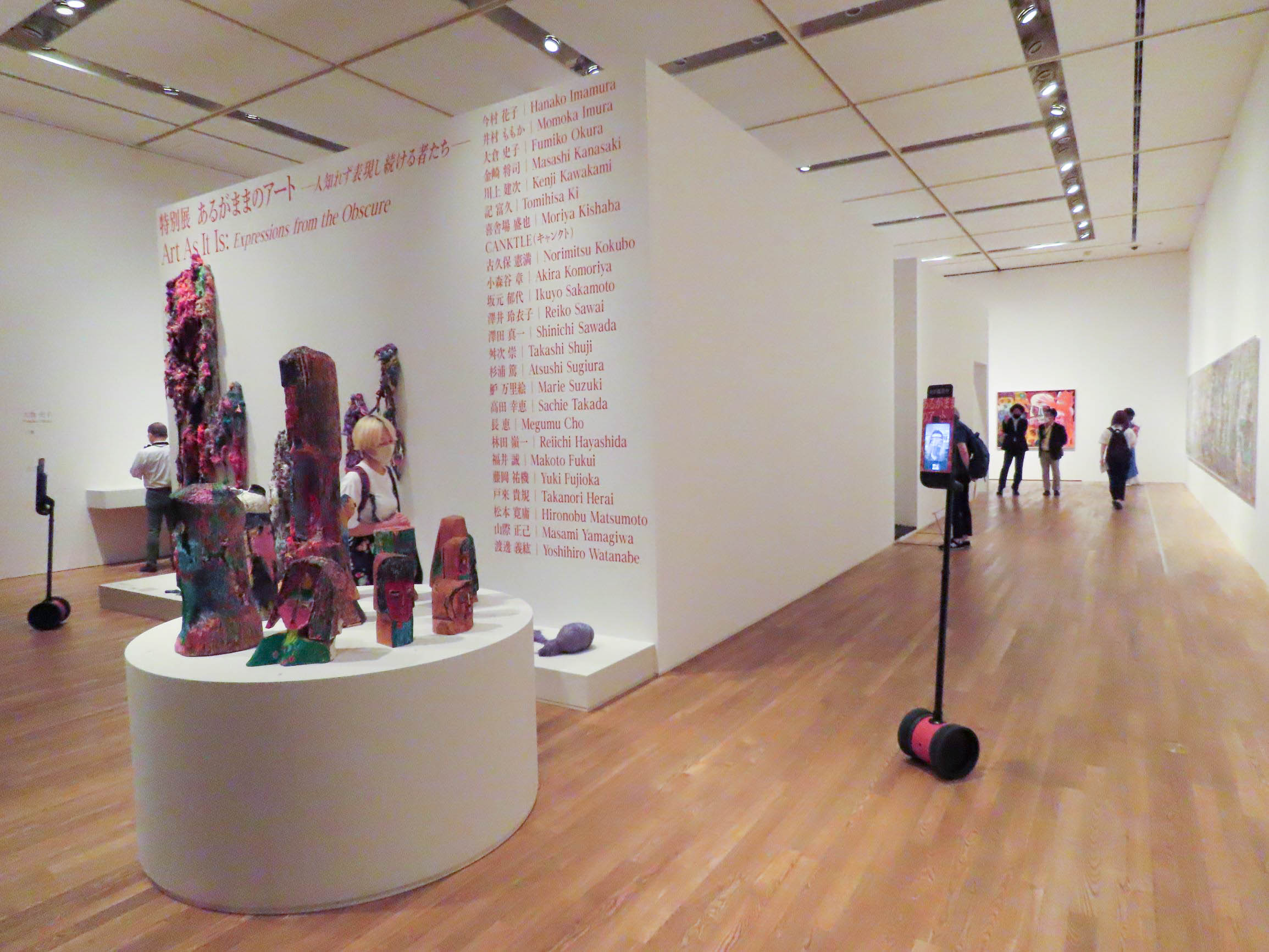
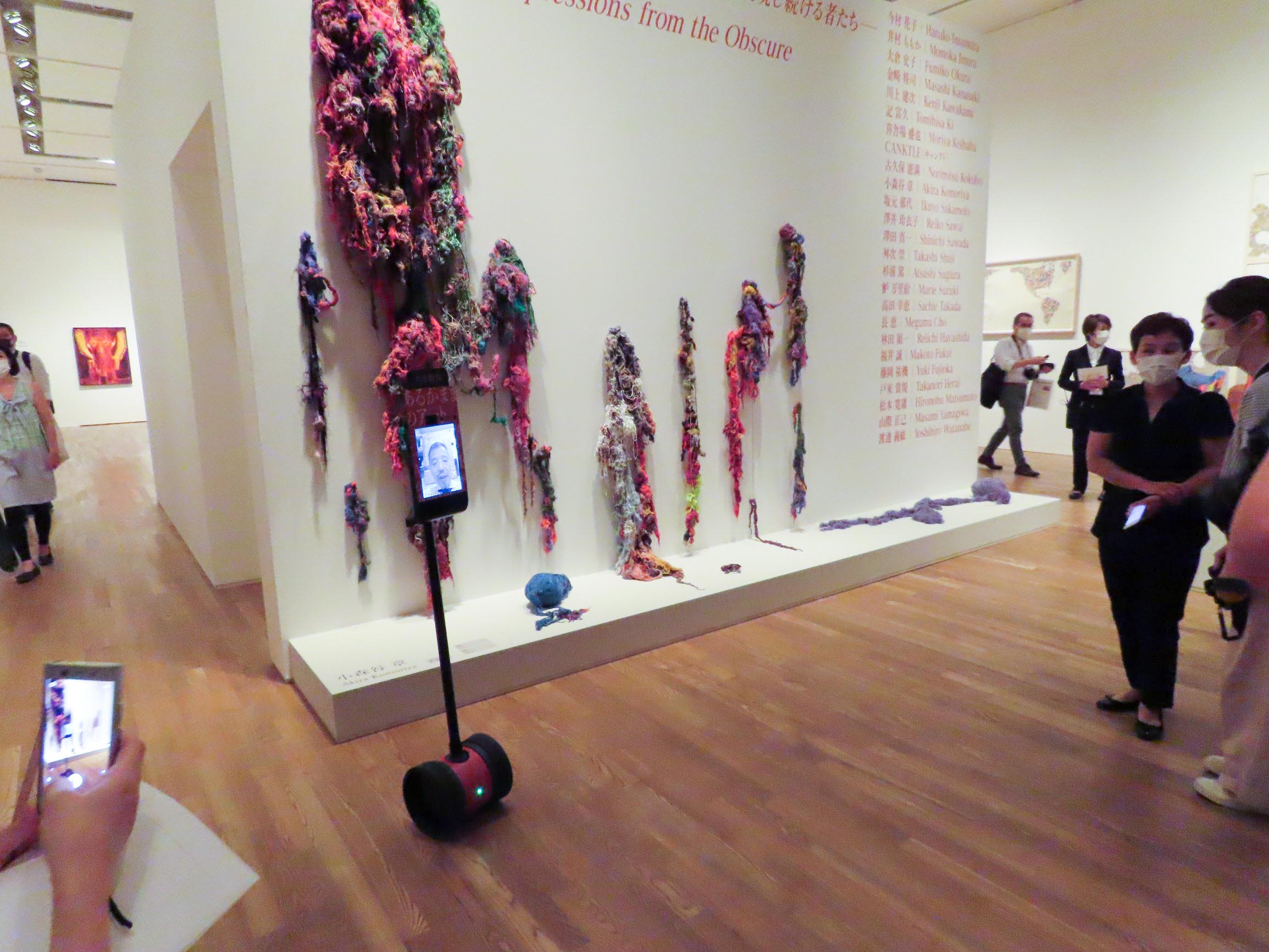
It’s a “first in Japan” trial. In this exhibition, as an original project of Tokyo University of the Arts and NHK, an online robot appreciation meeting is realized by utilizing an autonomous driving robot that can be remotely controlled via the Internet. At the preview, the exhibition was performed, and the works exhibited by the “robot director” were also explained.
The robot uses a 3D sensor to grasp the surrounding environment and find the optimal route to reach the destination. You can also freely communicate with visitors through the monitor. When I saw the visitors and the robots walking side by side and enjoying the atmosphere, I was deeply moved by saying, “Oh, a new era has arrived…”.
It seems that the Robo appreciation party is a reservation system, so you can watch it on the day by registering by selecting the desired date and time in advance and accessing the delivered URL. For details, please see the special content site .
Exhibitor introduction
Marie Suzuki (Marie Suzuki)



Marie Suzuki said he developed schizophrenia in high school. Currently, while going to a local company and local activity support center, he continues to draw.
Plump female body, scissors, genitals… These motifs appear repeatedly in her paintings, creating a “magical” view of the world. In particular, scissors are a motif that “calms down when you draw.”
At the beginning, it seems that it was an illustration style like a leaflet or poster, but gradually it seems that he began to draw pictures that expose himself inside using simple tools such as magic and paper. ..
Norimitsu Kokubo

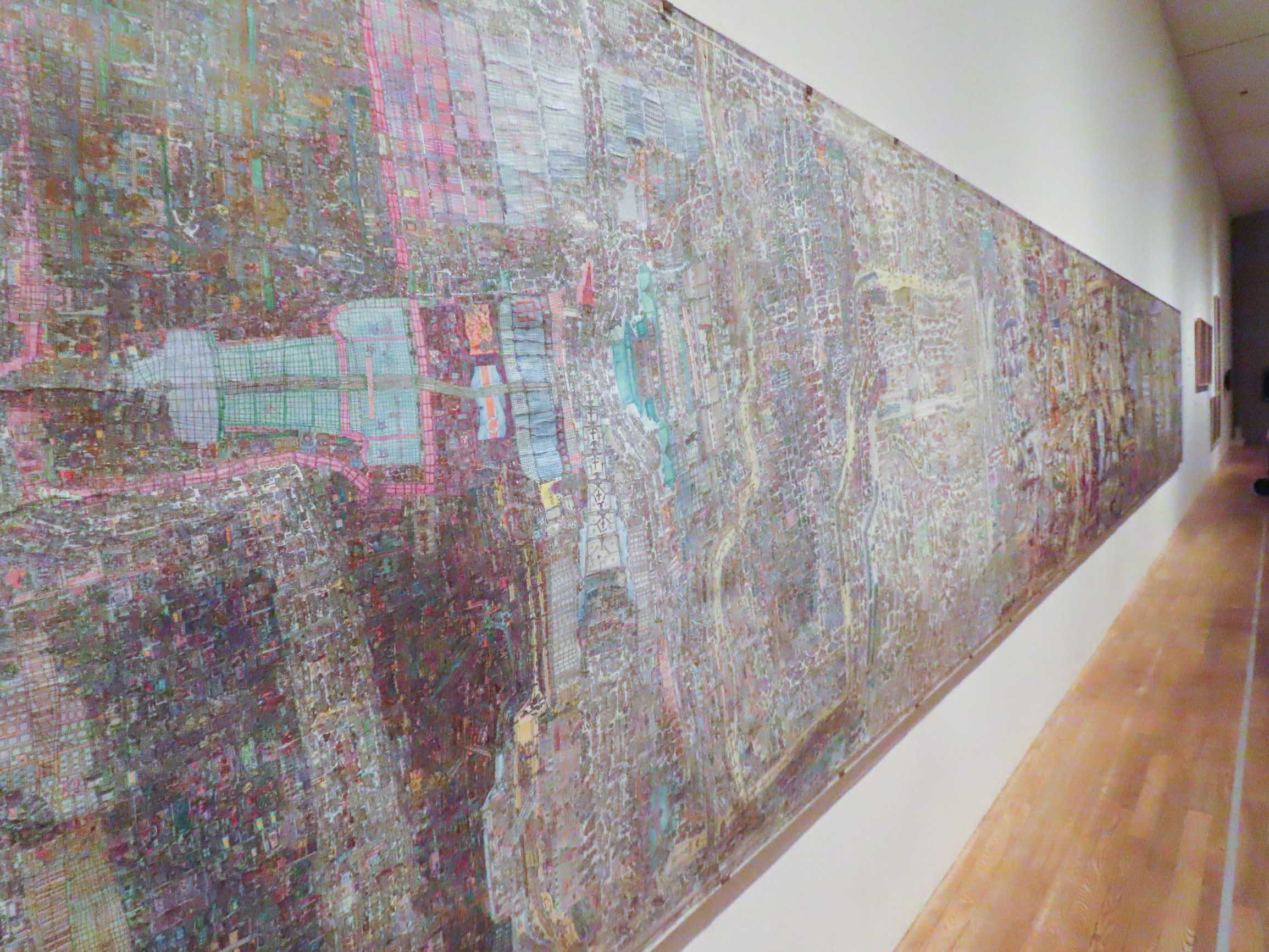
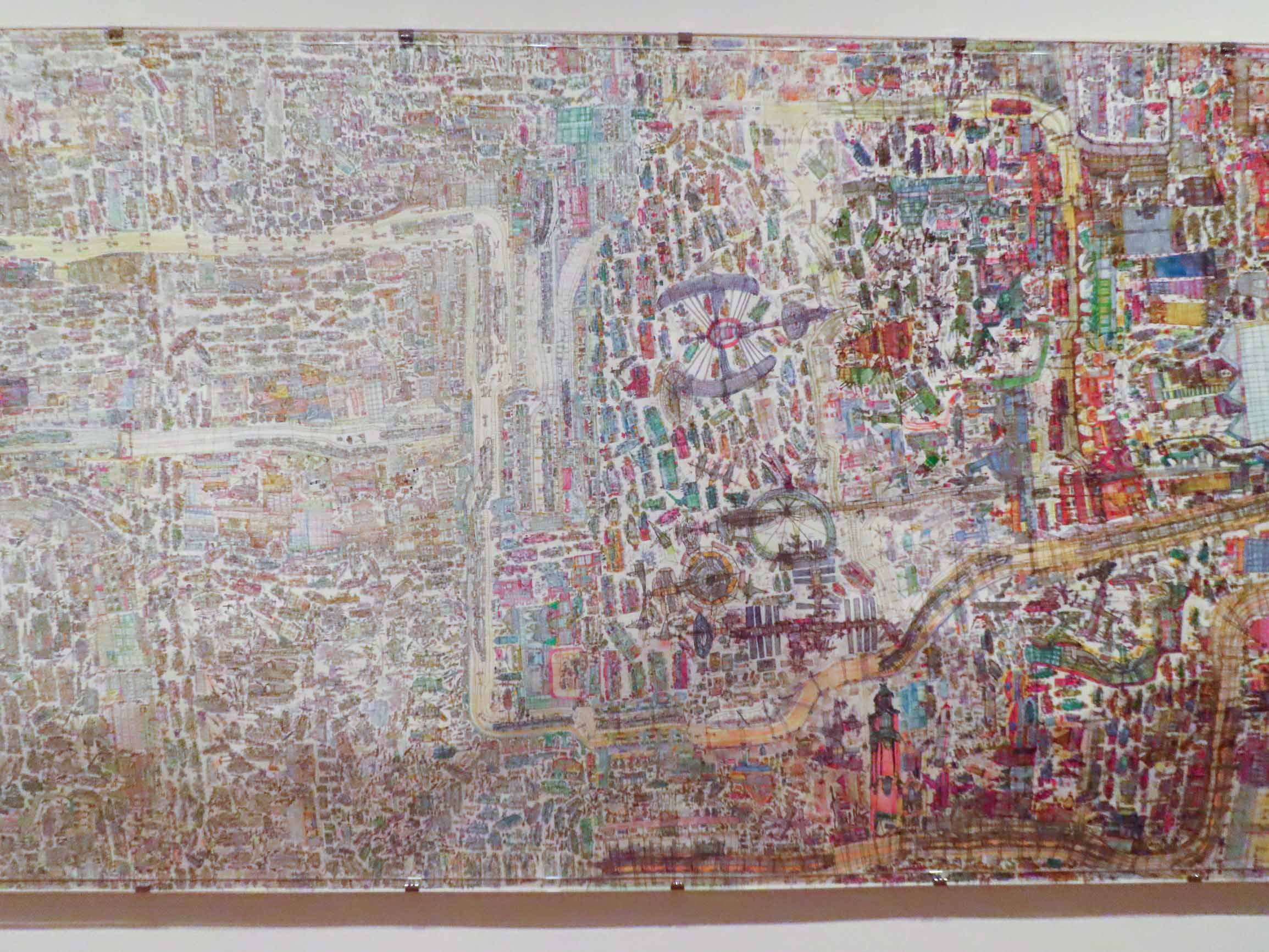
“I want to make everything in this world myself”
With such a strong desire, Mr. Norimitsu Kokubo takes brushes every day and continues to draw. The masterpiece, which has a width of 10 meters and is on display at the venue, started drawing at the age of 17 and was completed after about 5 years.
Railroad tracks running through the city, shopping malls, amusement parks… The campus has a bird’s-eye view of the cityscape, but Mr. Kokubo gathered information gathered through memory and Internet searches to create a fantasy city that does not exist anywhere. This is just a masterpiece.
As you proceeded from the right side of the campus, you can see that the motif and touch gradually change like a gradation as you move to the left.
Kenji Kawakami

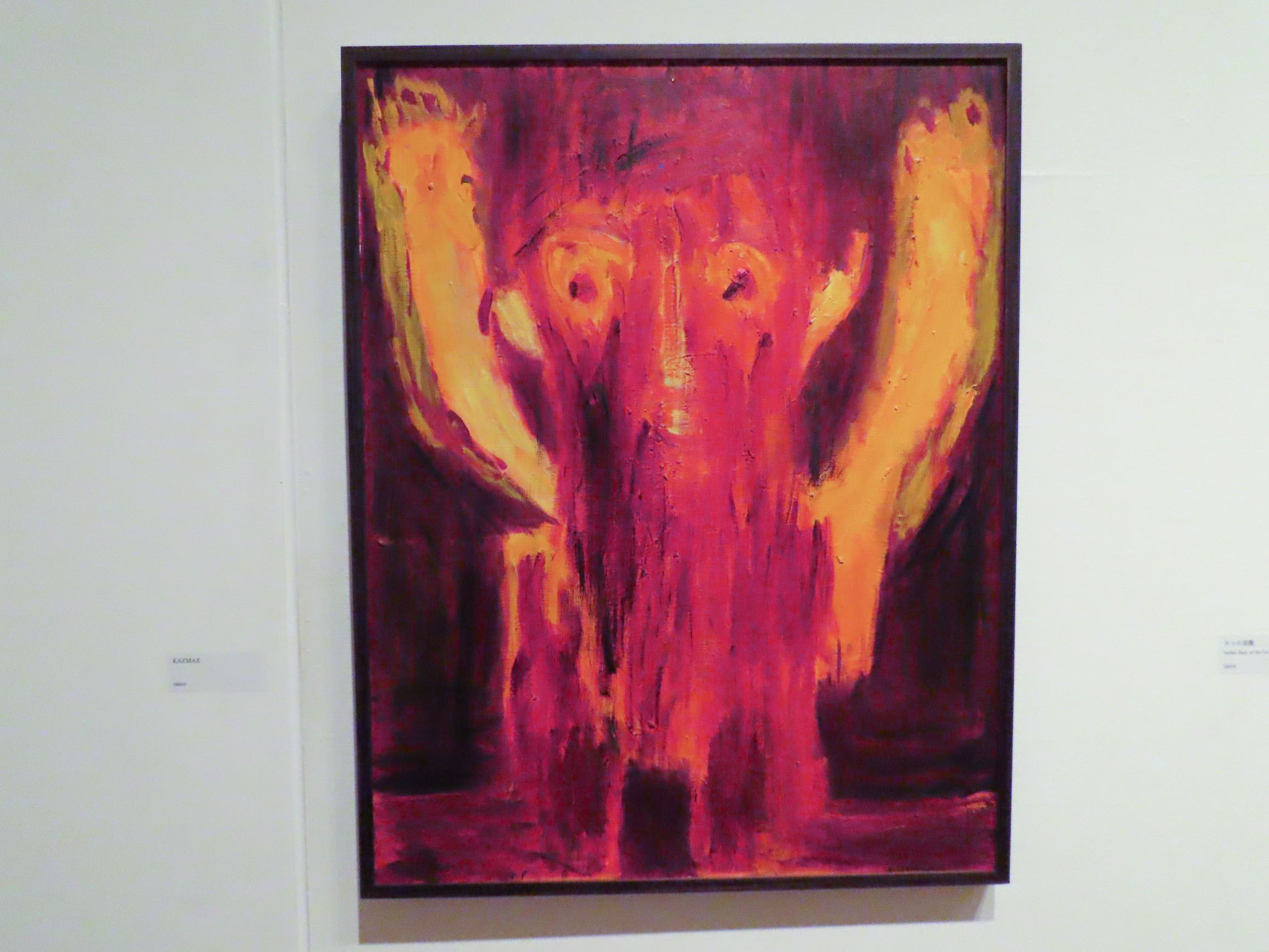

Kenji Kawakami, who uses “things that bring strong emotions to me as a motif” . The work makes us feel a dense “story” and “passion” behind the boy who was bullying herself as a child, and the cat who left behind while feeling remorse.
Although the artist’s appearance and the state of his creation are displayed on the monitor in the venue, Mr. Kawakami laughs and cries loudly, which is exactly the “genuine spirit” itself. Its powerful brushstrokes and touches convey pure, unfamiliar energy.
Sometimes I draw a horrifying scene with thrilling, but the style is somewhat warm. If Taro Okamoto was alive, he would have praised him… I can imagine that.
Event outline
| Exhibition name | Special Exhibition “Art as it is-Those who continue to express without knowing-“ |
| Session | From July 23, 2020 (Thurs./holiday) to September 6, 2020 (Sun) Opening hours 10:00-17:00 (last admission 16:30) *You can see it from 12:00 on Thursday, July 30. *Date and time reservation system ( Click here for reservation site ) |
| closing day | *Closed: Monday However, it will be open on August 10th (Monday/Holiday) and closed on August 11th (Tuesday) |
| Venue | Tokyo University of the Arts University Museum (12-8 Ueno Park, Taito-ku, Tokyo 110-8714) |
| Viewing fee | free entrance |
| Official site | https://www.nhk.or.jp/event/art2020/en/ |
【The Ueno Royal Museum】 “Innocent Day Banzai!” Preview Report-Introducing Featured Works-
The Ueno Royal Museum
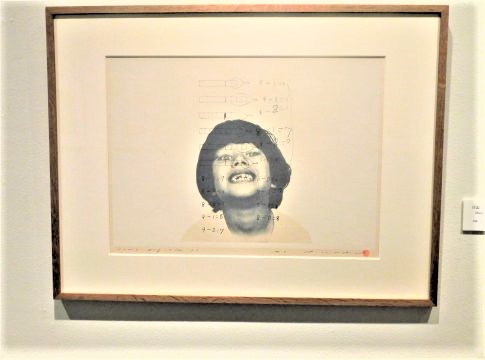
Tetsuya Noda “Diary August 10, 1979” Woodcut, silkscreen, Japanese paper 49.0×63.7cm 1979 Ueno Royal Museum
From July 23, 2020 (Thursday/holiday), the exhibition “Innocent Day Banzai!” will be held at The Ueno Royal Museum . (Until Sunday, August 30)
There was a press preview of this exhibition the other day.
In this article, we will introduce the exhibition, its composition and the editorial department’s featured works.
See it!
About “Innocent Day Banzai!”
The Ueno no Mori Art Museum holds many winning works from the Ueno no Mori Art Museum Grand Prize Exhibition, which has been held 38 times since 1983.
With the theme of “nothing, everyday life that is everywhere”, this exhibition “Nanything Day Banzai!” is a period of coronal blight and various restrictions are imposed on our actions. About 80 works will be exhibited.
In addition, about 40 works from the 1970s to the 1980s of the <diary> series, in which the woodblock artist Tetsuya Noda recorded his family and everyday life, were also exhibited from the collections of the Ueno Mori Art Museum, divided into the first and second halves. In addition, the works created with Sayaka Akiyama as the subject of Ueno Park will also be exhibited.
( Official website “Nothing’s a day!”: http://www.ueno-mori.org/specials/2020/nandemonaihi/ )
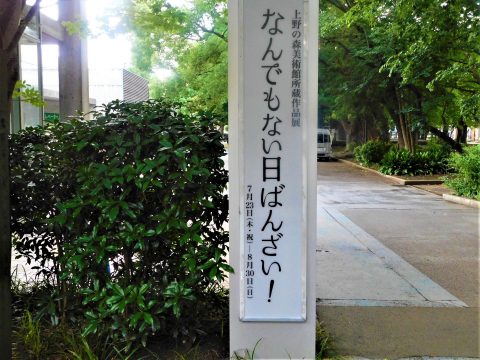
The exhibition structure and the editorial department’s featured works are introduced.
The exhibition is composed of five chapters, and the theme and perspective of the work gradually expand from the inner side to the outer side, from familiar objects to more distant objects.
Chapter 1 “In everyday life”
The theme of the exhibition, “Nothing, everyday life everywhere”, such as everyday “core, the house and the room, scenes around us, works depicting ourselves and close people” It is a representative image group.
☆Yoshitaka Fujii “Bouquet”
A woman who looks straight at her with a strong look.
You will be drawn to that expression in an instant.
The bright blue color of the dress and shoes seems to symbolize the strength of the woman’s core.
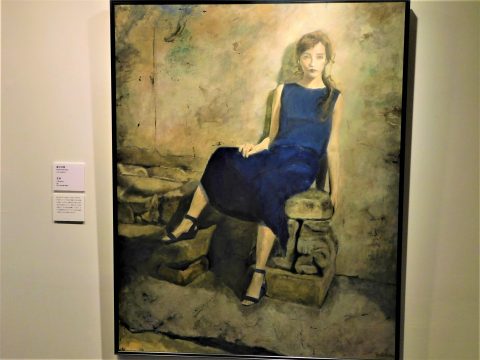
☆ Yohei YaJIima “Plastic Girl”
A pink girl doll leaning against the wall.
It looks like you’re in deep trouble.
If you look closely, the wall has a picture of a man holding a dog or cat.
In fact, do you express your desire to love your father?

Chapter 2 “From everyday to painting”
Everyday is also the entrance to the world of painting.
Rather than just drawing things that are familiar to us everyday, we refer to various styles of paintings from ancient and modern times and the methods of our predecessors, or stylized by demonstrating our own imagination. The chapters are complete.
☆ Kyuma Harada “The Whereabouts of Japan II”
A man wearing a cloth on his face.
The feet are shattered.
Are you worried about Japan’s future?
The title “The Whereabouts of Japan” makes me surprised.
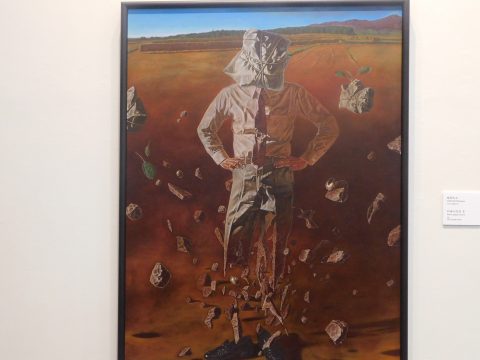
☆ Takeshi Inoue “Kizashi”
A large fish jumping out of a snail shell and a shrimp-like creature sucked into the shell.
The surface of the water is swirling.
Where will the whirlpool grow bigger and bigger?
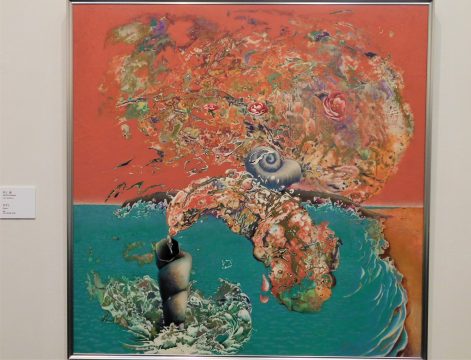
Chapter 3 “Animal”
What do animals in modern society mean to humans?
For city dwellers, there are pets kept at home or animals surrounded by zoos.
Chapter 3 introduces animals that have been expressed as important entities that reflect people’s emotions.
☆ Mirei Omura “Ma”
A big tree and a bird standing near it.
It looks as if the mythical tree is shining brightly, and the bird is spreading its wings like a peacock.
I would like to see what it looks like when viewed in the dim light.

Chapter 4 “Landscape”
In Chapter 4, the exhibition will focus on distant landscapes and bird’s-eye views, which are wider than the reachable landscapes such as indoors introduced in Chapter 1.
From the symbolic buildings of the city to the flow of water, the movement of clouds, and the landscapes that are essential to our lives are depicted here.
☆ Risa Kure “Asakusa”
Everybody knows the scenery of Asakusa along with flowers that symbolize the changing seasons.
In the refreshing colors, it seems that there is also fragility.

☆ Motegi Mana “Constellation-Scenery from the window-“
A work depicting a night view that spreads out of the window.
A variety of lights intersect to give off a dazzling light and speak lively.
When you look at each light, it is strange that the brightness is slightly different.

Chapter 5 “Expanding Imagination”
No matter how small or limited our daily lives are, we can use our imagination to supplement our physical constraints.
In the fifth chapter, the painters will exhibit works that try to connect different things in the painting, introduce different time and space, and create a world far wider and deeper than the reality in front of us.
☆ Moe Aoki “Emotional Awakening”
Flowers, like butterflies, are born of flowers planted in vases.
Is it because you can feel the rich colors even though it is almost a monochrome work?
Red, which is placed here and there, is also effective.
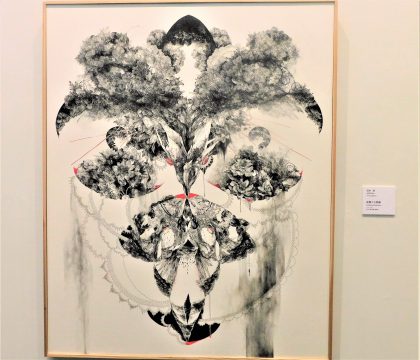
[Special Exhibition] Tetsuya Noda Prints <diary> series
☆ Tetsuya Noda “Diary August 10, 1979”
A work by Tetsuya Noda, whose subject was his young son.
The expression that opens this wide open mouth and faces this is very humorous.
If you look closely, the calculation formula is written on the face.
This formula makes the work even more pop.

※Special feature exhibits may be replaced.
First semester: July 23 (Thurs./holiday) to August 10 (Mon./holiday)
Second semester: Wednesday, August 12-Sunday, August 30
Summary
I have been informed about the exhibition “Urban Day!” held at the Ueno Royal Museum.
All the works under the theme of “everyday, everyday life” that were exhibited were all worrisome.
In addition to the works introduced here, wonderful works are on display, so why don’t you visit the Ueno Royal Museum and check it out?
And after touching the work, you will be able to appreciate the importance of everyday life.
Enjoying works at the museum, taking a walk in Ueno Park, and laughing with family and friends.
What is nothing special is that it is shining so brightly.
* At the venue, as a measure against the new coronavirus, we are requesting temperature measurement and finger disinfection.
Thoroughly disinfect your hands, wear a mask, and keep your social distance to avoid crowds.
Event outline
Title: The Ueno Royal Museum Collection Exhibition
Meeting place: The Ueno Royal Museum 1-2 Ueno Park, Taito-ku, Tokyo 110-0007
Date : July 23, 2020 (Thurs./holiday)-August 30 (Sun)
Closed: Monday (but open on August 10th), Tuesday, August 11th
Time: 10am-5pm (Last admission 30 minutes before closing)
Sponsored by: Japan Art Association Ueno no Mori Art Museum, Fuji Television Network
Supported by: Fuji Sankei Group
Ticket information
*This exhibition requires reservation by date and time
① 10:00 to 10:59 ② 11:00 to 11:59 ③ 12:00 to 12:59 ④ 13:00 to 13:59
⑤ 14:00 to 14:59 ⑥ 15:00 to 16:30
Prior to your visit, please purchase the time-specified ticket in advance at the following (e+ e-plus, FamilyMart stores)
Please come to the venue. There will be admission restrictions during the exhibition period to ease congestion in the museum.
For those who do not have an internet environment
For those who come directly on the day without making a reservation with a designated date and time, we will inquire about the available time slot of the time zone you visited at [the same day window].
Those who have reserved the date and time will have priority, so you may have to wait until you enter. Please note.
*There is no replacement system. *Please enter within the designated time.
Admission: 1,000 yen for general students, 500 yen for university students, free for high school students and younger
*Persons with disabilities and one accompanying person are free of charge. Please show your disability certificate when entering the building.
Sales period
① From 10th July 2020 (Friday) 10:00~
[7月23 日( 木・祝)~8 月10 日(月・祝) の期間のチケットを販売します。]
(2) July 22, 2020 (Wednesday) midnight
[8 月12 日( 水)~8 月30 日( 日) まで の期間のチケットを販売します。]
Sale place e+ / QR ticket [WEB sale] https://eplus.jp/ueno-mori/
[Convenience store sales] Fami port inside FamilyMart store
*How to purchase over the counter at FamilyMart https://www.family.co.jp/services/famiport.html
*The Ueno Royal Museum window (opening days only)
・If a person infected with the new coronavirus is found in the museum, the information will be posted on the Ueno no Mori Art Museum website.
・If there are any changes during the exhibition period, we will inform you on the Ueno Mori Art Museum website.
*About the title
The word “Nanban Hibanzai!” originated from the word “un-birthday present” that originally appeared in Lewis Carroll’s “Alice in the Mirror Land.” In Disney’s “Alice in Wonderland,” there is a song “A Very Merry Unbirthday To You” in “Songs for a day that is not your birthday”.
The University Art Museum, Tokyo University of the Arts Special Exhibition 「Art as it is-people who continue to express without knowing-」 Introducing the exhibitors who are attracting attention in Japan and overseas!
The University Art Museum, Tokyo University of the Arts

Imura Momoka 《Green Ball》2014
The Tokyo University of the Arts, NHK, the Agency for Cultural Affairs, and the Japan Society for the Promotion of Arts and Culture, The University Art Museum, Tokyo University of the Arts
(Taito-ku, Ueno Park), as part of the “Japan Expo,” a special exhibition “Art as it is-Unknown Those who continue to express themselves-“ [Session: July 23, 2020 (Thurs./holiday)-September 6 (Sun.) / Reiwa 2nd year Japan Expo sponsored and co-sponsored project] will be held.
In this exhibition, we will carry out expression activities that are faithful to our own artistic impulses and are free to create our own world without being influenced by any particular culture, existing art, fashion, or specialized education. Focus on the work of existing artists.
In Japan, many self-study artists have their own unique expression activities, and many of them are intellectually or mentally disabled, so their works do not appear in the world, but it is overwhelming. Full of dynamic power.
They not only teach us the richness and freedom of mind of humans, but also stimulate their creativity and the opportunity to think about new human images.
Through about 200 works by 25 artists who have been attracting attention in Japan and abroad in recent years, the world of “art as it is” that is attractive and diverse, and the lives of artists who can see a glimpse of the works from NHK E-tele, BS4K8K, “no art, no life” currently being broadcast on international broadcasts, and a video of the “People who continue to express without knowing” series, which has been featured in ETV since 2017.
[What is “Japan Expo”]
The Japan Expo is a project to develop art exhibitions, performing arts performances, art festivals, etc. throughout the year, where you can experience the beauty of Japan from the Jomon period to the present day, with the general theme of “Japanese and nature”. is.
The Agency for Cultural Affairs, Japan Arts and Culture Promotion Association, relevant ministries and agencies, cultural facilities nationwide, local governments, private companies and organizations, etc. work together to promote various cultural arts that each region is proud of. We aim to create a future in the future by transmitting the appeal both domestically and internationally to the next generation.
Japan Expo official website: https://japanculturalexpo.bunka.go.jp/en/
■ Highlights of this exhibition
■Paris, New York, Asia, Japan’s “Arugamama” art works, which became a hot topic, gathered together!
■Prickly thorns, fallen leaves origami, 10 meters! Approximately 200 works, including masterpieces of contemporary picture scrolls
■The moment when various expressions are created Introducing the creative landscape of artists in 4K video
■A total of 25 people who are impressed by what human wealth is and what it means to live together.
[Exhibitor]
Hanako Imamura / Momoka Imura / Fumiko Okura / Shoji Kanazaki / Kenji Kawakami / Notes Tomihisa / Moriya Kishaba / CANKTLE
Norimitsu Kokubo/Akira Komoritani/Ikuyo Sakamoto/Reiko Sawai/Shinichi Sawada/Takashi Masuji/Atsushi Sugiura/Marie Owase/Yukie Takada
Megumi Naga / Minoru Hayashida / Makoto Fukui / Yuuki Fujioka / Takanori Toki / Hironori Matsumoto / Masami Yamagiwa / Yoshihiro Watanabe (in alphabetical order)
*Exhibitors and works posted may change due to circumstances.
■ Artist introduction
Shinichi Sawada
Sawada creates symbolic ceramic art objects that look like fictional animals and humans. Although strange in form, they are strange creatures that look somewhat humorous.
The innumerable thorns that cover the surface create a unique world, and the work has a charm that you cannot forget once you see it.
Depending on how you look, the spine-like protrusions look like sensors that sense the world, and they also appear to be covered by body hair that protects you.
Initially, it started with the creation of a small animal-like object that could be grasped, but eventually it grew in size and developed into a sculptural work in a fantasy form that recalled primitive humans and animals. I went.
Sawada quietly continues to produce in a kiln in the mountains of Ritto City, Shiga Prefecture.

Kishaba Moriya
Kishaba Moriya has created a dot series that focuses on the bleeding of ink, after producing works in which the letters and letters are written on one side of the paper and works in which shapes such as bells and squares are drawn in series.
This series always starts by hitting the blue circle in the lower left corner.
This circle is slightly larger than the others because the pen tip is in contact with the paper for a long time.
After the first spot, it seems that he is improvising on the color selection of the dots, but it is unavoidable that he has his own production system because there is no color bias on the screen.
In the new “Dot Series” drawn with colored pencils, the swell of colors creates a mysterious landscape.
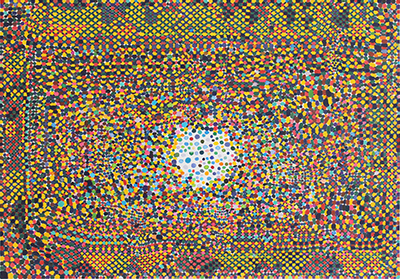
Imura Momoka
Creates a round object made of cloth. There are various sizes, from the size to be put on the hand to the size suitable for holding.
It does not have a concrete image, but it is reminiscent of a pet animal or a stuffed animal.
We don’t make big ones from the beginning, but we make small ones to big ones as we grow the objects one by one.
I like pink, so when I arrive at the studio, I wear a pink wig first, and when I’m done with my wig, take off the wig and go home.
Sometimes, I make it by singing, dancing and moving.

Hironobu Matsumoto
There are works of all sizes, from large ones over 3 meters to sketchbook-sized ones, all of which are rich in color, and the details are composed by clear images, and every corner is filled with them to create a story. I am configuring. As you approach the work, you can enjoy the fun of reading it.
The subjects to be dealt with range from large-scale ones such as space and historical battles to minute ones such as fog and bacteria and white blood cells. Regardless of the scale of the subject matter, they all form a kind of world. It can be said that they are introduced through the work, and it became a motivation for the production that the interest in “riddle” such as what kind of law and rule formed and systematized the world was established. There is.
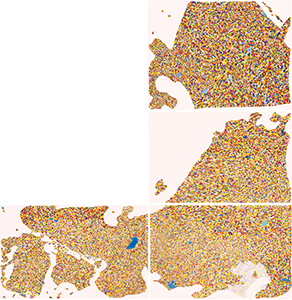
■Overview of the exhibition
Special exhibition “Art as it is-people who continue to express without knowing-“
Introducing the works of artists who are directly involved in their artistic urges, without being influenced by specific cultures or art trends.
The world of “art as it is” attracting worldwide attention has been explored for a wide range of “views of humanity” through about 200 works by 25 artists who have been attracting attention both in Japan and overseas in recent years. Think about what is “richness”.
Venue: The University Art Museum, Tokyo University of the Arts 12-8 Ueno Park, Taito-ku, Tokyo 110-8714
Dates: July 23, 2020 (Thursday/holiday) to September 6 (Sun)
Closed days: Every Monday, Tuesday, August 11th
*However, on August 10th (Monday/Holiday), the museum is open from 10:00 to 17:00
*Last admission 30 minutes before closing
Organized by: Tokyo University of the Arts, NHK, Agency for Cultural Affairs, Japan Society for the Promotion of Arts and Culture, Reiwa 2nd Japan Expo sponsored/co-sponsored project
Exhibition official website: https://www.nhk.or.jp/event/art2020/en/
Exhibition official SNS
Instagram: https://www.instagram.com/arumama20/
Facebook: https://www.facebook.com/arumama20
twitter: https://twitter.com/arumama20
[Introduction to the admission reservation system in order to prevent 3 dense (closed, crowded, close) inside the exhibition room]
The exhibition is free to enter, but all guests must pre-book online. (No reservation required for children under elementary school age)
・Opening hours are from 10:00 to 17:00, with admission every 30 minutes. The final reservation acceptance time is 16:00 reservation times (last entry 16:30).
・You can make a reservation only from the reservation site. We will start accepting applications one week before your desired date of visit. We can not accept it by phone etc.
・On the day of your visit, please show the screen of the designated time ticket or a printed screen to the staff at the entrance of the exhibition room. If you do not show it, you cannot enter the building.
Reservation page URL https://art-as-it-is.jp/en/reservation/ [Reception starts from 10:00 am on Thursday, July 16]
Article provided by Kokosil Ueno
See other exhibition information
【The Ueno Royal Museum】 Exhibition of works held by The Ueno Royal Museum. Holding
The Ueno Royal Museum
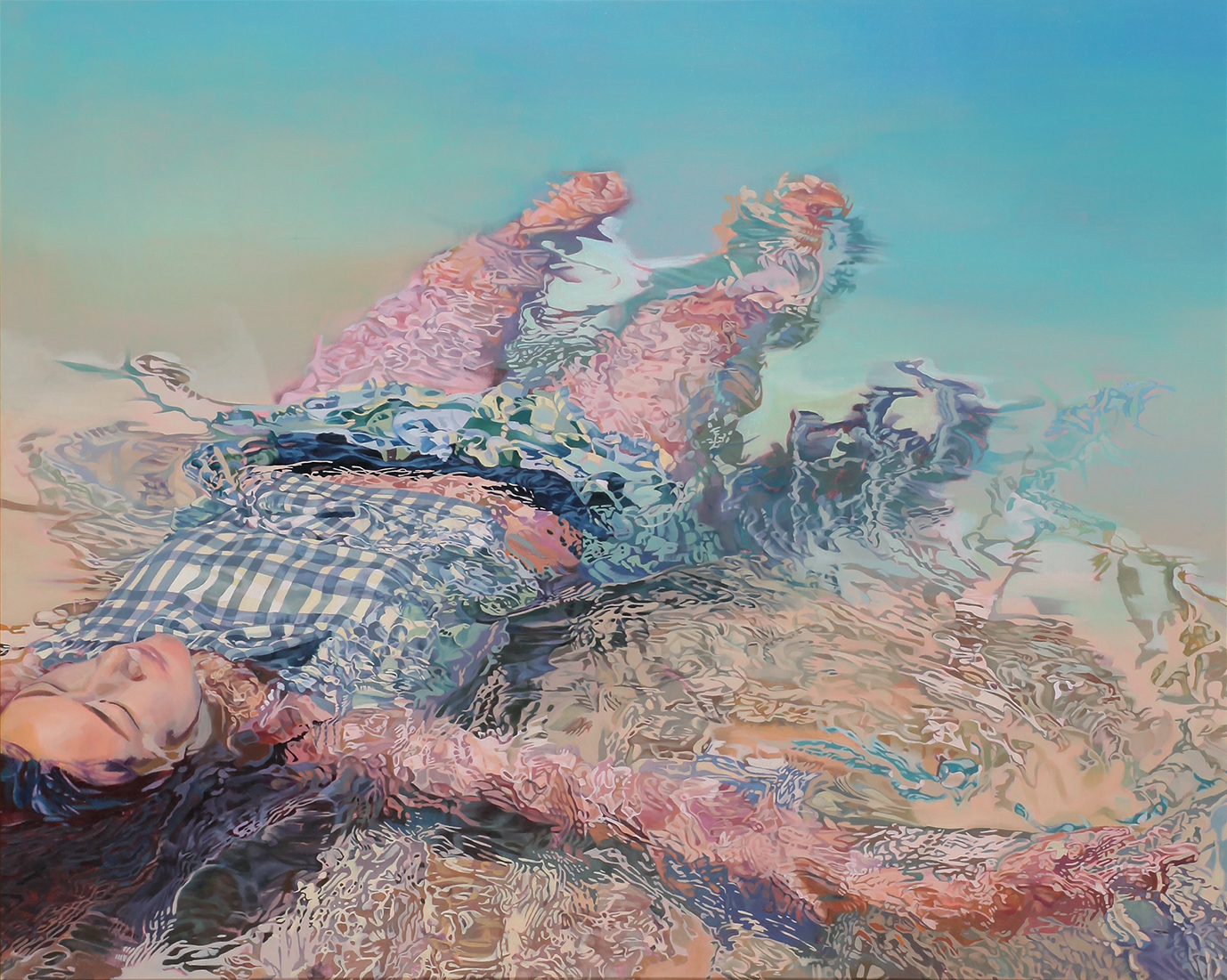
Under the theme of “everyday, everyday life”, I would like to see it at this time of the year.
A work that touches the heart is picked up from the works of The Ueno Royal Museum!
Our consciousness and society are fundamentally changing due to the infection problem of the new coronavirus, which started in earnest in Japan this February. Under the subsequent declaration of an emergency, restrictions on behavior that were unthinkable until now–requiring to stay as close to people as possible, not to meet, not to meet, not to go out or to go out, and to spend more time at home Now, we have to reconsider the everyday life that everyone used to take for granted.
The Ueno Royal Museum holds a number of winning works from The Ueno Royal Museum Grand Prize Exhibition, which has been held 38 times since 1983.
This time, from this, I would like to see the theme of “everyday, everyday life”
I chose about 80 works I thought.
We make up a group of things that make us feel bright and happy, calm everyday scenes, towns and natures that are always there, and unique imaginations and thoughts from familiar people and landscapes. ..
At the venue, about 40 items from the <diary> series in which print artist Tetsuya Noda recorded family and everyday fragments from the same collection, and works created with Sayaka Akiyama as the subject of Ueno Park will be exhibited. ..
In the simple and straightforward gaze for the everyday life that artists are familiar with, I suppose we can find something important that touches our hearts today.
Main exhibits
・Approximately 80 points from works (oil paintings, Japanese paintings, etc.) winning the Ueno Royal Museum Grand Prize Exhibition
・Approximately 40 works by Tetsuya Noda (prints).
・Sayaka Akiyama “Walk my basic form Ueno Park” 25th December 2008, 3rd April 7, 7th, 14th, 12th May, 16th May”
*Size notation: F100=162.1×130.3 cm S100=162.1×162.1 cm
Kaho Kasuga 「It’s miserable and delicious.」
Oil F100 2020
The feeling of guilt and disgust for greed, as well as the exhilarating refreshing feeling that exists at the same time, have an impact with a photographically extreme three-point perspective. A scene that makes you feel lonely, a bold cut that makes you grasp it and a cool depiction give a strong impression.
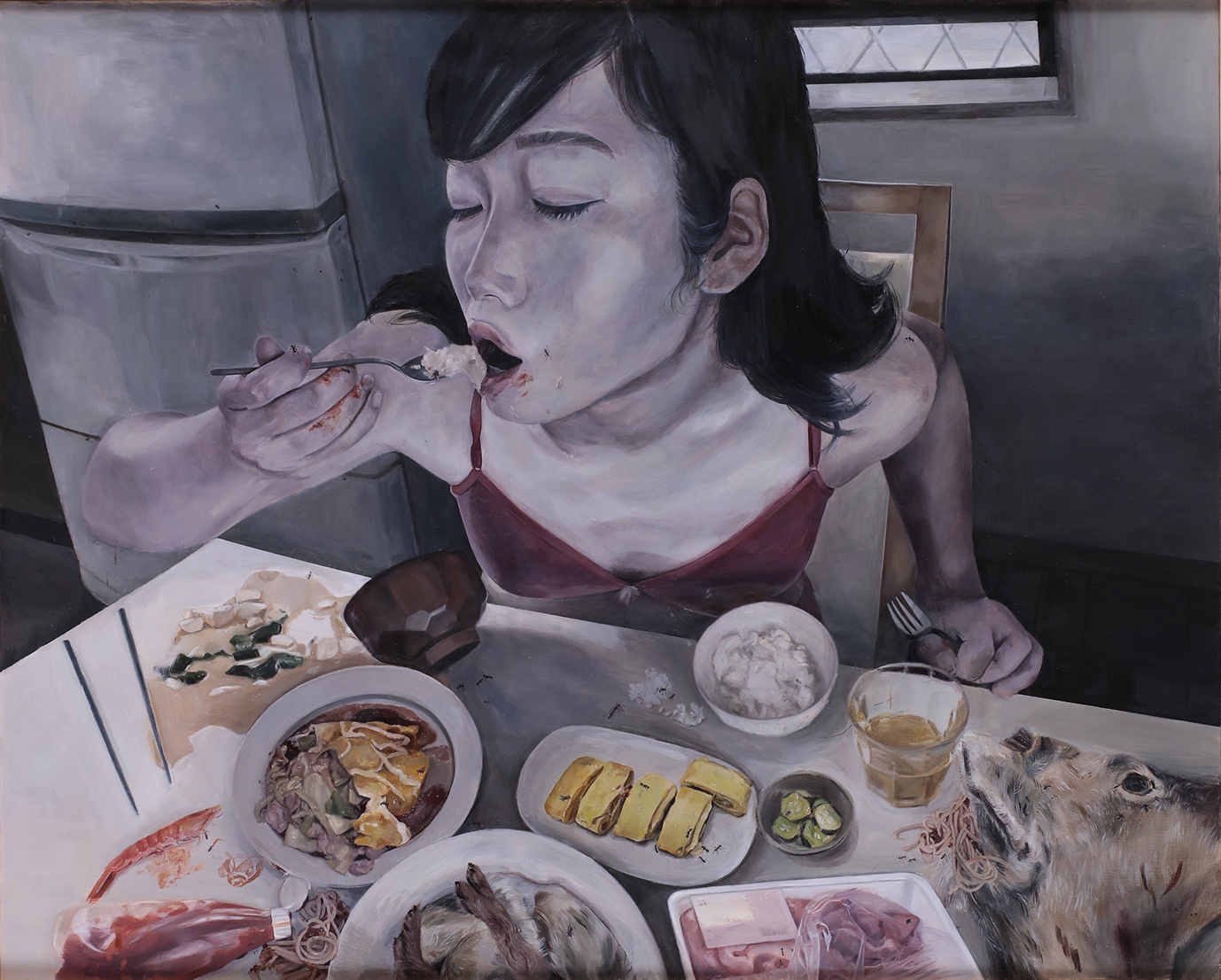
Sanae Fujiwara 「Picnic」
Japanese painting F100 2020
It depicts a fun time out with the family.
It seems that the busy time is still continuing, with the dented feeling that people who have been there up to now standing up.
Bright colors with a sense of rhythm excite me.

Mika Chiba 「Mysterious」
Oil F100 2017
It successfully captures the effect created by the irregular reflection of the light entering the water surface.
Most of the woman’s body is in clear water, and the delicate light expresses the feeling of coolness and floating.
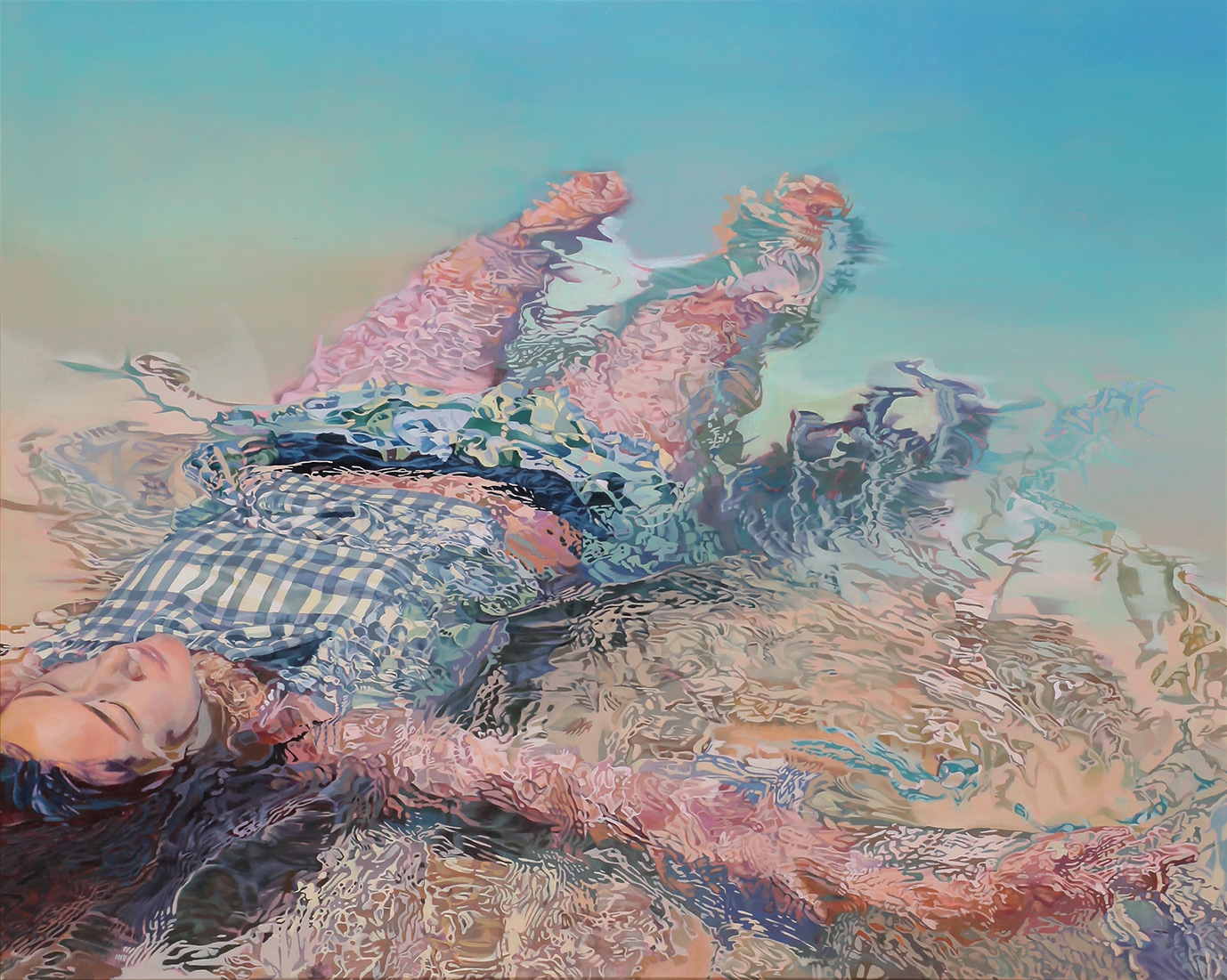
Akihiro Togashi 「FORM, Little Bird」
Acrylic, water-based paint, etc. S100 2000
A large tree-like object is drawn in the center, and animals and birds are drawn around it. There are a variety of materials and techniques, and I use a free technique to sew cloth on the screen, use buttons and paint, and create a flexible screen.
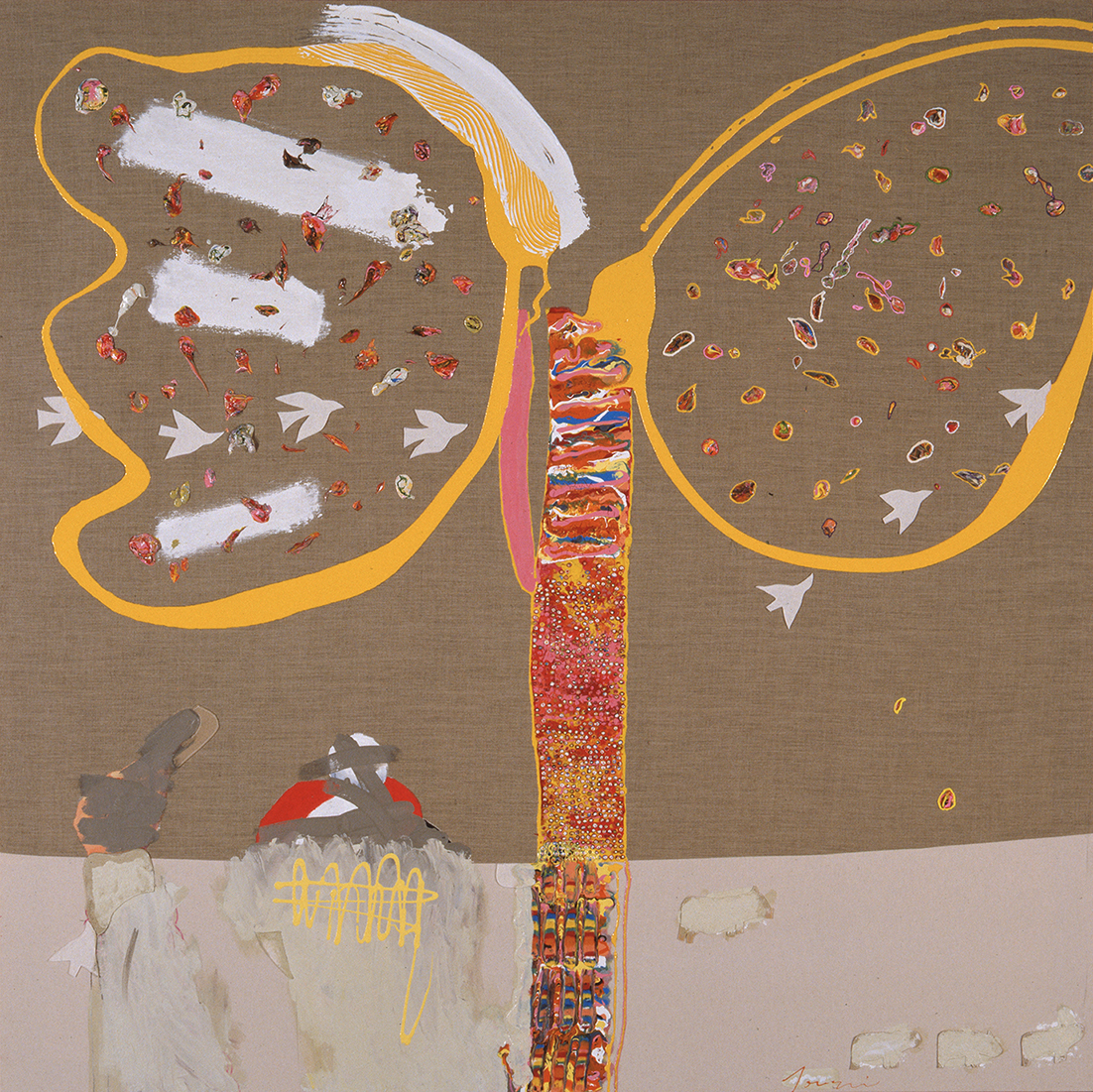
[Special Exhibition] Tetsuya Noda Prints <diary> series
There is a display change.
First semester: July 23 (Thurs./holiday) to August 10 (Mon./holiday)
Second semester: Wednesday, August 12-Sunday, August 30
Under the theme of “everyday, everyday life”, this exhibition features Tetsuya Noda, one of Japan’s leading printmakers,’diary’ series.
The <Diary> series, which deals with the scenery around us and our family, is Noda’s life work that continues from 1968 to the present. In this exhibition, about 40 points are divided into about 40 points from the works of the 1970s and 1980s owned by this museum. Will be on display.
Based on photographs taken by himself, woodcuts, silk screens, and other works that create images of families, vegetables and fruits, shopping bags, sofas, views from the car window, and other things that make you imagine your daily life and events. It is spelled out plainly.
While sticking to the extremely personal subject of the writer’s own daily life, they may have the universality that anyone can share only in the “nothing, everywhere” scene.
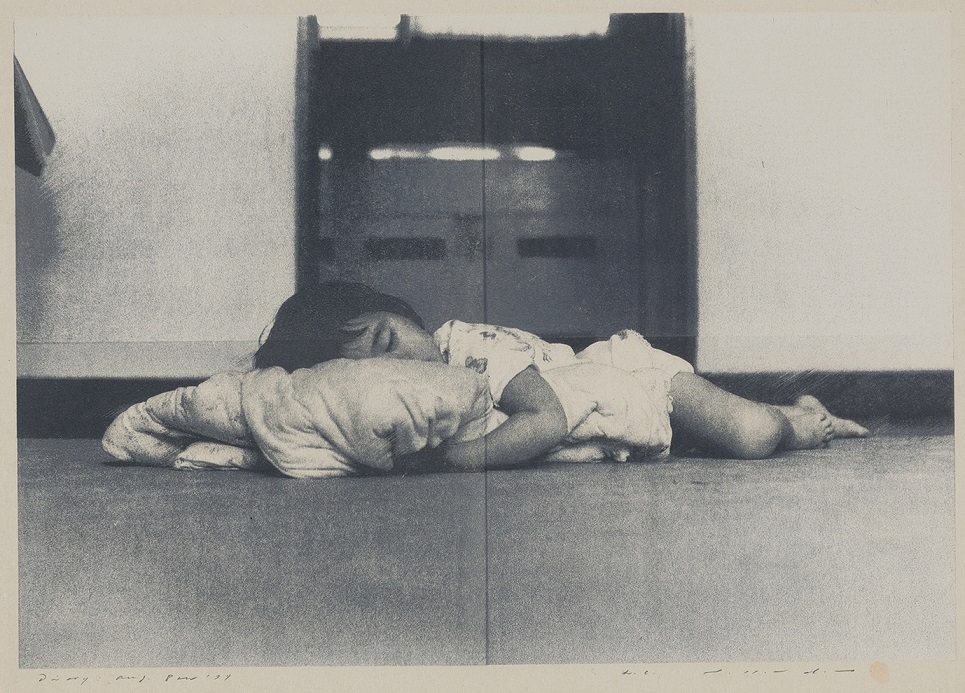

(※「Unauthorized reproduction of images and pictures is prohibited.」)
【Overview】
Title Exhibition of The Ueno Royal Museum Exhibition
Venue The Ueno Royal Museum 1-2, Ueno Park, Taito-ku, Tokyo 110-0007, Japan
Date: July 23, 2020 (Thurs./holiday)-August 30 (Sun)
Closed Mondays (but open on August 10th), Tuesday, August 11th
Time 10am-5pm (Last admission 30 minutes before closing)
Main event: Japan Art Association The Ueno Royal Museum, Fuji Television Network
Supported by Fuji Sankei Group
*About the title
The word “Nanban Hibanzai!” is originally derived from the word “un-birthday present” in Lewis Carroll’s “Alice in the Mirror Country”. In Disney’s “Alice in Wonderland”, there is a song “A Very Merry Unbirthday To You” in “Song of a day that is not your birthday”.
Ticket information
*This exhibition requires reservation by date and time
① 10:00 to 10:59 ② 11:00 to 11:59 ③ 12:00 to 12:59 ④ 13:00 to 13:59
⑤ 14:00 to 14:59 ⑥ 15:00 to 16:30
Prior to your visit, please purchase the time-specified ticket in advance at the following (e+ e-plus, FamilyMart stores)
Please come to the venue. There will be admission restrictions during the exhibition period to ease congestion in the museum.
*This exhibition requires reservation by date and time.
For those who do not have an internet environment
For those who come directly on the day without making a reservation with a designated date and time, we will inquire about the available time slot of the time zone you came at [the same day window].
Those who have reserved the date and time will have priority, so you may have to wait until you enter. Please note.
*There is no replacement system. *Please enter within the designated time.
Admission fee 1,000yen, university student 500yen, free for high school students and younger
*Persons with disabilities and one accompanying person are free of charge. Please show your disability certificate when entering the building.
Sales period
① From 10th July 2020 (Friday) 10:00~
[Tickets will be sold from July 23 (Thurs./holiday) to August 10 (Mon./holiday). ]
(2) July 22, 2020 (Wednesday) midnight
[Will sell tickets for the period from Wednesday, August 12th to Sunday, August 30th. ]
Sale place e+ / QR ticket [WEB sale] https://eplus.jp/ueno-mori/
[Convenience store sales] Fami port inside FamilyMart store
※How to purchase over the counter at FamilyMart https://www.family.co.jp/services/famiport.html
※The Ueno Royal Museum window (opening days only)
・If a person infected with the new coronavirus is found in the museum, the information will be posted on The Ueno Royal Museum website.
・If there are any changes during the exhibition period, we will inform you on the The Ueno Royal Museum website.
Article provided by Kokosil Ueno
See other exhibition information
【National Museum of Nature and Science】 The 8th HITNET mini-planned exhibition “Charm of fragrance-Japanese industrial technology” will be held! ≪From Tuesday, July 14th to Sunday, August 23rd, 2020≫
National Museum of Nature and Science

[National Museum of Nature and Science
URL: https://www.kahaku.go.jp/english/ ]
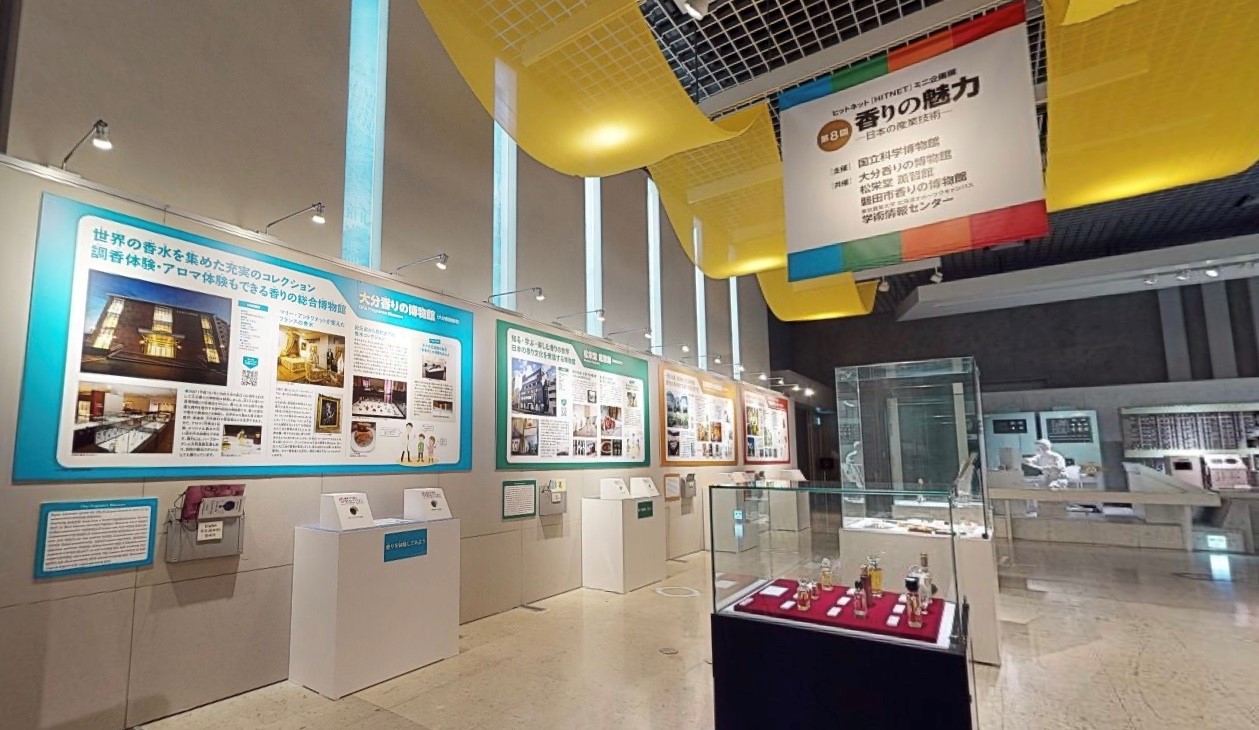

At National Museum of Nature and Science (Director: Yoshihiro Hayashi), a common database (Hitnet = HITNET) that can search materials from Japanese industrial museums has been constructed and made public.
In order to show that there are many industrial museums that possess and display materials related to industrial technology in various parts of Japan, we have selected from 155 hit net registered museums related to “fragrance”. We will hold a mini exhibition to introduce the museum.
Please enjoy the fragrance episodes, etc. exhibited at each museum.
While looking at the panels and exhibits, we hope you will enjoy the fun of seeing the history of technology and the industrial technology that has supported your daily life and nurtured a rich culture.
Outline of the 8th Hitnet mini project exhibition “Attractiveness of fragrances-Japanese industrial technology-“
※Currently, reservations are required for admission. Please be sure to visit the official website before visiting.
[Venue] 2nd floor of the National Museum of Science Earth Museum (7-20 Ueno Park, Taito-ku, Tokyo)
[Period] July 14th (Tuesday) to August 23rd (Sunday), 2020
[Opening hours] 9:00 to 17:00, but the following periods will be extended to 18:00.
・Friday from July 24, 2020 to the end of August ・Saturday
-July 23, 2020 (Thurs./holiday), August 8 (Sat.) to 16 (Sun.), 2020
[Closed] Every Monday (Tuesday if Monday is a holiday)
*However, there are no closed days during this event.
[Fee] Only the permanent exhibition admission fee can be viewed.
[Main Event] National Science Museum
[Co-sponsored] Oita Fragrance Museum (Beppu City, Oita Prefecture)
Shoeido Kaorukan (Kyoto City, Kyoto Prefecture)
Iwata City Aroma Museum (Iwata City, Shizuoka Prefecture)
Tokyo University of Agriculture Hokkaido Okhotsk Campus Academic Information Center (Abashiri, Hokkaido)




What is HITNET?
【In Hitnet = HITNET】, you can cross-search and browse the materials stored and exhibited by registered industrial museums all over Japan.
From the home page (http://sts.kahaku.go.jp/hitnet/ ), enter the keyword you are interested in and the corresponding information in the database will be displayed.
National Museum of Nature and Science

*Currently, reservations are required for admission. For more information, please visit the official website.
【Opening hours】 9:00 to 17:00, but the following periods will be extended to 18:00.
・Friday from July 24, 2020 to the end of August ・Saturday
-July 23, 2020 (Thurs./holiday), August 8 (Sat.) to 16 (Sun.), 2020
【Closed】 Every Monday (Tuesday if Monday is a holiday)
*However, there are no closed days during this event.
【Admission fee】 General/University students 630 yen
Free for high school students (including college students) and under 65 years old
【Location】 7-20 Ueno Park, Taito-ku, Tokyo 110-8718
【Contact】 Hello Dial: 03-5777-8600
National Science Museum: https://www.kahaku.go.jp/
Industrial Technology History Information Center: http://sts.kahaku.go.jp/
Article provided by Kokosil Ueno
See other exhibition information
Kanda Hakusan (Kanda Matsunojo renewed),
Lol problem appeared!
「2nd Edo Town Taito Geigaku Festival」
Closing Event Experience Report
Taito Ward Asakusa Public Halll
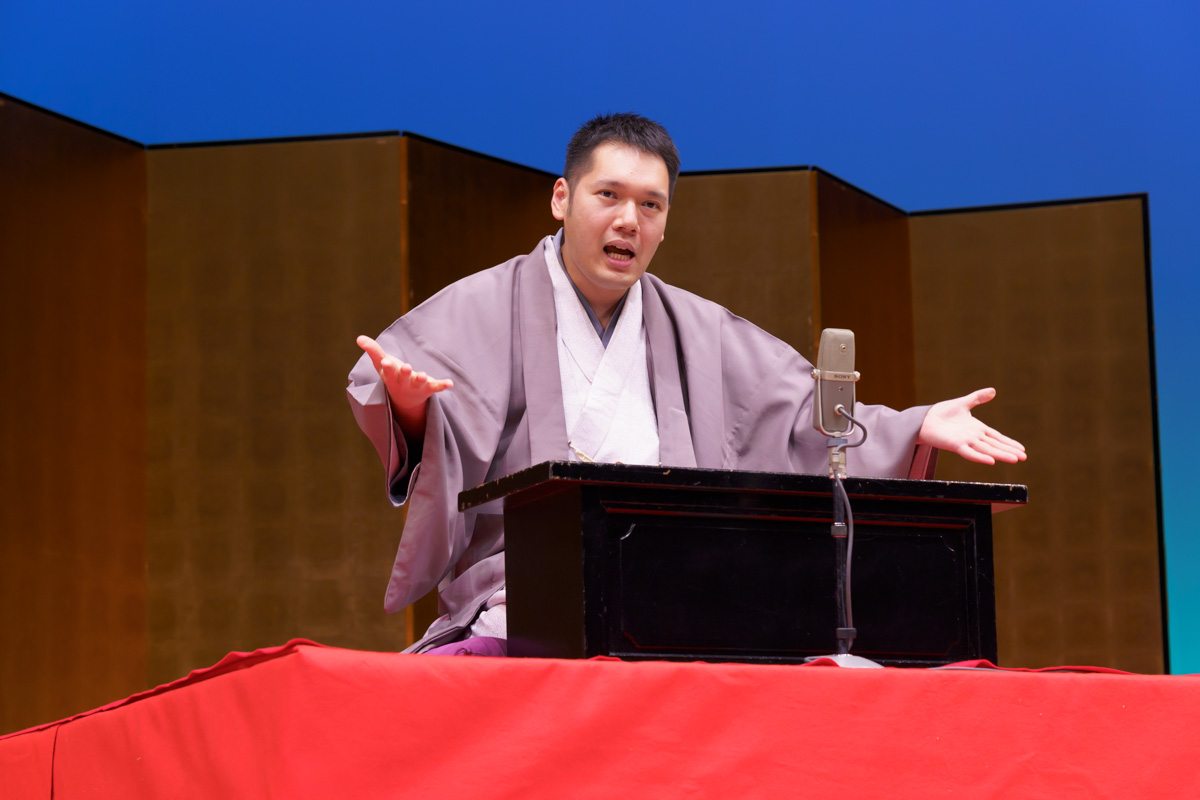
Starting from the outdoor screening of the opening event “『Bohemian Rhapsody』 on August 18.2019.the 「2nd Edo Machi Taito Geigaku Festival"」is still a great success.and the closing event 『Geigasane Maigasa』 I met!
This time, we have covered the event that took place on February 15, so please take a look.
Opening ceremony
The closing event of the 「2nd “Edo Town Taito Geigaku Festival」 started with the opening ceremony.
The ceremony began with greetings from Mr. Yasuhisa Watanabe, Chairman of the Edo Machitoto Geito Festival, Mr. Yukio Hattori, Mayor of Taito City, and Mr. Takeshi Ishizuka, Chairman of the Taito City Assembly.
After the photo session by the performers, each program starts.
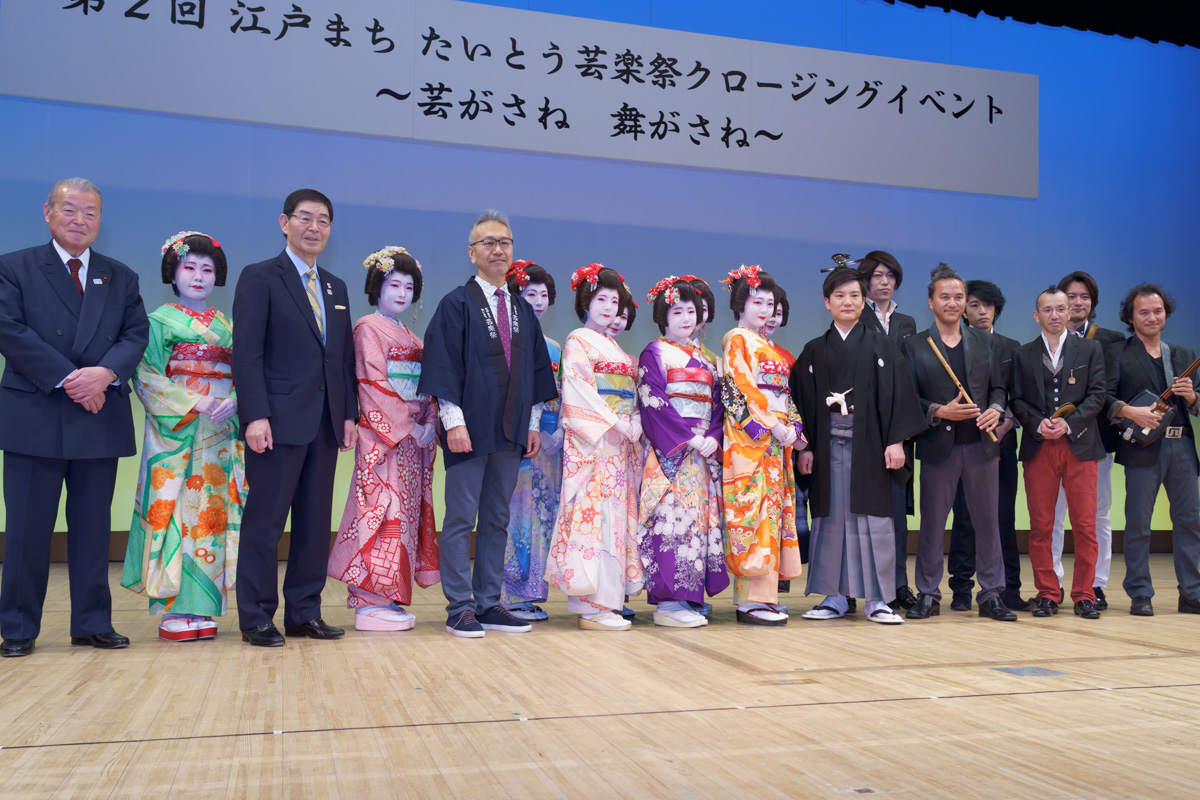
Flower kimono dance Asakusa Hanayashiki flower kimono
The closing event is
It started with the dance of the flower kimono by Asakusa Hanayashiki Kimono.
Nine dancers who play an active part in Asakusa Hana Theater dance supplely on the stage using handkerchiefs, umbrellas and fans.
The movement is like a petal swaying in the spring breeze.
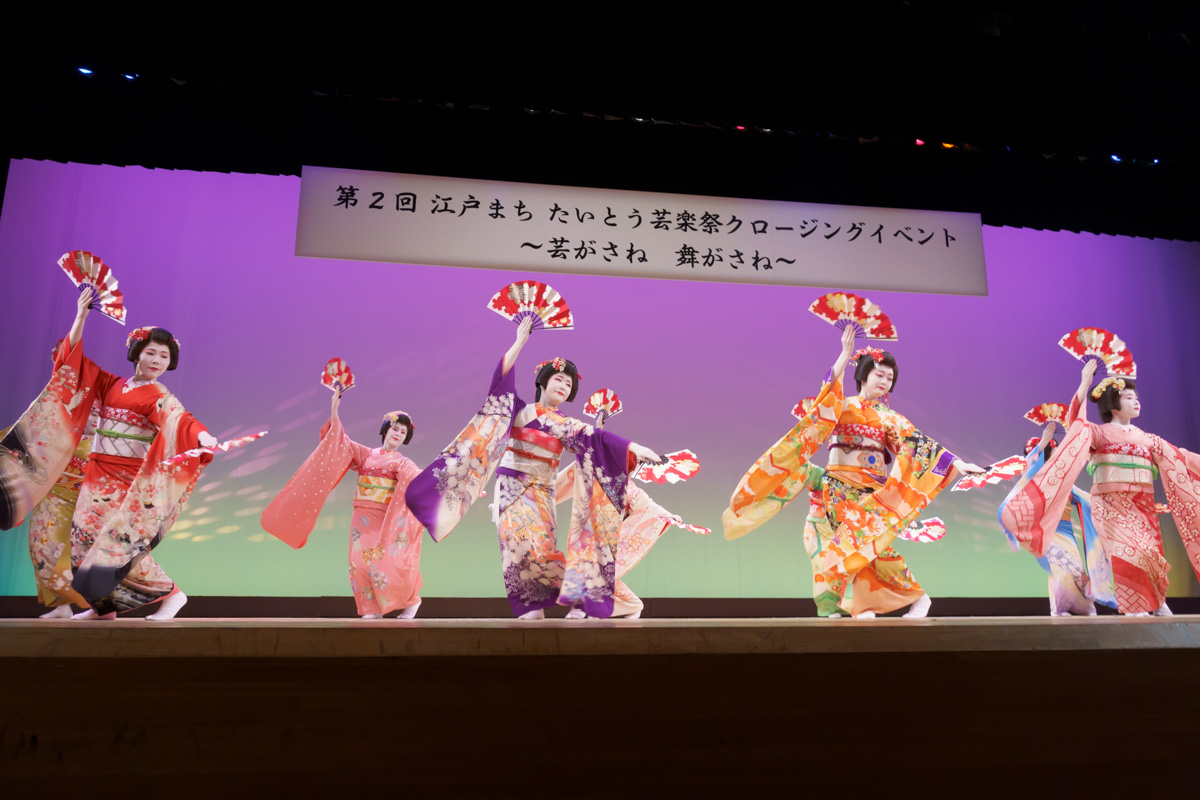
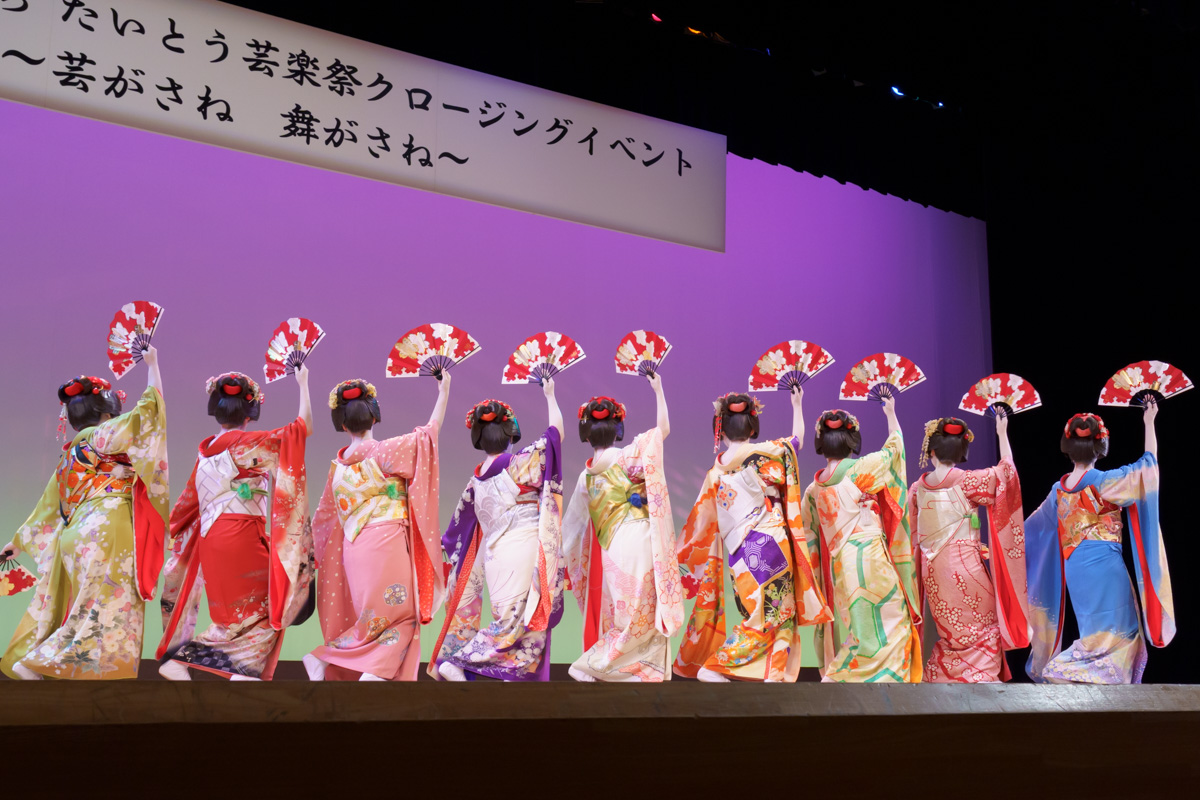
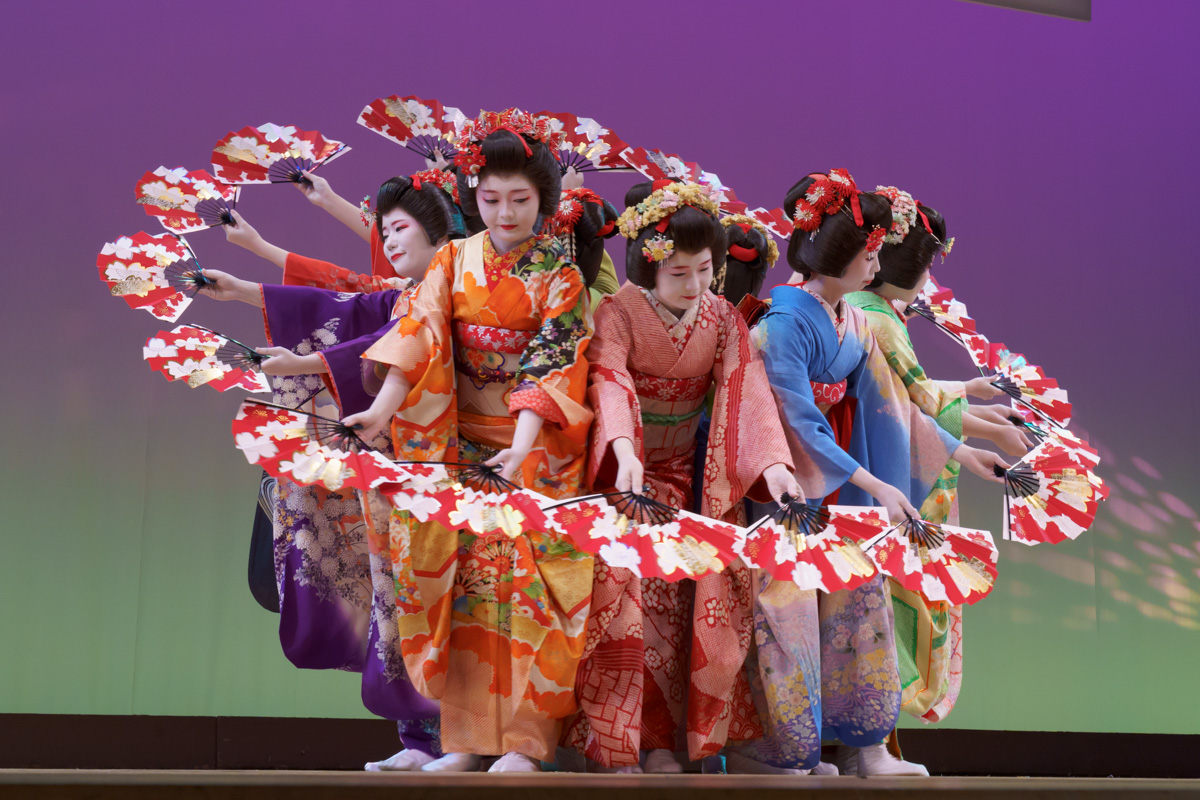
Kodan Hakusan Kanda
This is the 6th generation of Kanda Hakusan, who has been promoted to earnest hit on February 11 this year.
It has been featured in various media and is now the hottest lecturer who can’t get a ticket, Hakusan Kanda.
“I heard that it was overcrowded, but there are some places available.”
“It is said that you have to do” Genpei Morning and Oki Ogi no Target “for about 30 minutes. I don’t want to do that much.”
When saying that, the venue is in a whirlpool of laughter.
After grabbing the customer’s heart with a slightly longer macula,
“The reason why she talked so much is that the main story is so short!”
With the momentum and power of the talks of Hakusan who folds steadily, the audience at the venue will be more and more drawn in without having time to breathe.
The talk goes on in a fast-paced narrative. At that time,
“What a time! Time has come!”
I thought, without putting a break,
“But I’m not going tomorrow! May I tell you more about this?”
The talk resumes with great applause.
And fold it to the end,
“To commemorate your well-being and good luck, your target (Mato) may be a big hit!”
Finally, the venue was wrapped in great applause.

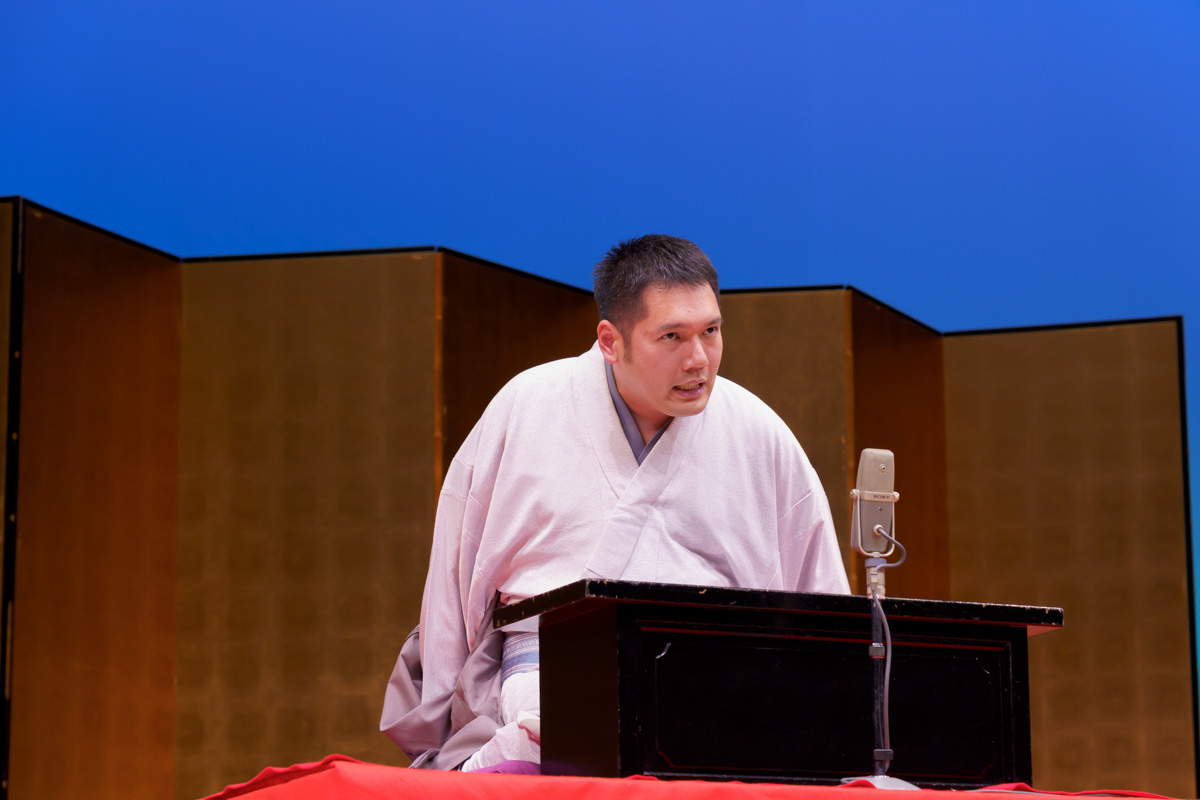
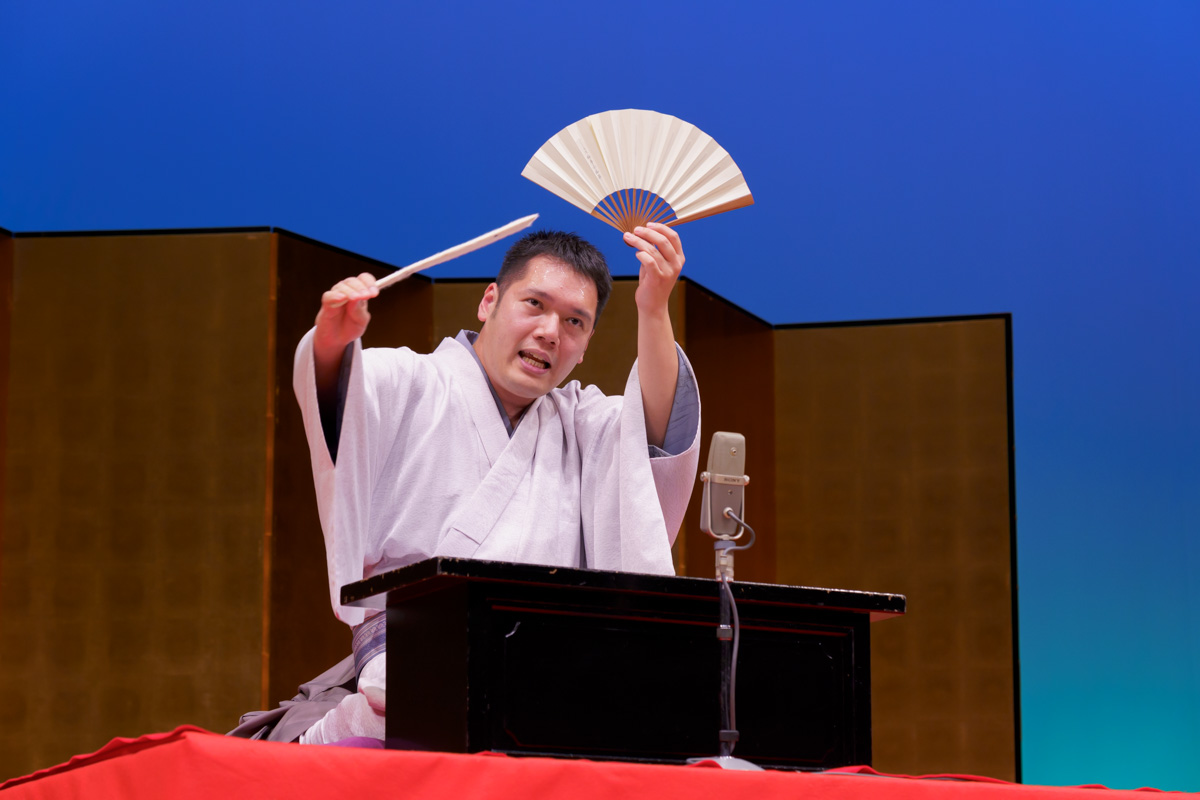
Tezuma (wazuma) Daiki Fujiyama
Next is Daiki Fujiyama, one of the few Tezuma teachers who instructs Shintaro Fujiyama as a teacher and inherits the country’s intangible cultural property, Tezuma (wazuma).
He shows his Tezuma overseas and spreads Japanese traditional culture around the world.
“Tezuma” is said to be a twiz because it moves his hands as fast as lightning.
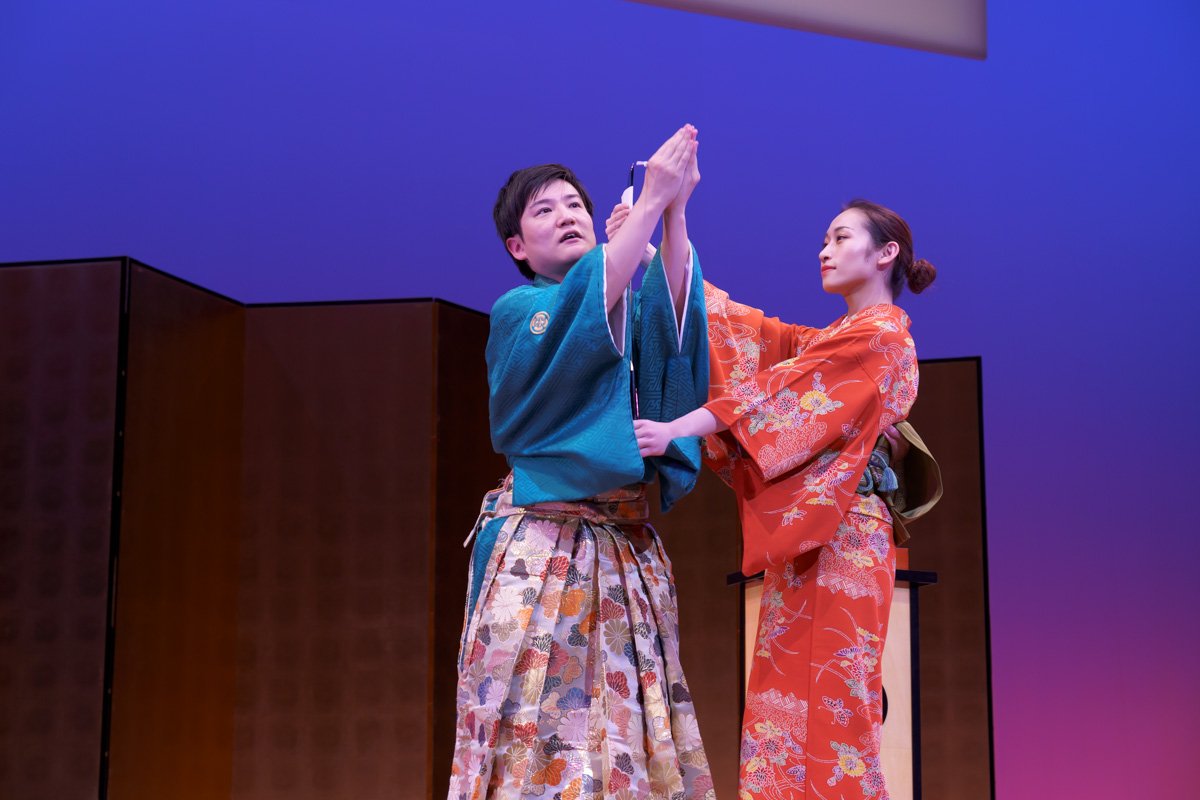
No matter how many times you pass through the sword, it won’t cut off mysteriously.
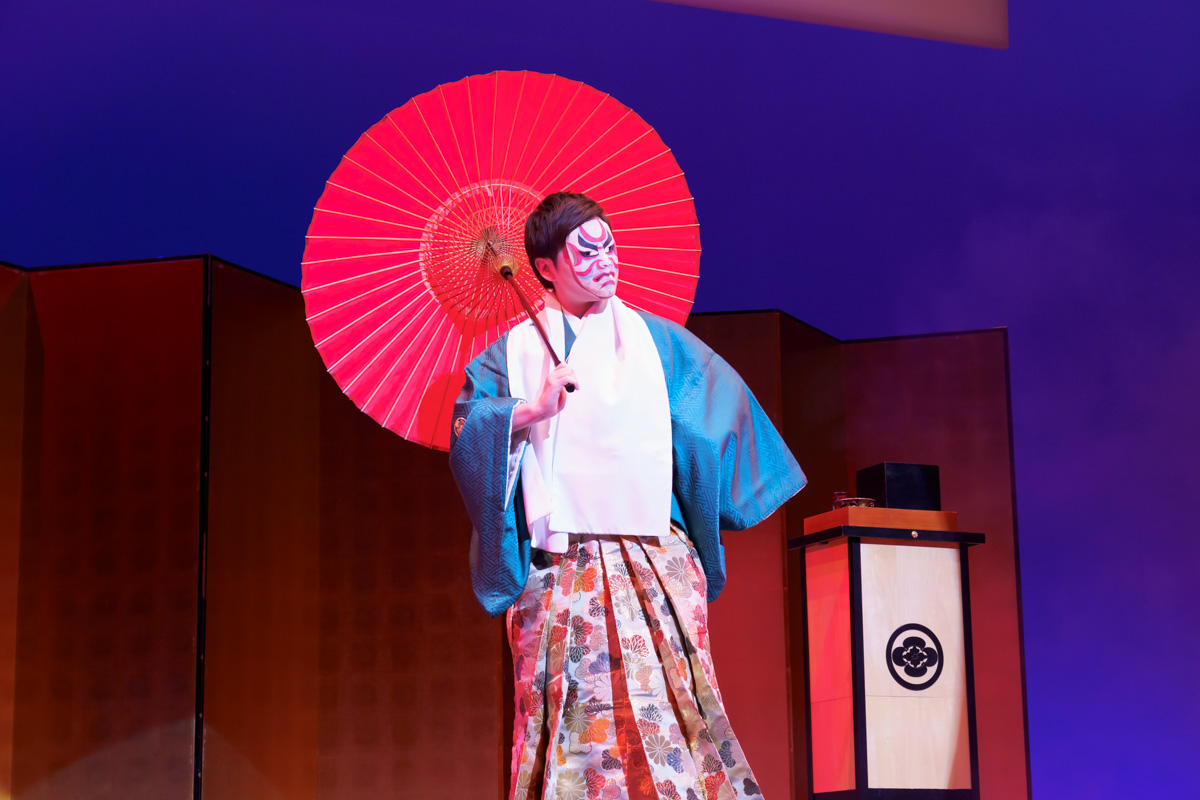
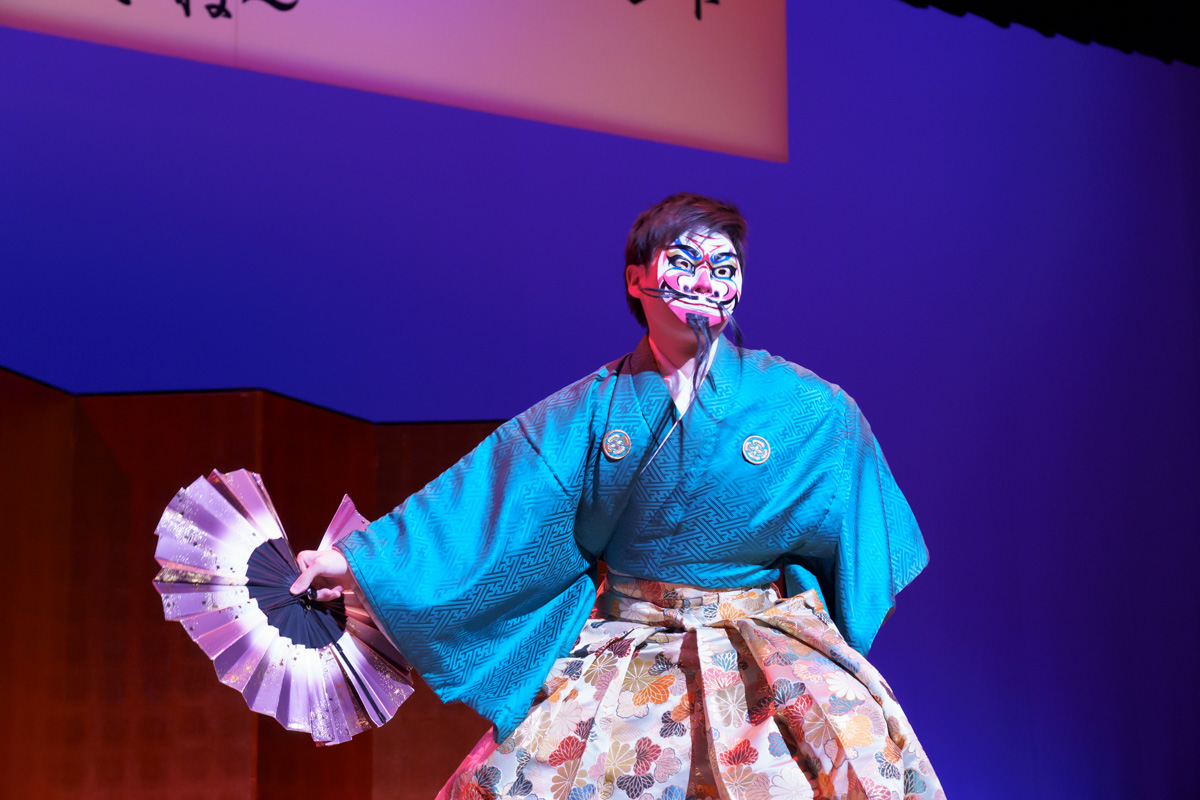

Japanese musical instrument performance AUN J Classic Orchestra
This is a Japanese musical performance by AUN J Classic Orchestra, a unit of Japanese musicians active in the front line of each instrument.
He has performed well at world heritage sites such as Angkor Wat and Mont Saint Michel, and has earned a high reputation overseas.
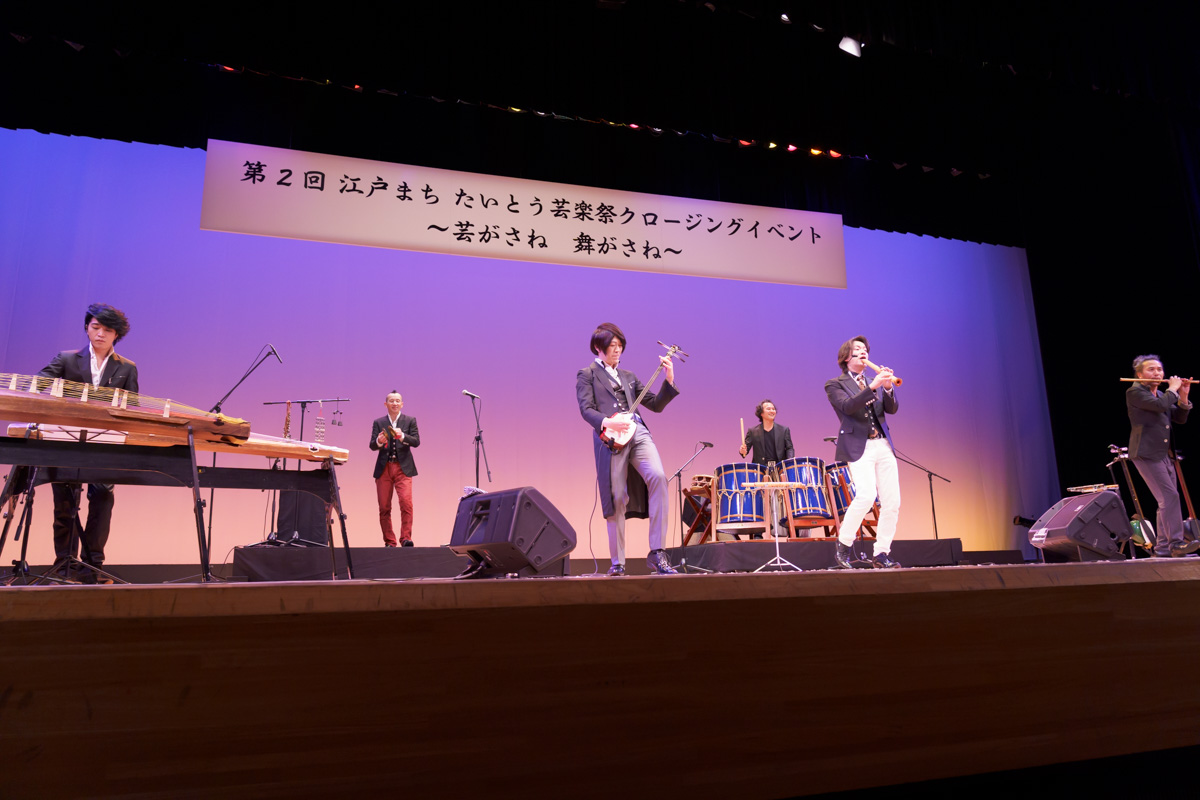
An ensemble of six Japanese musical instruments that fit perfectly will shake the venue.

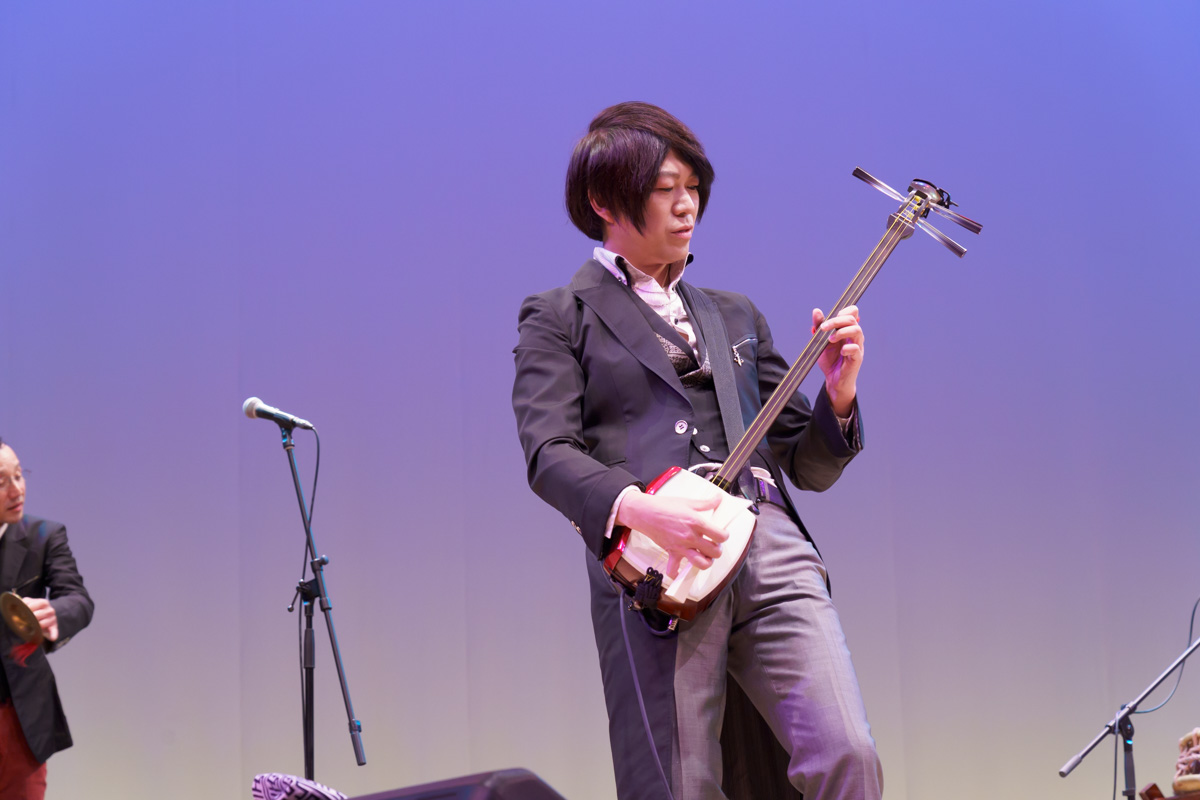
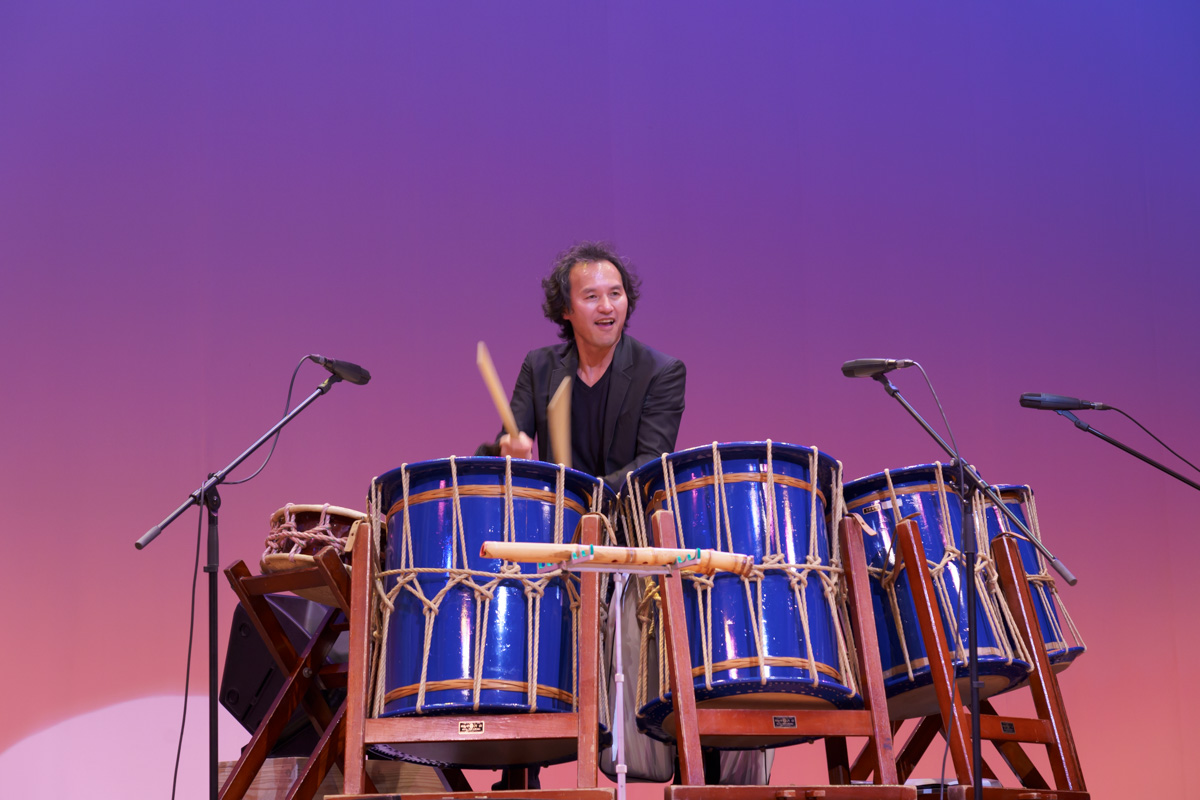
Manzai Lol problem
It is two people with a Lol problem that decorate the big bird at the closing event and the “2nd Edo Town Taito Festival”.
With a poisonous tongue, I slashed the current topical story that can not be broadcast by terrestrial broadcasting and invited the laughter of the venue.
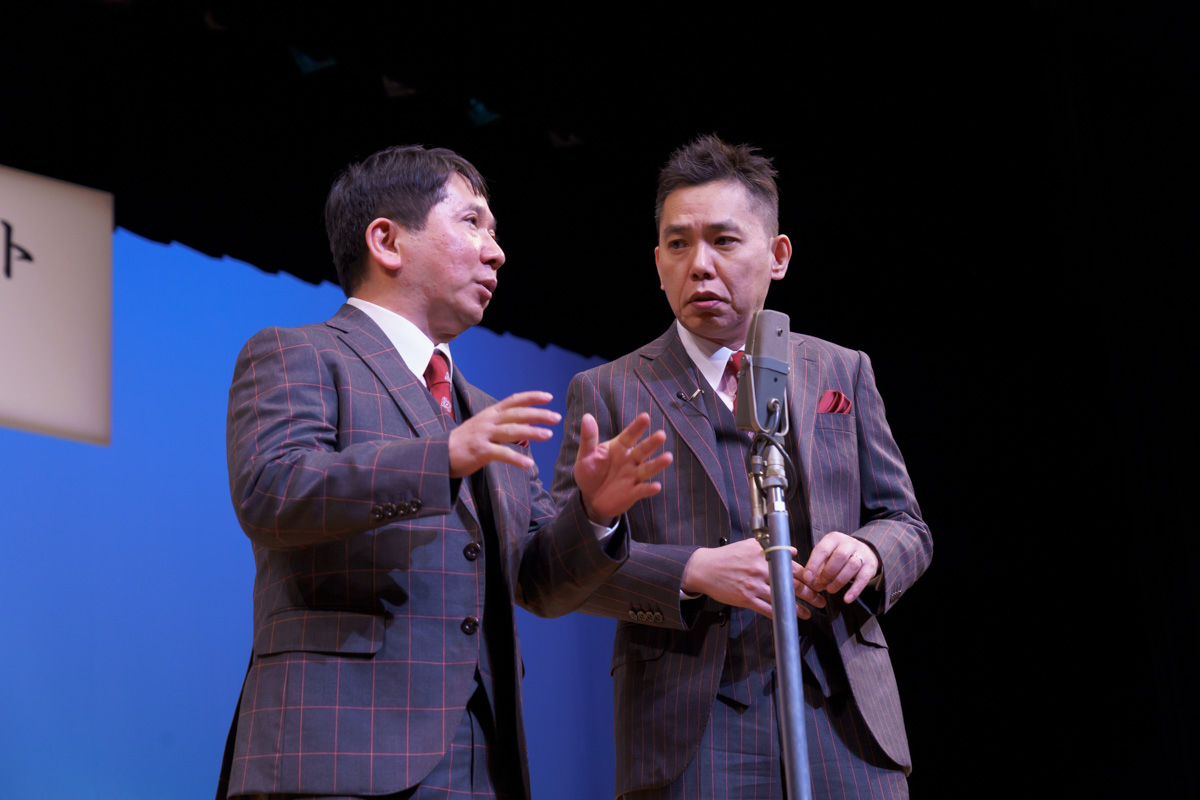
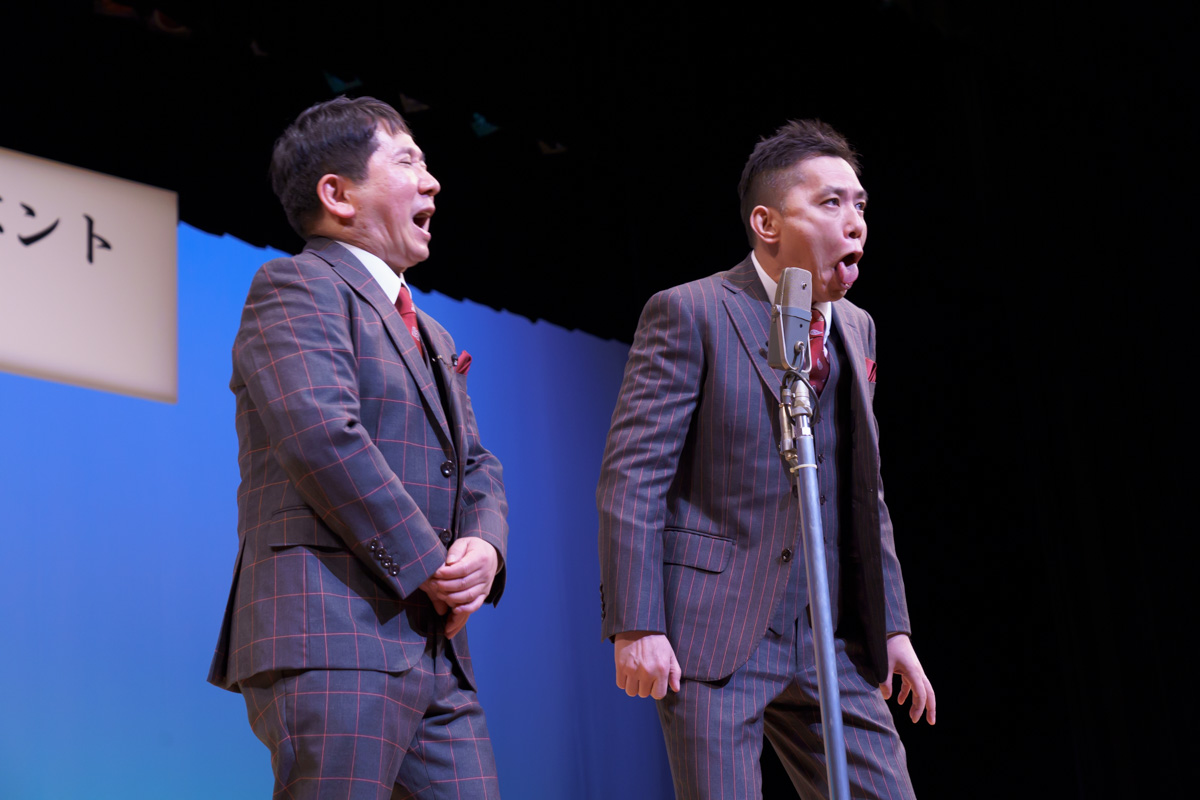
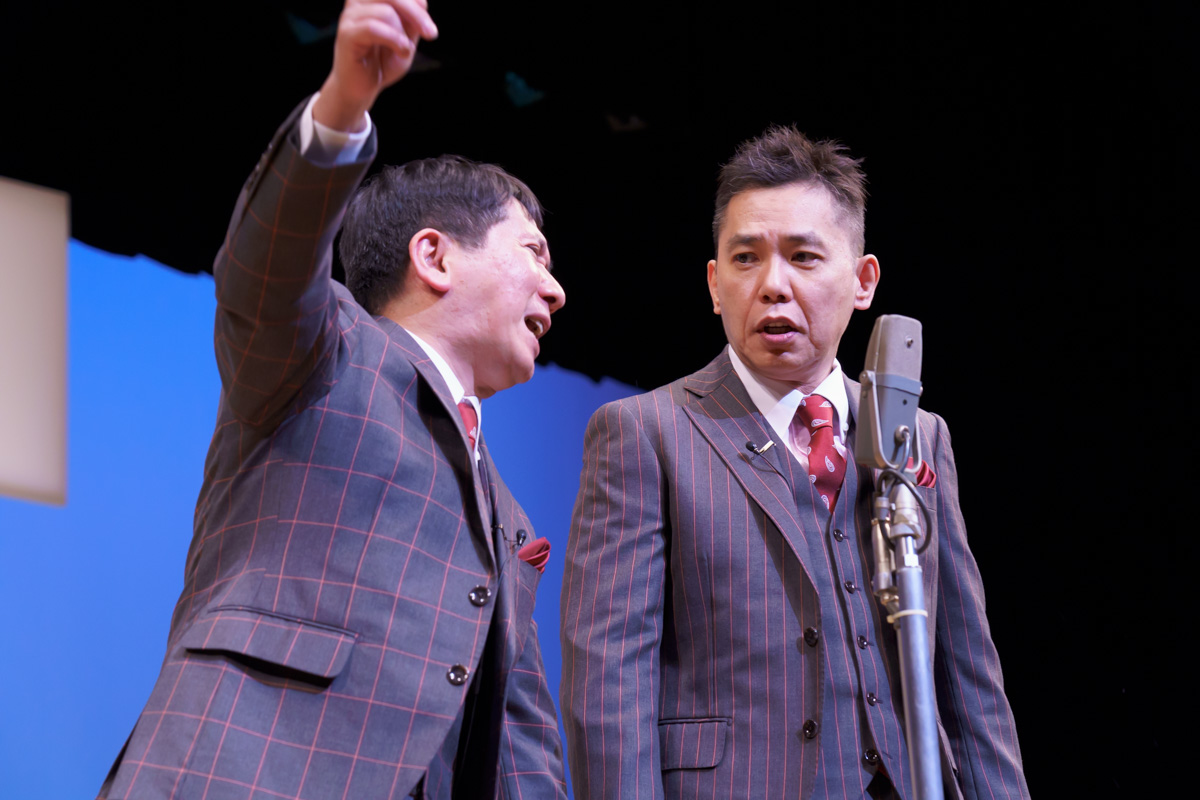
Finale
The last was a towel by the performers.
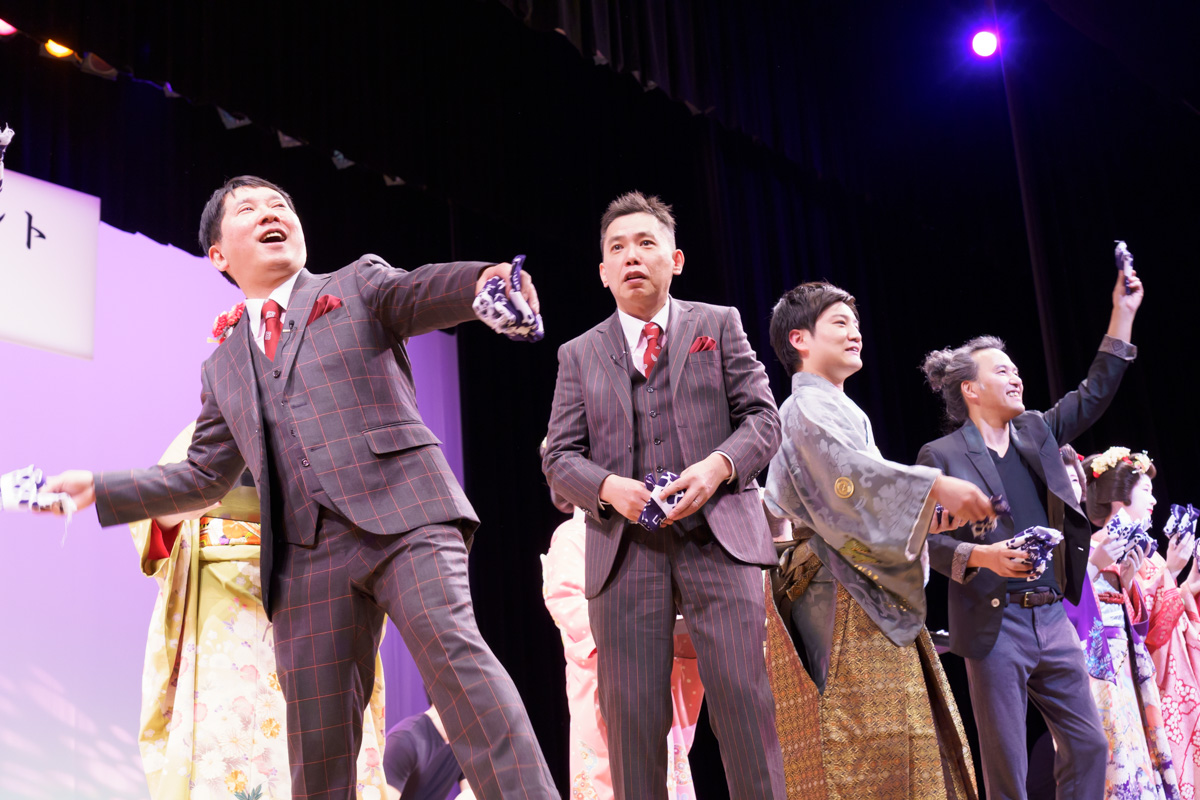
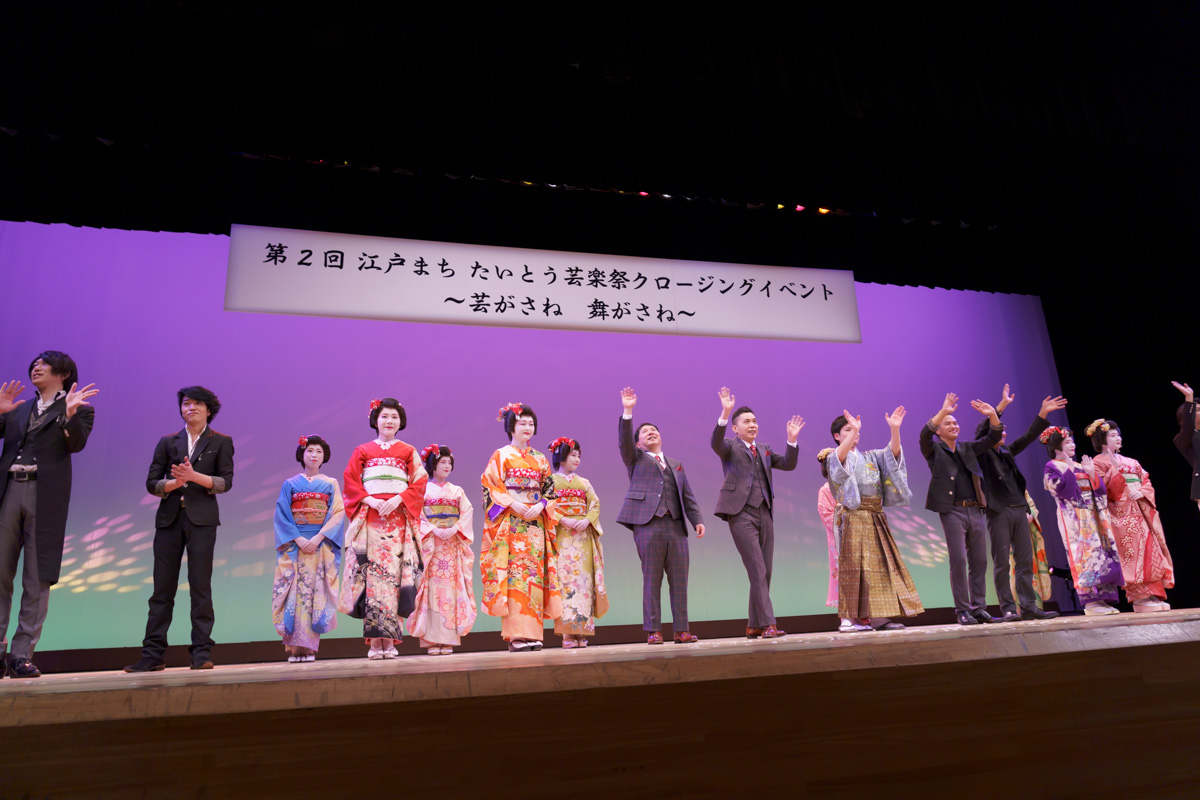
With great applause, the closing event of the “2nd Edo Town Taito Geisha Festival” has ended.
Conclusion
We reported on the experience report of the “2nd Edo Town Taito Festival” closing event.
Isn’t the stage where dancers, talk arts, and Japanese musical instrument performances were gathered together, and the contents of the talks were just right to add flowers to the closing event?
「The 2nd Edo Machitoto Geiku Festival」, which has enlivened Taito Ward with various performing arts and arts culture for about half a year, has now closed its doors.
Tokyo National Museum 「Looking for Cherry Blossoms at the Museum」March 10 (Tue)-April 5 (Sun) 2020!
Tokyo National Museum
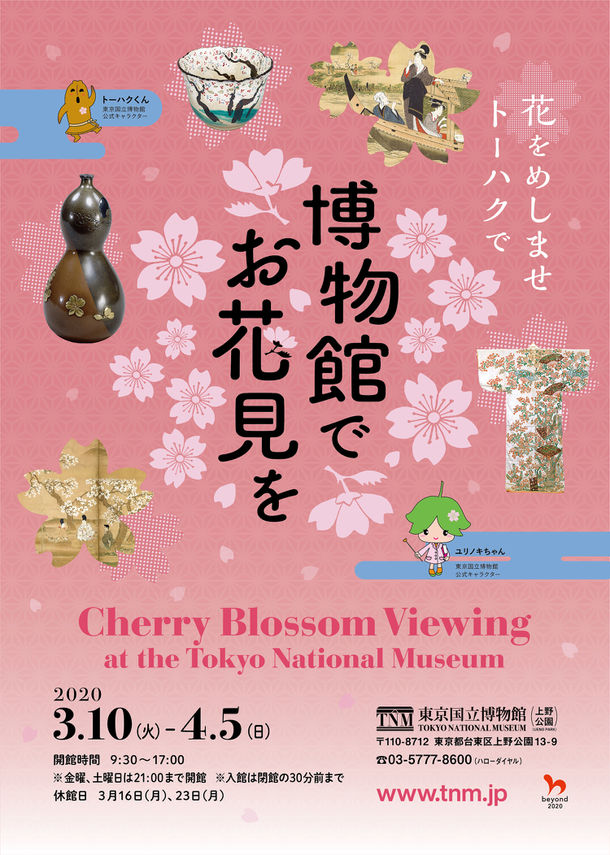
The Tokyo National Museum will also hold the annual spring event, “Let’s enjoy cherry blossom viewing at the museum.”
In each exhibition room of the main building, various Japanese art masterpieces with cherry blossom motifs are in full glory.
In addition, you can enjoy about 10 kinds of cherry blossoms in the garden on the north side of the main building.
In addition, related events such as gallery talks and quiz rally will be held.
Please enjoy the special cherry blossom viewing unique to Tohaku.
■ Main building cherry blossom tour
In the main building, various works related to cherry blossoms will be exhibited, such as paintings depicting cherry blossoms, such as the “Kanza-zuburo folding screen”, crafts based on cherry blossoms, and ceramics.
The caption of the work is marked with cherry blossoms, so please find your favorite cherry blossoms in the exhibition room.
◆ Main works on display * All works are from the Tokyo National Museum
Main building 7 rooms
Cherry blossom viewing screen
Keisuke Sumiyoshi, Edo period, 17th century
Donated by Kenji Nishiwaki
Exhibition period: March 24 (Tue)-April 19 (Sun)
https://www.atpress.ne.jp/releases/205579/img_205579_1.jpg
From “Ise Monogatari”, I will draw the princes Kotaka and Korihei Arihara, who sing songs celebrating the cherry blossoms.
Main building 8 rooms
Gourd sake brewing
Ichinoto Funada, Edo period, Tenpo 14 (1843)
Exhibition period: Tuesday, January 28-Sunday, April 19
https://www.atpress.ne.jp/releases/205579/img_205579_2.jpg
Liquor made of various metals such as silver, copper, alloy of silver and copper.
The cherry blossoms are three-dimensionally carved and plated with copper.
Main building 8 rooms
Cherry blossoms in color picture cherry tree
Namiami Hachisaku Edo period, 19th century
Exhibition period: Tuesday, January 28-Sunday, April 19
https://www.atpress.ne.jp/releases/205579/img_205579_3.jpg
If you look inside and outside the bowl at the same time from a little diagonally above, you can feel the cherry blossoms in full bloom.
Main building 8 rooms
Color picture cherry tree plate (Iroe Ujizusara)
Nabeshima Edo period, 18th century
Exhibition period: Tuesday, January 28-Sunday, April 19
https://www.atpress.ne.jp/releases/205579/img_205579_4.jpg
The composition is such that the branches circulate along the circle, and the cherry blossoms bloom in full detail on the surface.
Main building 10 rooms
Sumida River cherry blossom viewing boat
Utagawa Kunimasa brush Edo period, 19th century
Exhibition period: March 17 (Tue)-April 12 (Sun)
https://www.atpress.ne.jp/releases/205579/img_205579_5.jpg
Women playing on a boat and visitors heading to Yoshiwara.
In the distance, you can also see the famous cherry blossoms, Sankei Shrine.
Main building 10 rooms
Kosode Rinko Shichiwakamatsu cherry blossom curtain design
(Let’s do it!)
Edo period, 18th century
Exhibition period: Wednesday, February 26-Sunday, April 19
https://www.atpress.ne.jp/releases/205579/img_205579_6.jpg
The pattern of hanging cherry blossoms in full bloom is reminiscent of the Tale of Genji and the Hananoen volume.
Main building 13 rooms
Cherry Blossom Phoenix Figure Tsuba
Tsukada Hidekami Meiji 3 (1870)
Exhibition period: March 10 (Tue)-June 14 (Sun)
https://www.atpress.ne.jp/releases/205579/img_205579_7.jpg
The cherry blossoms in full bloom in the tsuba and the flying phoenix make you feel a gorgeous spring.
■ Spring garden opening
Open the garden on the north side of the main building at the time of the cherry blossoms (not in the tea room).
In addition, a cafe will be opened temporarily during the period.
After watching the cherry blossoms in the exhibition room, enjoy a relaxing cherry blossom viewing in the garden.
March 10 (Tue)-April 19 (Sun) 10: 00-16: 00
https://www.atpress.ne.jp/releases/205579/img_205579_8.jpg
* May be canceled due to bad weather.
* Because the garden will be partially constructed, the access area may be restricted.
◆ Sakura light up
On Friday and Saturday during the spring garden opening period, the garden will be lit up until 19:30.
■ Sakura event
* Those who do not have the advance application system are not required to apply in advance and are free to participate. (However, admission fee on the day is required)
◆ Sakura Gallery Talk
Cherry blossoms blooming in a bowl
I will explain the cherry blossoms displayed on ceramics.
Date: March 17 (Tue) 14: 00-14: 30
Lecturer: Atsushi Imai (Director, Museum Information Section)
Location: Main building basement green lion (educational space)
Sakura drawn in Buddhist painting
Cherry blossoms are also drawn in Buddhist paintings with landscape description.
I will talk about flowers in Buddhist paintings, not just lotus.
The date and time: Tuesday, March 24 from 14:00 to 14:30
Lecturer: Kenjiro Okimatsu (Director of Painting and Sculpture)
Location: Main building basement green lion (educational space)
◆ Sakura Appreciation Guide
Introducing the highlights of the cherry blossom work in a digest。
Date: March 31 (Tue) 14:00-14:30
Lecturer: Fumiko Abe (Associate Fellow, Educational Lecture Room)
Location: Main building basement green lion (educational space)
◆ Sakura Seminar
Gold and silver raden flowers
We will introduce how to enjoy the season created by lacquer and gold.
Date: April 4 (Sat) 13: 30-15: 00 (Scheduled to open at 13:00)
Lecturer: Osamu Fukushima (crafts room researcher)
Venue: Heiseikan Auditorium Capacity 380 (first come, first served)
◆ Guided tour by volunteers
We will introduce you to “Tohaku Cherry Blossom” with various themes, such as works related to cherry blossoms and cherry blossoms on the premises.
* Please check the date and the theme on our website.
◆ Higaku Bakukai “One Chance in Cherry Blossom”
We are looking for haiku with the theme of works with cherry blossom gardens and cherry blossoms.
Please submit your application by posting it to the posts set up in four places on the premises of this museum.
Winning works will be announced on the Tokyo National Museum News September-November issue and on our website, and will be presented with a souvenir.
* Received every day during the “Hanami at the Museum”
◆ Sakura Workshop Spring Ranman Sakura Coloring
This is a workshop where you can create your own unique spring-like work by coloring the works with cherry blossoms as a motif.
The date and time: Friday, March 27-Tuesday, March 31
Every day from 11:00 to 16:00 * Ends as soon as the coloring sheet runs out
Venue: Main Building 2F Lounge
◆ Sakura Quiz Rally
Take 5 quizzes around the exhibition room.
An original badge will be given to all those who answered correctly.
Held every day during “Hanami at the Museum”
There are two types of badges available.
* Distribution of mounts and exchange of badges: Main building entrance
(Badge exchange from 10:00 to closing time)
Original can badge (2020 limited design)
https://www.atpress.ne.jp/releases/205579/img_205579_9.jpg
◆ Art Studio Advance Registration System
Cherry netsuke making
After observing the netsuke of the main building’s 10 rooms and the Takamado Collection room, we will process clay and create an original netsuke with the theme of cherry blossoms.
You can take the finished work home.
The date and time: Saturday, March 28 13: 30-15: 30
Venue: Main Building Basement Green Lion (Educational space)
Target: High school students and above
Capacity: Approximately 20 people (in case of many applicants, lottery)
Participation fee: Free (except high school students, those aged 18 to under 70 must pay the entrance fee on the day)
Application deadline: Must arrive on Tuesday, February 25
◆ Garden tea room tour prior application system
Let’s enter the Soan tea room!
We will explain the highlights of the tea house in the garden.
You will be guided to the inside of “Rokusoan” and “Tengouan” which are not entered in a regular guided tour.
* May be canceled in bad weather
The date and time: Thursday, March 19 from 11:00 to 12:00
Capacity: 16 people (in case of many applicants, lottery)
Participation fee: Free (except for high school students, those aged 18 to under 70 must pay the entrance fee on the day)
Application deadline: Must arrive by February 17 (Mon) (Application has been closed)
◆ Tea ceremony at Okyokan prior application system
Okyokan (Okyokan) Sakura Tea Party
It is a tea ceremony in the garden Okyokan.
Enjoy the tea with seasonal sweets while watching the cherry blossoms and Maruyama Okyo barrier paintings (reproductions).
* May be canceled in bad weather
Date and time: Sunday, March 29 (1) 11: 00-12: 00 (2) 13: 00-14: 00 (same content each time)
Capacity: 15 people each time (in case of many applicants, lottery)
Participation fee: 500 yen (However, those aged 18 to under 70, excluding high school students, require a separate admission fee on the day)
Application Deadline: Must arrive on Wednesday, February 19 (Application has been closed)
* For events that require advance registration, please check the website for how to apply.
◆ Concert
Concert of cherry blossom town
A free mini-concert will be held by participating artists in the “Tokyo Spring Music Festival”.
(However, admission fee is required on the day)
▼ April 2 (Thursday)
10: 30-10: 50 Front gate
Vive! Saxophone Quartet (Saxophone Quartet)
13: 00-13: 20 Horyuji Treasures Entrance Hall
Kiyoshi Ishii (flute) & Kazuya Okamoto (guitar)
▼ April 7 (Tue)
13:00-13:20 Main building entrance
Kaoru Oe (violin)
Organizer / Contact: Tokyo / Spring / Music Festival Executive Committee (TEL: 03-5205-6497)
Website: https://www.tokyo-harusai.com/
[Visitor Information]
Opening hours: 9: 30-17: 00 (open on Fridays and Saturdays until 21:00; admission until 30 minutes before closing)
Closed: March 16 (Mon), March 23 (Mon)
Admission fee: The admission fee will be revised from Wednesday, April 1, 2020
● Until Tuesday, March 31, 2020
<General>
620 yen (520 yen)
<University student>
410 yen (310 yen)
● From Wednesday, April 1, 2020
<General>
1,000 yen
<University student>
500 yen
* Parentheses in parentheses indicate group rates for more than 20 people.
* Free for high school students and younger, under 18 years old, 70 years old or older (Please show the age when you enter)
* Free for disabled people and one of their caregivers (Please present a handbook for the disabled when entering the museum)
* If you are traveling with children (high school students or younger and under 18 years old) (up to 2 companions per child), you can view at a group fee.Abolished from April 1 (Wed)
* Extra charge for special exhibition “Horyu-ji Kondo Mural Painting and Baekje Kannon” (March 13 (Fri)-May 10 (Sun))
Access: 10 minutes on foot from JR Ueno Station Park Exit and Uguisudani Station South Exit
15 minutes on foot from Tokyo Metro Ueno Station, Nezu Station, Keisei Electric Railway Keisei Ueno Station
Inquiries: 03-5777-8600 (Hello dial)
Website: https://www.tnm.jp/
Article provided by:Kokosil Ueno
See other exhibition information
May 2020 At last、the Arc de Triomphe in Tokyo! ! Noritake Kinashi Exhibition II-National Museum Tour of 20 venues in Japan starting with London-
The Ueno Royal Museum

Starting from the Osaka venue in July 2018, “Kinashi Noritake Exhibition”, which is holding his second national museum tour, will finally return to Tokyo (The Ueno Royal Museum) as the 15th venue in 2020. 。
Focusing on the latest works of the “OUCHI series” which started production at the New York solo exhibition in 2015 and the “REACH OUT series” first shown at the London solo exhibition in 2018,
In June 2014, the popular work of “Kenashi Noritake Exhibition x 20years”, which mobilized about 100,000 people in just 20 days at the Ueno Royal Museum, was not only painting, but also works based on free ideas such as drawings, images, and objects 150 Exhibit more than points。
It is an exhibition like “Kinashi Noritake” that makes viewers happy with bright and free ideas and expressions.
Highlight
● Kinashi himself displays all works! An art exhibition with a different atmosphere for each venue!
The decision of the exhibition method at all venues is Noritake Kinashi.
It is an art exhibition like a live show that can be enjoyed by those who have already seen it and those who are new to it.
From small children to adults, you can enjoy with a smile regardless of age or gender.
● More than 150 exhibits including new works
In a busy day, Kinashi continues to work even after finding time.
During the traveling exhibition, new works are added and existing works are reworked.
A new work will be announced at the Tokyo venue.
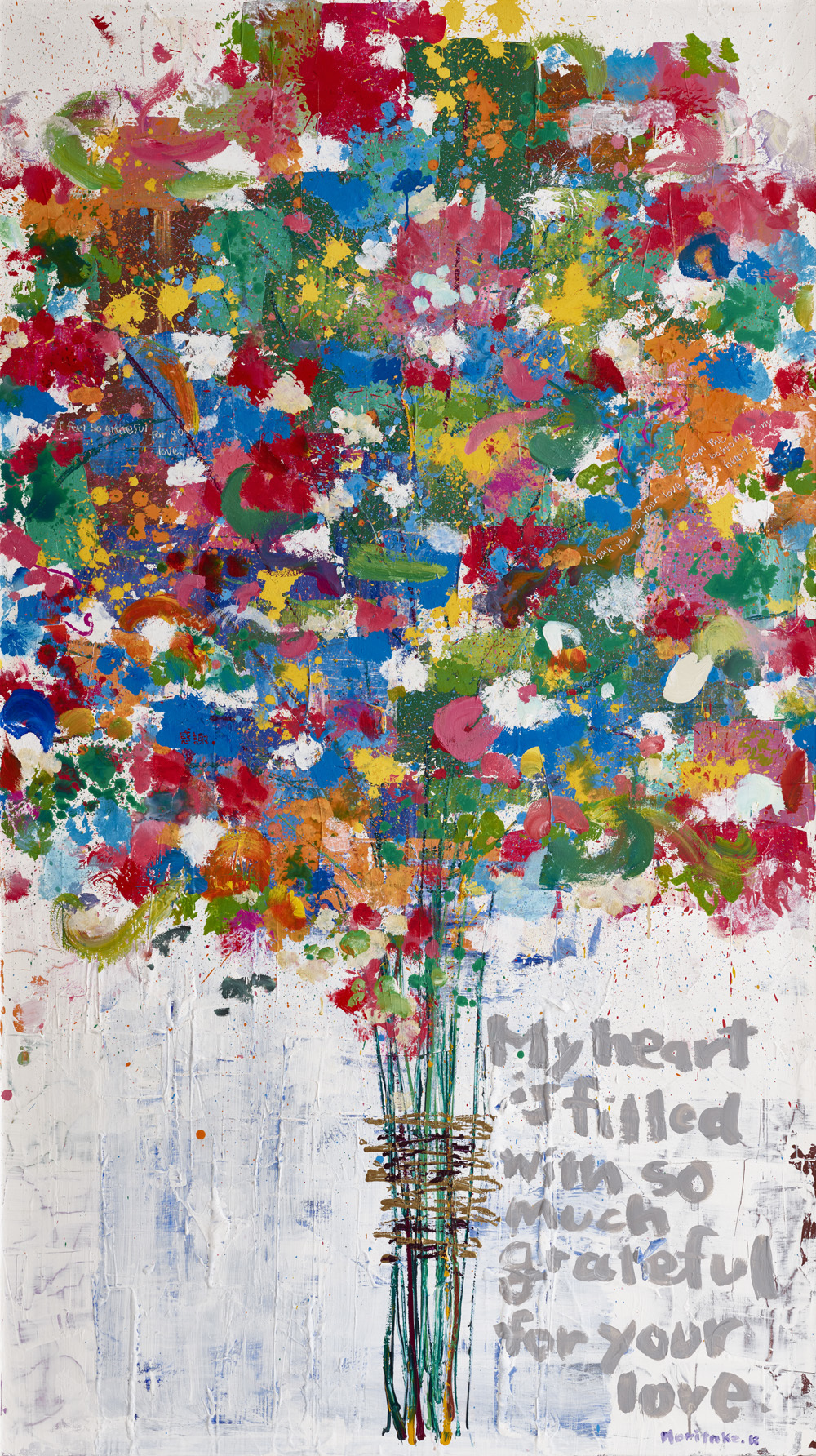
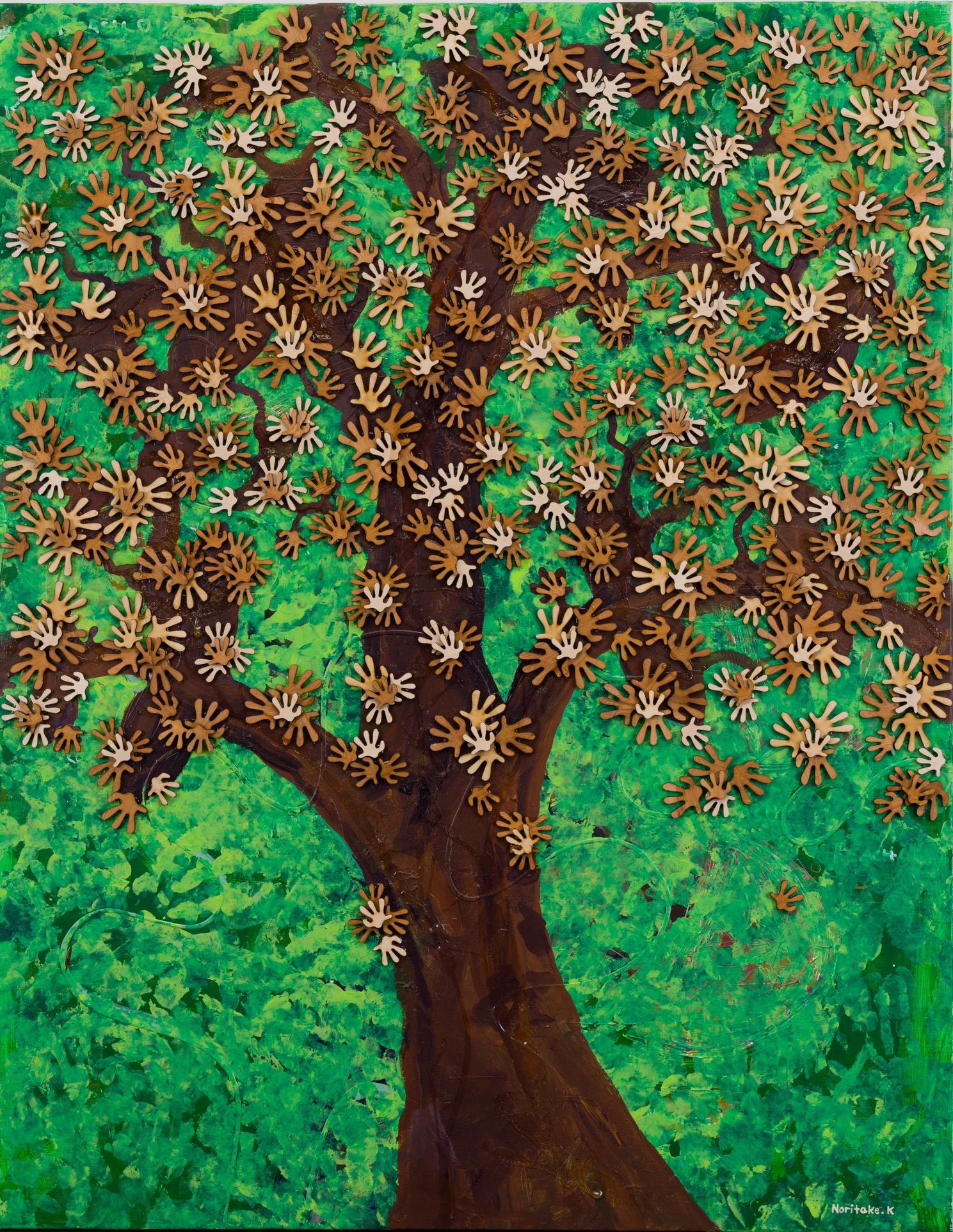
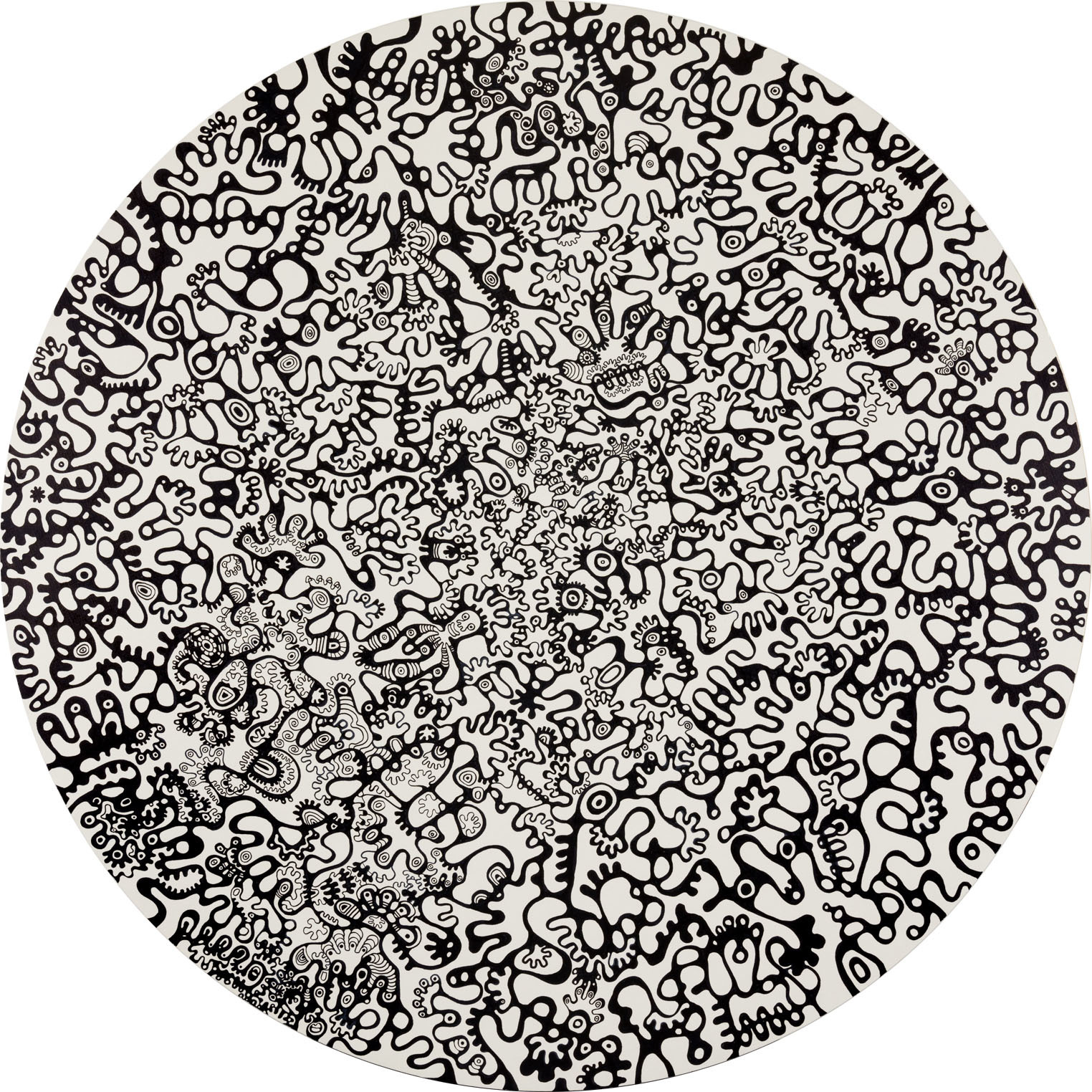
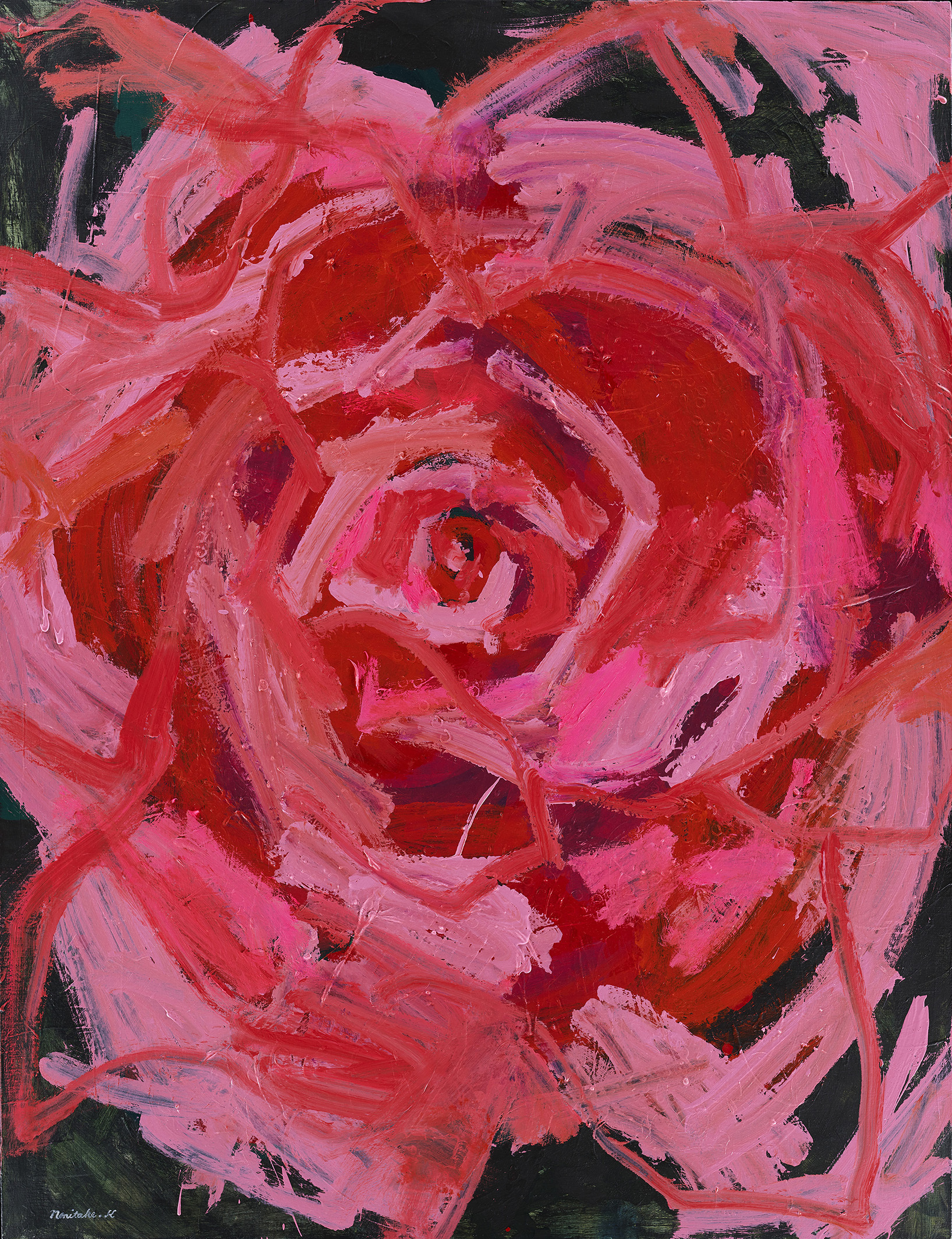
● Abundant goods and audio guides
The audio guide will guide you to Kinashi World in a light-hearted conversation and talk with a talented and film critic LiLiCo.
In addition, abundant exhibition limited goods are also available.
Please enjoy the fun atmosphere of the exhibition at home.
■ Audio guide Time required: about 40 minutes / Rental price: 600 yen (tax included)
Message from Noritake Kinashi:
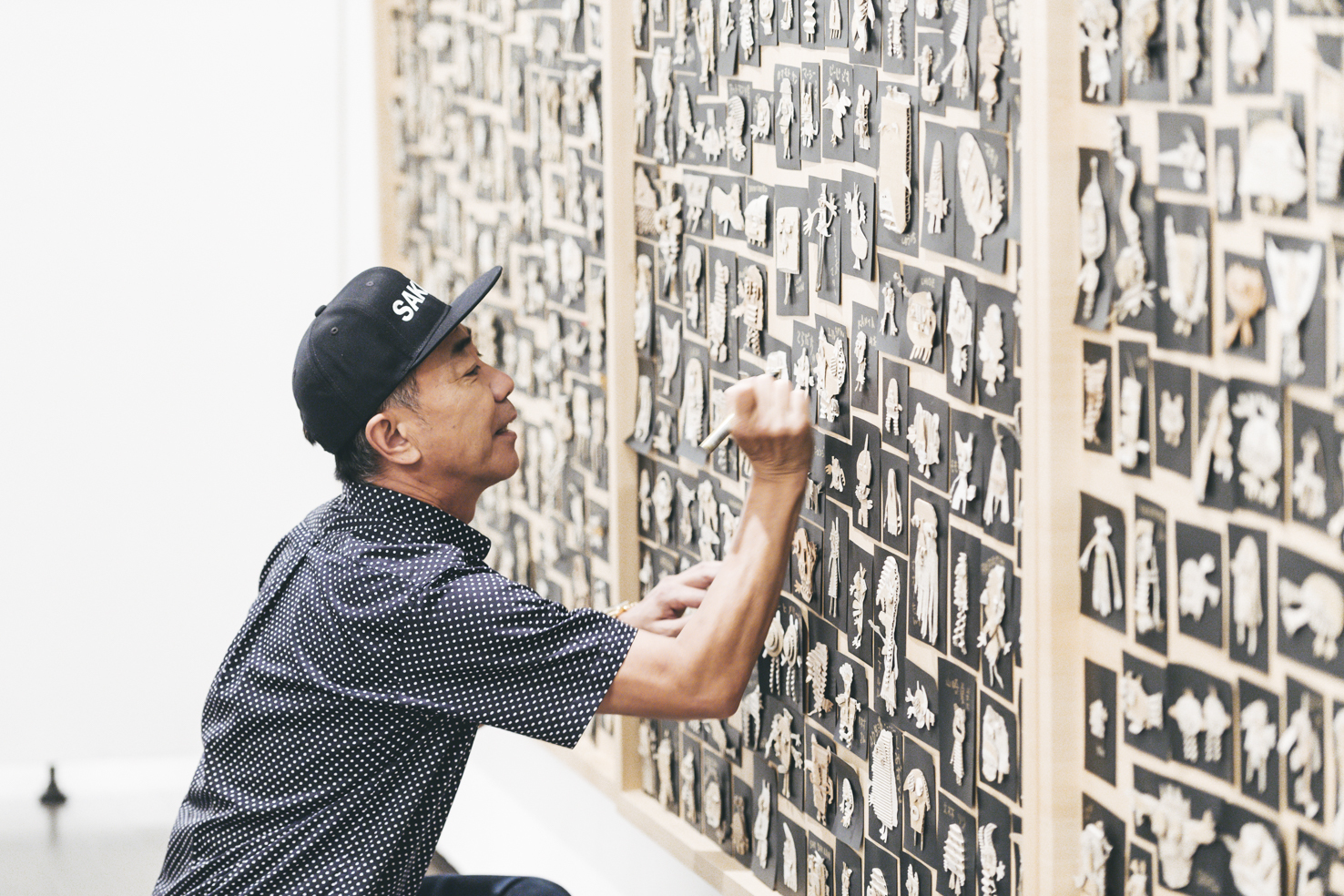
The Ueno Royal Museum in Tokyo has finally returned!
We will hold a Tokyo solo exhibition for the first time in about 6 years since 2014!
I will come back with the work I drew during this time!
Whether you came to the 2014 “Kinashi Noritake Exhibition x 20years” or not, please come and visit us before the Olympics.
We are waiting for you to finish the exhibition that everyone can enjoy! !
——————————
Profile: Noritake Kinashi
Born in Tokyo in 1962
While he is active as a tornado, he also has an atelier and works as a painter.
Held nine solo exhibitions in Japan since the first solo exhibition “Taiyo Niconica Exhibition” held in Nagoya City, Aichi Prefecture in 1994 under the name of “Kinashi Kentaro”.
A total of 30 venues。
He has also been successful in two overseas exhibitions in New York, USA (2015) and London, UK (2018).
——————————
[Summary]
□ Title Noritake Kinashi Exhibition Timing-Light of the Moment-
□ Date: May 29 (Fri)-June 21 (Sun), 2020 * Open daily
□ Venue The Ueno Royal Museum
(Location: 1-2 Ueno Park, Taito-ku, Tokyo 110-0007)
□ Opening hours 10: 00-17: 00 (Admission until 30 minutes before closing)
□ Admission fee General 1,600 yen (1,400 yen)
University / vocational school / high school student 1,400 yen (1,200 yen)
Elementary and junior high school students 800 yen (600 yen)
* Free for elementary school students
* Prices in parentheses are for advance sales and for groups of 20 or more.
* Free for persons with disability certificates and one caregiver (certification required)
* Ticket details will be released on the official website
□ Hosted by Sankei Shimbun, imuraart gallery, Ueno Forest Museum
□ Special cooperation Kokka
□ Support Sony Music Entertainment, Nozaki Printing Paper
□ Official HP http://www.kinashiten.com/
□ Official SNS Instagram, Twitter, Facebook: @kinashiten

● Special Advance Ticket Release! / Release date: February 14, 2020 (Fri) 10:00 am
(1) Weekday limited pair ticket 2,500 yen (tax included) [Limited quantity sale]
Limited pair ticket that can be visited only on weekdays.
700 yen less than the day ticket!
[Sales Play Guide] Suma Chike, e +, Pia, Lo Chike, CN Play Guide, Seven Ticket, Rakuten Ticket, Yahoo! Ticket
(2) Ticket with original Mackie 1,600 yen (tax included) [Limited time sale from February 14 to March 13]
The original design of the exhibition of the oily marker “Mackey”, which is also used for work creation, appears!
* Please exchange the original Mackie at the shop in the venue during the exhibition.
Exchanges cannot be made outside of the Tokyo venue.
* After the Tokyo venue, the original Mackie will be released for 350 yen (excluding tax) at the shop inside the venue.
[Sales Play Guide] e +、Pia、Rochike
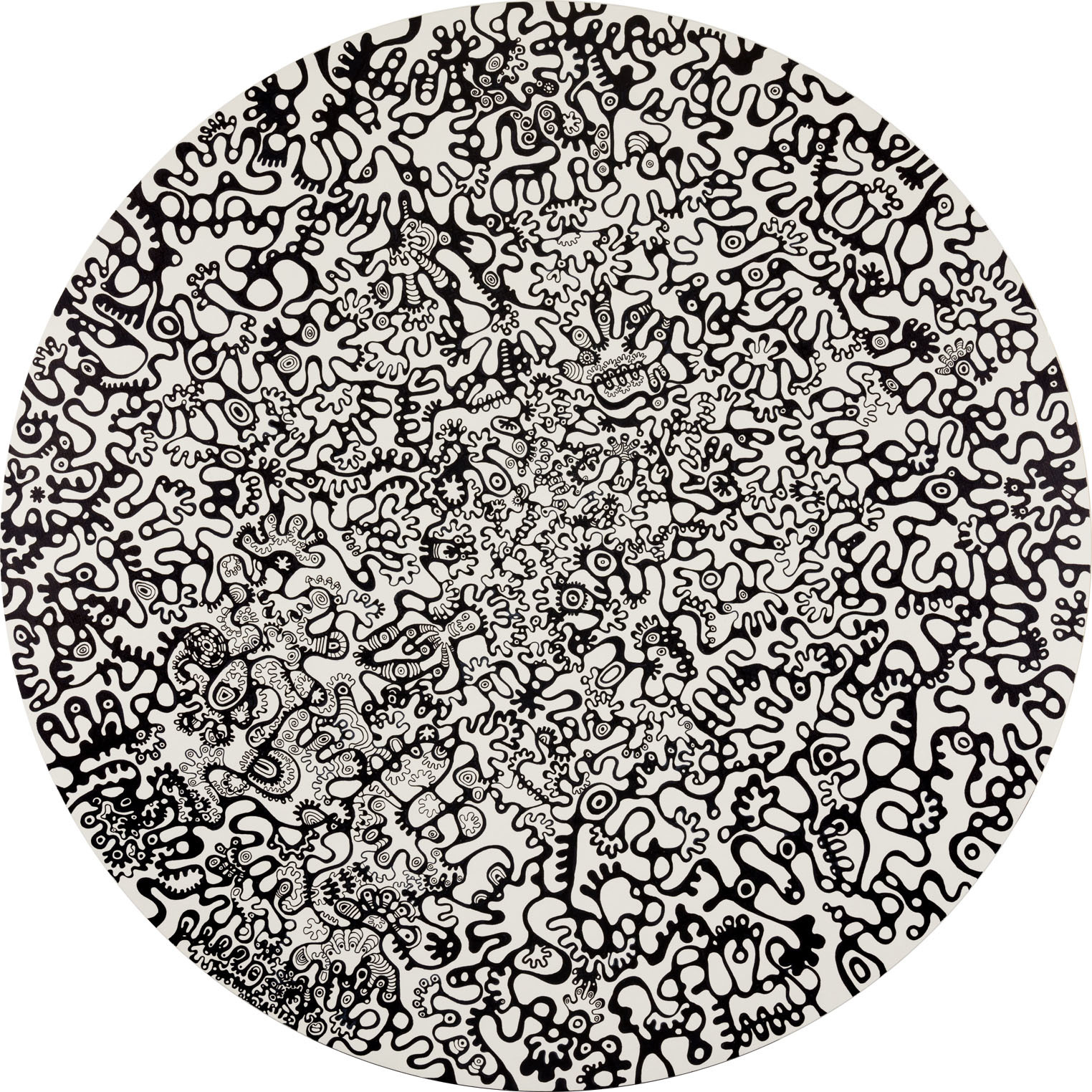
(3) “Thank you” ticket with special canvas art 6,000 yen (tax included) [Limited quantity sale]
e + (e plus) only!
Popular work “Thanks” becomes canvas art (not for sale)
Limited special plan!
※ Please exchange canvas art at the shop in the venue during the exhibition.
Exchanges cannot be made outside of the Tokyo venue.

(4) Official work collection ticket 3,300 yen (tax included) [Limited sale]
Lawson ticket only!
This exhibition’s official work collection 2,200 yen (tax included) is about 300 yen discount set
* Please redeem the official work collection at the shop during the exhibition. Redemption is not possible outside of Tokyo.
<Sales Play Guide>
● Official online ticket “Sumachike”
https://eplus.jp/kinashitentokyo-official/
● e + (e plus)
https://eplus.jp/kinashitentokyo/
[Over-the-counter sales] Family Mart Fami Port
● Ticket Pia
https://w.pia.jp/t/kinashitentokyo/
0570-02-9999 (P code: 685-109)
[Store sales] Seven-Eleven, Ticket Pia stores
● Lawson Ticket
https://l-tike.com/kinashitentokyo/
L code: 32004
0570-000-777 (for operators)
[Store sales] Loppi in Lawson Ministop
● CN Play Guide
http://www.cnplayguide.com/kinashitentokyo/
0570-08-9999 (operator correspondence)
[Over-the-counter sales] Family Mart Fami Port
● Seven Ticket
[Store sales] Seven-Eleven stores nationwide
(In-store multi-copy machine Seven ticket button)
* Seven ticket handling is available only at Seven-Eleven stores
● Rakuten Ticket http://rt.jp/kinashitentokyo
● Yahoo! Ticket http://ry-tickets.jp/kinashitentokyo
● JTB leisure ticket
[Store sales] Seven-Eleven / Lawson / Ministop / FamilyMart
● LINE ticket https://ticket.line.me/sp/kinashitentokyo/
● Advance tickets March 14, 2020 (Sat.) 10:00 am-Sales start!
<Price list>
|
Price (tax included)
|
General
|
University / vocational school / high school student
|
Elementary and junior high school students
|
|
On the day
|
1,600 yen
|
1,400 yen
|
800 yen
|
|
Advance / Group
|
1,400 yen
|
1,200 yen
|
600 yen
|
After the Tokyo exhibition, a new tour of 5 venues has been decided!
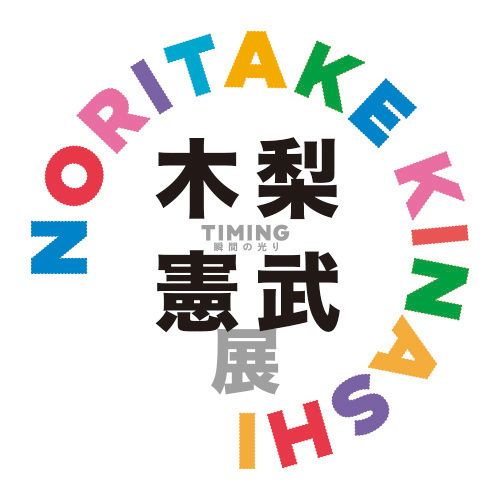
・ October-November 2020 Toyama
・ Tuesday, February 16-Saturday, March 27, 2021 Kyoto Culture Museum
・ April 2, 2021-Sunday, May 9, 2021 Yamagata Prefecture
・ Around June 2021 Tottori Prefecture
・ Around July 2021 Miyazaki
* Details will be announced on the official website.
Article provided by: Kokosil Ueno
See other exhibition information


